Training and Development Programs Analysis
VerifiedAdded on 2020/11/23
|69
|18305
|467
Report
AI Summary
This assignment delves into the impact of training and development programs on employee performance. Students analyze data presented in a table format, including correlations between program participation and knowledge/skill improvement. They interpret statistical models (R-squared, F Change) to assess the significance of training programs' influence. The analysis emphasizes understanding the relationship between training, development, and improved job performance.
Contribute Materials
Your contribution can guide someone’s learning journey. Share your
documents today.
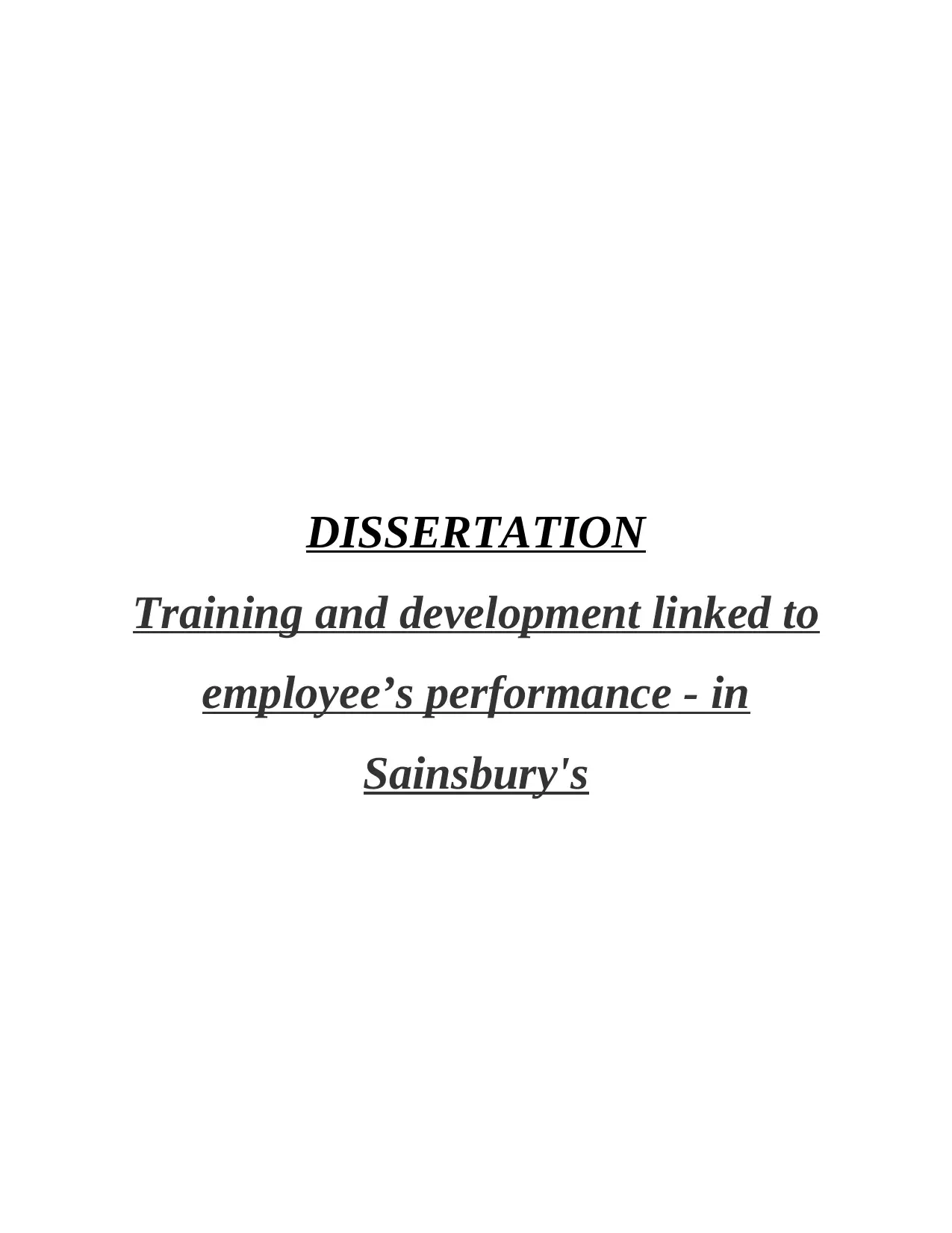
DISSERTATION
Training and development linked to
employee’s performance - in
Sainsbury's
Training and development linked to
employee’s performance - in
Sainsbury's
Secure Best Marks with AI Grader
Need help grading? Try our AI Grader for instant feedback on your assignments.
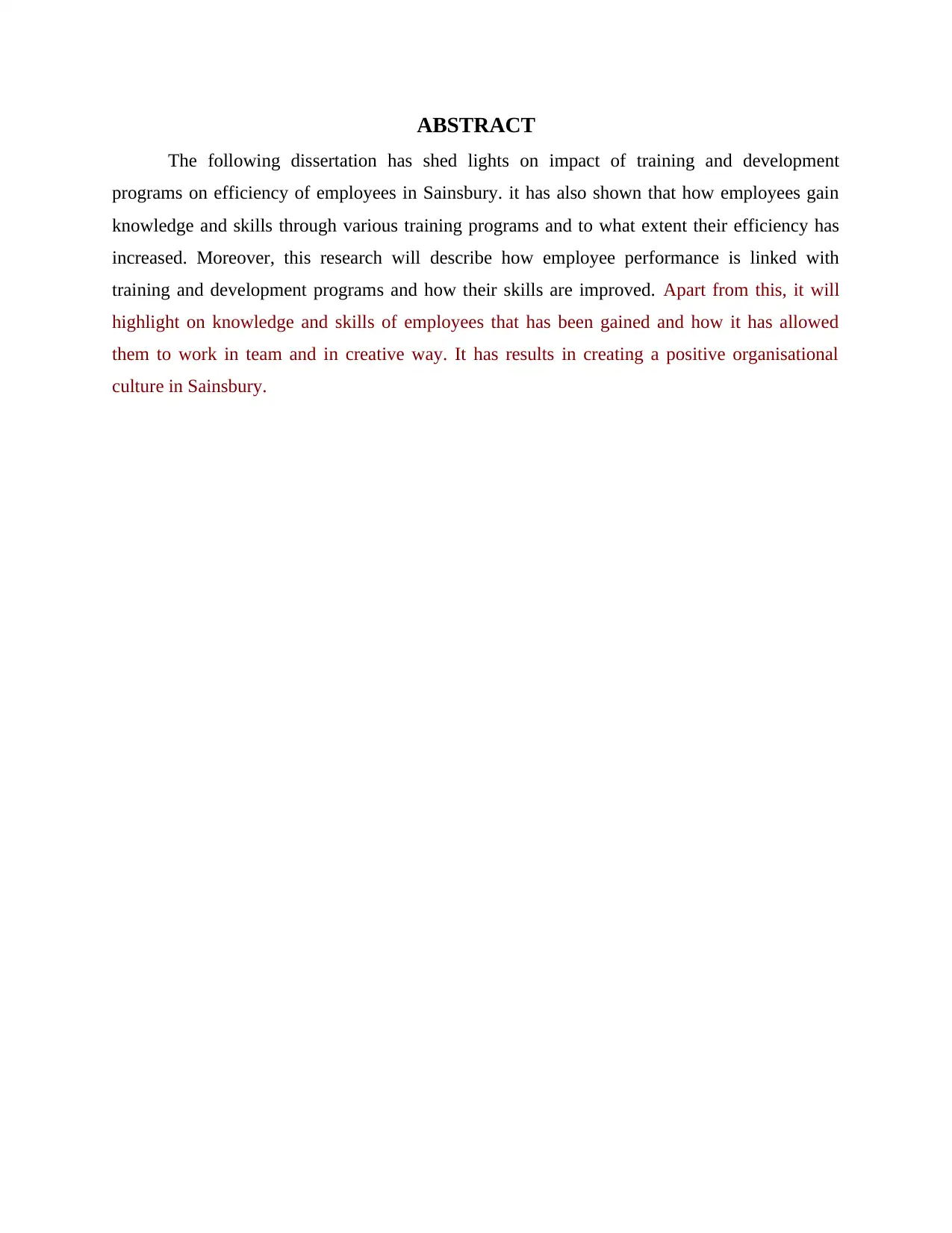
ABSTRACT
The following dissertation has shed lights on impact of training and development
programs on efficiency of employees in Sainsbury. it has also shown that how employees gain
knowledge and skills through various training programs and to what extent their efficiency has
increased. Moreover, this research will describe how employee performance is linked with
training and development programs and how their skills are improved. Apart from this, it will
highlight on knowledge and skills of employees that has been gained and how it has allowed
them to work in team and in creative way. It has results in creating a positive organisational
culture in Sainsbury.
The following dissertation has shed lights on impact of training and development
programs on efficiency of employees in Sainsbury. it has also shown that how employees gain
knowledge and skills through various training programs and to what extent their efficiency has
increased. Moreover, this research will describe how employee performance is linked with
training and development programs and how their skills are improved. Apart from this, it will
highlight on knowledge and skills of employees that has been gained and how it has allowed
them to work in team and in creative way. It has results in creating a positive organisational
culture in Sainsbury.

TABLE OF CONTENTS
RESEARCH TOPIC........................................................................................................................6
CHAPTER- 1 INTRODUCTION....................................................................................................6
Background of the study.........................................................................................................6
Motivation for research..........................................................................................................7
Research Aim.........................................................................................................................7
Research Objective.................................................................................................................8
Research Questions................................................................................................................8
Rationale of the Study............................................................................................................8
Significance of the study........................................................................................................8
Framework and Analysis........................................................................................................9
Chapter Structure..................................................................................................................10
CHAPTER- 2 LITERATURE REVIEW.......................................................................................11
CHAPTER – 3 RESEARCH METHODOLOGY.........................................................................22
Introduction..........................................................................................................................22
Research Philosophy............................................................................................................22
Research approach................................................................................................................23
Research Design...................................................................................................................24
Data collection......................................................................................................................24
Sampling...............................................................................................................................26
Data Analysis........................................................................................................................27
Research Technique..............................................................................................................27
Reliability and validity.........................................................................................................29
Research Limitation..............................................................................................................29
Ethical consideration ...........................................................................................................30
CHAPTER 4 DATA ANALYSIS.................................................................................................32
4.1 Chapter overview............................................................................................................32
4.2 Testing & theory.............................................................................................................32
4.3 Descriptive analysis .......................................................................................................32
Theme 1 Providing training in regular time period enabled in maintaining efficiency.......33
RESEARCH TOPIC........................................................................................................................6
CHAPTER- 1 INTRODUCTION....................................................................................................6
Background of the study.........................................................................................................6
Motivation for research..........................................................................................................7
Research Aim.........................................................................................................................7
Research Objective.................................................................................................................8
Research Questions................................................................................................................8
Rationale of the Study............................................................................................................8
Significance of the study........................................................................................................8
Framework and Analysis........................................................................................................9
Chapter Structure..................................................................................................................10
CHAPTER- 2 LITERATURE REVIEW.......................................................................................11
CHAPTER – 3 RESEARCH METHODOLOGY.........................................................................22
Introduction..........................................................................................................................22
Research Philosophy............................................................................................................22
Research approach................................................................................................................23
Research Design...................................................................................................................24
Data collection......................................................................................................................24
Sampling...............................................................................................................................26
Data Analysis........................................................................................................................27
Research Technique..............................................................................................................27
Reliability and validity.........................................................................................................29
Research Limitation..............................................................................................................29
Ethical consideration ...........................................................................................................30
CHAPTER 4 DATA ANALYSIS.................................................................................................32
4.1 Chapter overview............................................................................................................32
4.2 Testing & theory.............................................................................................................32
4.3 Descriptive analysis .......................................................................................................32
Theme 1 Providing training in regular time period enabled in maintaining efficiency.......33
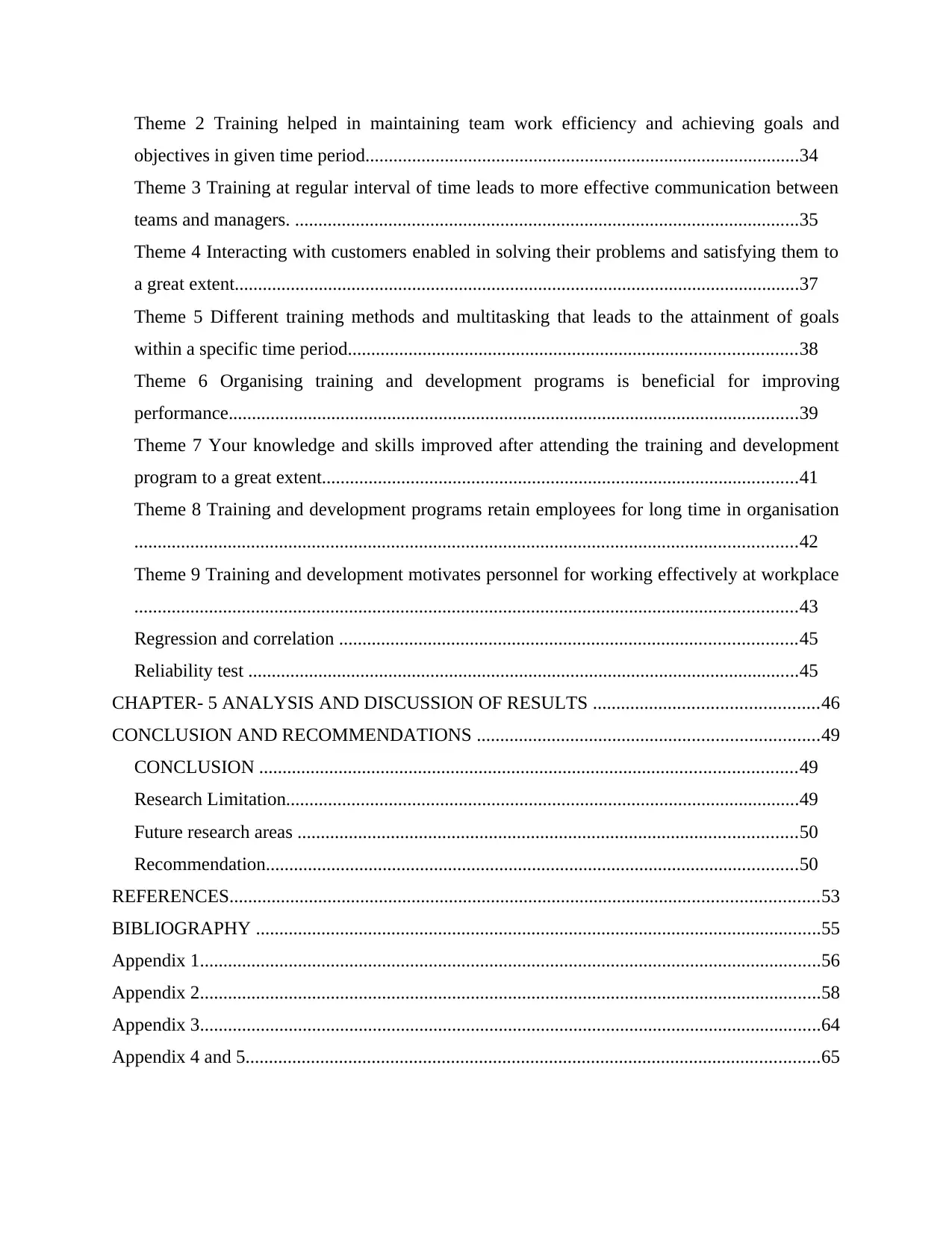
Theme 2 Training helped in maintaining team work efficiency and achieving goals and
objectives in given time period.............................................................................................34
Theme 3 Training at regular interval of time leads to more effective communication between
teams and managers. ............................................................................................................35
Theme 4 Interacting with customers enabled in solving their problems and satisfying them to
a great extent.........................................................................................................................37
Theme 5 Different training methods and multitasking that leads to the attainment of goals
within a specific time period................................................................................................38
Theme 6 Organising training and development programs is beneficial for improving
performance..........................................................................................................................39
Theme 7 Your knowledge and skills improved after attending the training and development
program to a great extent......................................................................................................41
Theme 8 Training and development programs retain employees for long time in organisation
..............................................................................................................................................42
Theme 9 Training and development motivates personnel for working effectively at workplace
..............................................................................................................................................43
Regression and correlation ..................................................................................................45
Reliability test ......................................................................................................................45
CHAPTER- 5 ANALYSIS AND DISCUSSION OF RESULTS ................................................46
CONCLUSION AND RECOMMENDATIONS .........................................................................49
CONCLUSION ...................................................................................................................49
Research Limitation..............................................................................................................49
Future research areas ...........................................................................................................50
Recommendation..................................................................................................................50
REFERENCES..............................................................................................................................53
BIBLIOGRAPHY .........................................................................................................................55
Appendix 1.....................................................................................................................................56
Appendix 2.....................................................................................................................................58
Appendix 3.....................................................................................................................................64
Appendix 4 and 5...........................................................................................................................65
objectives in given time period.............................................................................................34
Theme 3 Training at regular interval of time leads to more effective communication between
teams and managers. ............................................................................................................35
Theme 4 Interacting with customers enabled in solving their problems and satisfying them to
a great extent.........................................................................................................................37
Theme 5 Different training methods and multitasking that leads to the attainment of goals
within a specific time period................................................................................................38
Theme 6 Organising training and development programs is beneficial for improving
performance..........................................................................................................................39
Theme 7 Your knowledge and skills improved after attending the training and development
program to a great extent......................................................................................................41
Theme 8 Training and development programs retain employees for long time in organisation
..............................................................................................................................................42
Theme 9 Training and development motivates personnel for working effectively at workplace
..............................................................................................................................................43
Regression and correlation ..................................................................................................45
Reliability test ......................................................................................................................45
CHAPTER- 5 ANALYSIS AND DISCUSSION OF RESULTS ................................................46
CONCLUSION AND RECOMMENDATIONS .........................................................................49
CONCLUSION ...................................................................................................................49
Research Limitation..............................................................................................................49
Future research areas ...........................................................................................................50
Recommendation..................................................................................................................50
REFERENCES..............................................................................................................................53
BIBLIOGRAPHY .........................................................................................................................55
Appendix 1.....................................................................................................................................56
Appendix 2.....................................................................................................................................58
Appendix 3.....................................................................................................................................64
Appendix 4 and 5...........................................................................................................................65
Secure Best Marks with AI Grader
Need help grading? Try our AI Grader for instant feedback on your assignments.

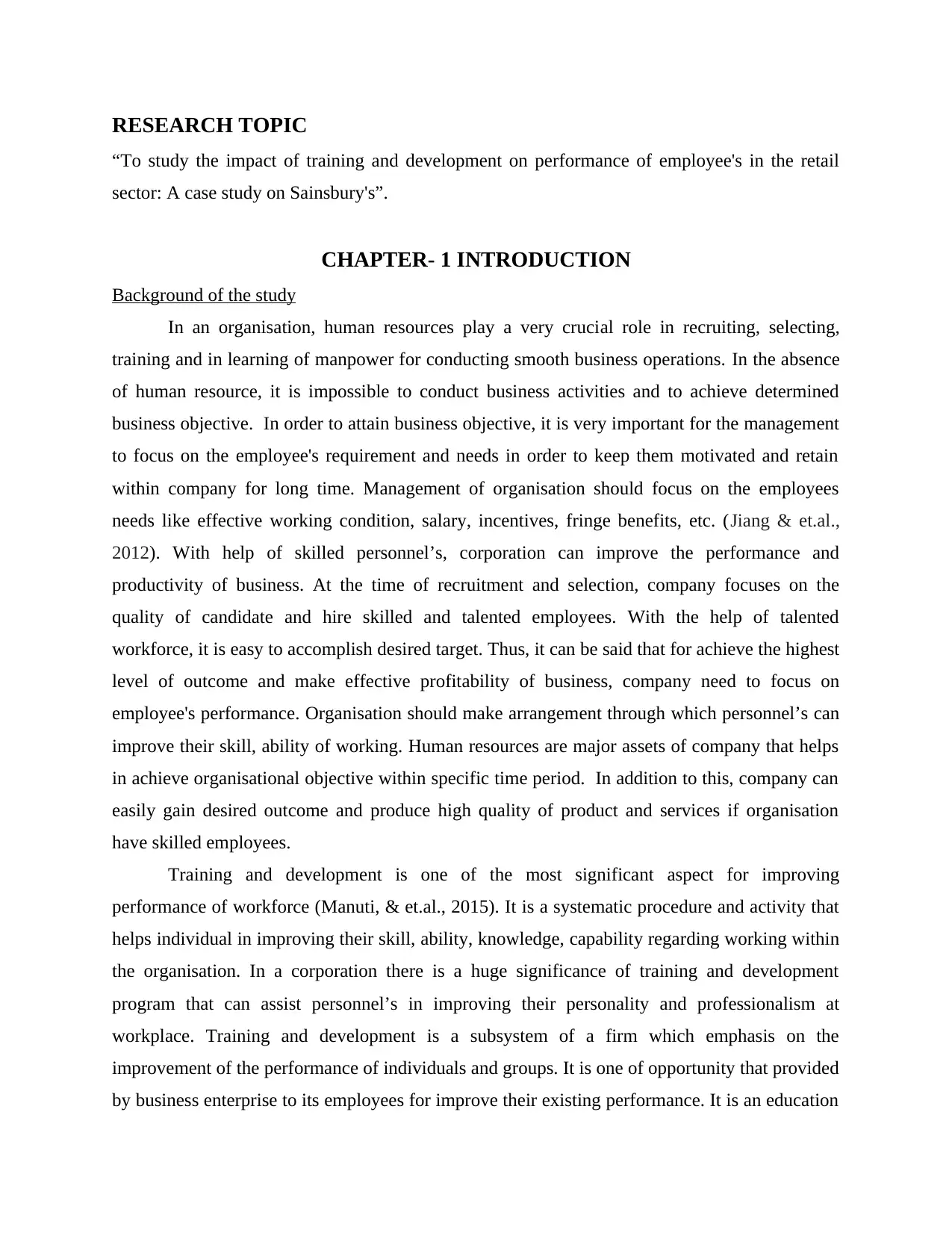
RESEARCH TOPIC
“To study the impact of training and development on performance of employee's in the retail
sector: A case study on Sainsbury's”.
CHAPTER- 1 INTRODUCTION
Background of the study
In an organisation, human resources play a very crucial role in recruiting, selecting,
training and in learning of manpower for conducting smooth business operations. In the absence
of human resource, it is impossible to conduct business activities and to achieve determined
business objective. In order to attain business objective, it is very important for the management
to focus on the employee's requirement and needs in order to keep them motivated and retain
within company for long time. Management of organisation should focus on the employees
needs like effective working condition, salary, incentives, fringe benefits, etc. (Jiang & et.al.,
2012). With help of skilled personnel’s, corporation can improve the performance and
productivity of business. At the time of recruitment and selection, company focuses on the
quality of candidate and hire skilled and talented employees. With the help of talented
workforce, it is easy to accomplish desired target. Thus, it can be said that for achieve the highest
level of outcome and make effective profitability of business, company need to focus on
employee's performance. Organisation should make arrangement through which personnel’s can
improve their skill, ability of working. Human resources are major assets of company that helps
in achieve organisational objective within specific time period. In addition to this, company can
easily gain desired outcome and produce high quality of product and services if organisation
have skilled employees.
Training and development is one of the most significant aspect for improving
performance of workforce (Manuti, & et.al., 2015). It is a systematic procedure and activity that
helps individual in improving their skill, ability, knowledge, capability regarding working within
the organisation. In a corporation there is a huge significance of training and development
program that can assist personnel’s in improving their personality and professionalism at
workplace. Training and development is a subsystem of a firm which emphasis on the
improvement of the performance of individuals and groups. It is one of opportunity that provided
by business enterprise to its employees for improve their existing performance. It is an education
“To study the impact of training and development on performance of employee's in the retail
sector: A case study on Sainsbury's”.
CHAPTER- 1 INTRODUCTION
Background of the study
In an organisation, human resources play a very crucial role in recruiting, selecting,
training and in learning of manpower for conducting smooth business operations. In the absence
of human resource, it is impossible to conduct business activities and to achieve determined
business objective. In order to attain business objective, it is very important for the management
to focus on the employee's requirement and needs in order to keep them motivated and retain
within company for long time. Management of organisation should focus on the employees
needs like effective working condition, salary, incentives, fringe benefits, etc. (Jiang & et.al.,
2012). With help of skilled personnel’s, corporation can improve the performance and
productivity of business. At the time of recruitment and selection, company focuses on the
quality of candidate and hire skilled and talented employees. With the help of talented
workforce, it is easy to accomplish desired target. Thus, it can be said that for achieve the highest
level of outcome and make effective profitability of business, company need to focus on
employee's performance. Organisation should make arrangement through which personnel’s can
improve their skill, ability of working. Human resources are major assets of company that helps
in achieve organisational objective within specific time period. In addition to this, company can
easily gain desired outcome and produce high quality of product and services if organisation
have skilled employees.
Training and development is one of the most significant aspect for improving
performance of workforce (Manuti, & et.al., 2015). It is a systematic procedure and activity that
helps individual in improving their skill, ability, knowledge, capability regarding working within
the organisation. In a corporation there is a huge significance of training and development
program that can assist personnel’s in improving their personality and professionalism at
workplace. Training and development is a subsystem of a firm which emphasis on the
improvement of the performance of individuals and groups. It is one of opportunity that provided
by business enterprise to its employees for improve their existing performance. It is an education
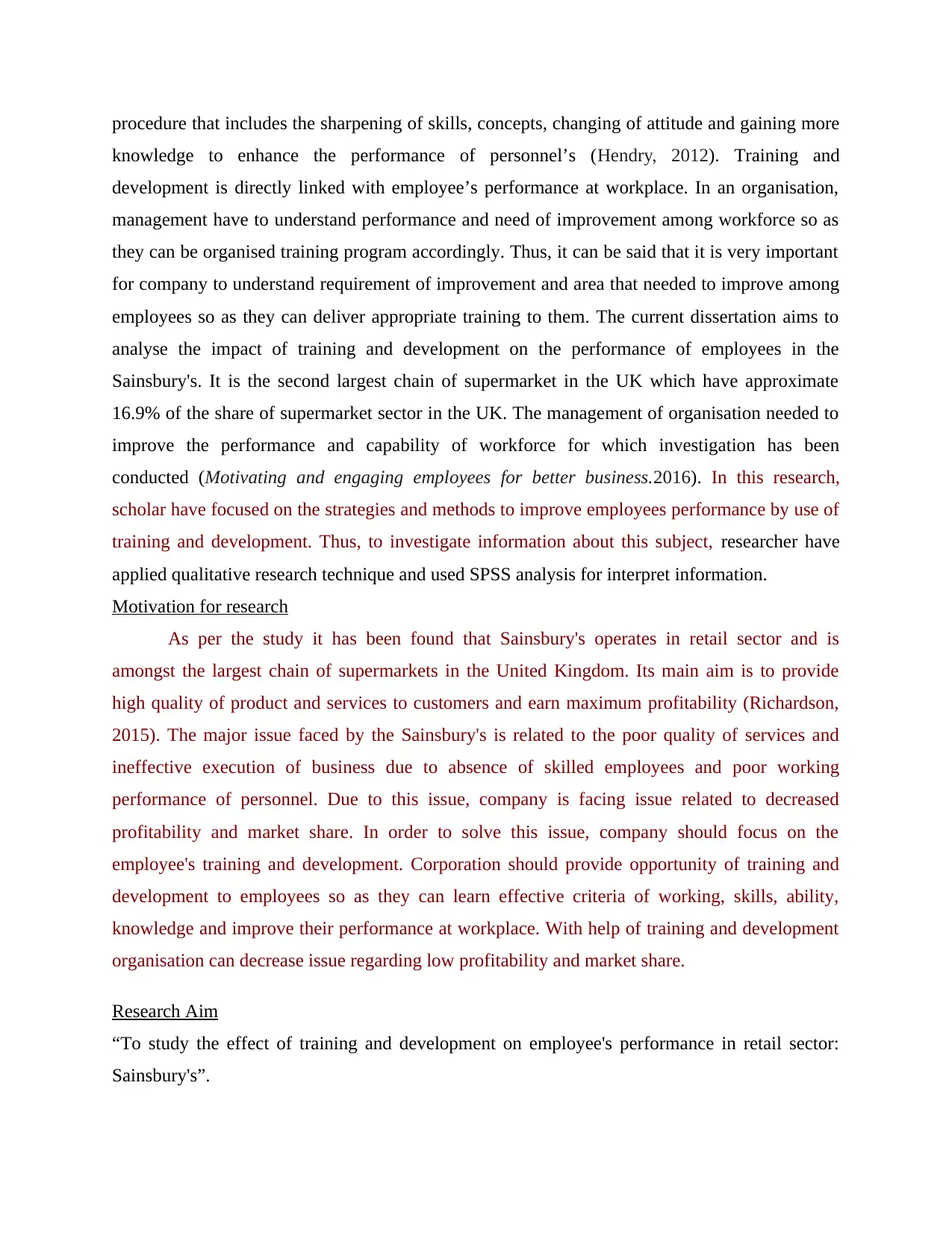
procedure that includes the sharpening of skills, concepts, changing of attitude and gaining more
knowledge to enhance the performance of personnel’s (Hendry, 2012). Training and
development is directly linked with employee’s performance at workplace. In an organisation,
management have to understand performance and need of improvement among workforce so as
they can be organised training program accordingly. Thus, it can be said that it is very important
for company to understand requirement of improvement and area that needed to improve among
employees so as they can deliver appropriate training to them. The current dissertation aims to
analyse the impact of training and development on the performance of employees in the
Sainsbury's. It is the second largest chain of supermarket in the UK which have approximate
16.9% of the share of supermarket sector in the UK. The management of organisation needed to
improve the performance and capability of workforce for which investigation has been
conducted (Motivating and engaging employees for better business.2016). In this research,
scholar have focused on the strategies and methods to improve employees performance by use of
training and development. Thus, to investigate information about this subject, researcher have
applied qualitative research technique and used SPSS analysis for interpret information.
Motivation for research
As per the study it has been found that Sainsbury's operates in retail sector and is
amongst the largest chain of supermarkets in the United Kingdom. Its main aim is to provide
high quality of product and services to customers and earn maximum profitability (Richardson,
2015). The major issue faced by the Sainsbury's is related to the poor quality of services and
ineffective execution of business due to absence of skilled employees and poor working
performance of personnel. Due to this issue, company is facing issue related to decreased
profitability and market share. In order to solve this issue, company should focus on the
employee's training and development. Corporation should provide opportunity of training and
development to employees so as they can learn effective criteria of working, skills, ability,
knowledge and improve their performance at workplace. With help of training and development
organisation can decrease issue regarding low profitability and market share.
Research Aim
“To study the effect of training and development on employee's performance in retail sector:
Sainsbury's”.
knowledge to enhance the performance of personnel’s (Hendry, 2012). Training and
development is directly linked with employee’s performance at workplace. In an organisation,
management have to understand performance and need of improvement among workforce so as
they can be organised training program accordingly. Thus, it can be said that it is very important
for company to understand requirement of improvement and area that needed to improve among
employees so as they can deliver appropriate training to them. The current dissertation aims to
analyse the impact of training and development on the performance of employees in the
Sainsbury's. It is the second largest chain of supermarket in the UK which have approximate
16.9% of the share of supermarket sector in the UK. The management of organisation needed to
improve the performance and capability of workforce for which investigation has been
conducted (Motivating and engaging employees for better business.2016). In this research,
scholar have focused on the strategies and methods to improve employees performance by use of
training and development. Thus, to investigate information about this subject, researcher have
applied qualitative research technique and used SPSS analysis for interpret information.
Motivation for research
As per the study it has been found that Sainsbury's operates in retail sector and is
amongst the largest chain of supermarkets in the United Kingdom. Its main aim is to provide
high quality of product and services to customers and earn maximum profitability (Richardson,
2015). The major issue faced by the Sainsbury's is related to the poor quality of services and
ineffective execution of business due to absence of skilled employees and poor working
performance of personnel. Due to this issue, company is facing issue related to decreased
profitability and market share. In order to solve this issue, company should focus on the
employee's training and development. Corporation should provide opportunity of training and
development to employees so as they can learn effective criteria of working, skills, ability,
knowledge and improve their performance at workplace. With help of training and development
organisation can decrease issue regarding low profitability and market share.
Research Aim
“To study the effect of training and development on employee's performance in retail sector:
Sainsbury's”.
Paraphrase This Document
Need a fresh take? Get an instant paraphrase of this document with our AI Paraphraser
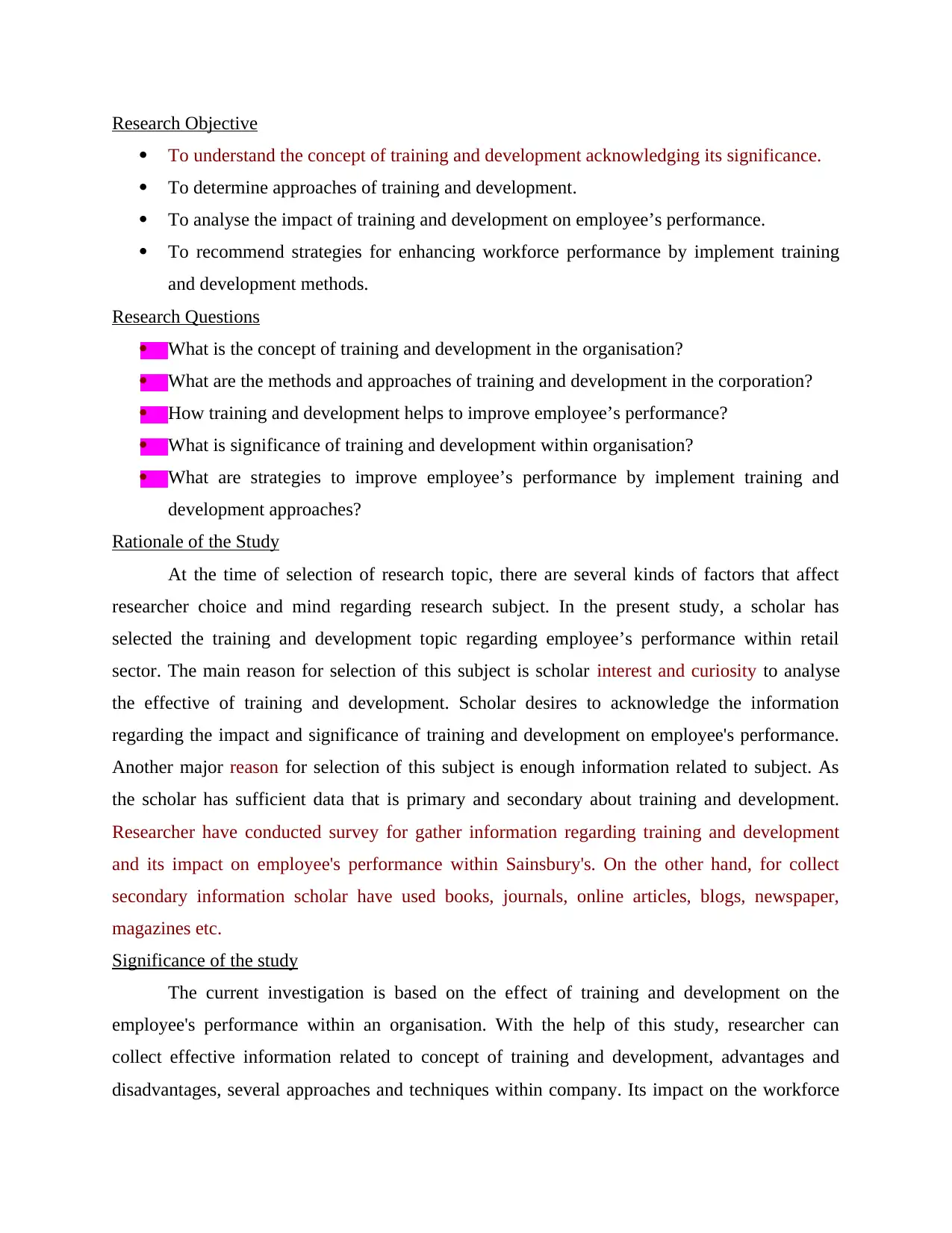
Research Objective
To understand the concept of training and development acknowledging its significance.
To determine approaches of training and development.
To analyse the impact of training and development on employee’s performance.
To recommend strategies for enhancing workforce performance by implement training
and development methods.
Research Questions
What is the concept of training and development in the organisation?
What are the methods and approaches of training and development in the corporation?
How training and development helps to improve employee’s performance?
What is significance of training and development within organisation?
What are strategies to improve employee’s performance by implement training and
development approaches?
Rationale of the Study
At the time of selection of research topic, there are several kinds of factors that affect
researcher choice and mind regarding research subject. In the present study, a scholar has
selected the training and development topic regarding employee’s performance within retail
sector. The main reason for selection of this subject is scholar interest and curiosity to analyse
the effective of training and development. Scholar desires to acknowledge the information
regarding the impact and significance of training and development on employee's performance.
Another major reason for selection of this subject is enough information related to subject. As
the scholar has sufficient data that is primary and secondary about training and development.
Researcher have conducted survey for gather information regarding training and development
and its impact on employee's performance within Sainsbury's. On the other hand, for collect
secondary information scholar have used books, journals, online articles, blogs, newspaper,
magazines etc.
Significance of the study
The current investigation is based on the effect of training and development on the
employee's performance within an organisation. With the help of this study, researcher can
collect effective information related to concept of training and development, advantages and
disadvantages, several approaches and techniques within company. Its impact on the workforce
To understand the concept of training and development acknowledging its significance.
To determine approaches of training and development.
To analyse the impact of training and development on employee’s performance.
To recommend strategies for enhancing workforce performance by implement training
and development methods.
Research Questions
What is the concept of training and development in the organisation?
What are the methods and approaches of training and development in the corporation?
How training and development helps to improve employee’s performance?
What is significance of training and development within organisation?
What are strategies to improve employee’s performance by implement training and
development approaches?
Rationale of the Study
At the time of selection of research topic, there are several kinds of factors that affect
researcher choice and mind regarding research subject. In the present study, a scholar has
selected the training and development topic regarding employee’s performance within retail
sector. The main reason for selection of this subject is scholar interest and curiosity to analyse
the effective of training and development. Scholar desires to acknowledge the information
regarding the impact and significance of training and development on employee's performance.
Another major reason for selection of this subject is enough information related to subject. As
the scholar has sufficient data that is primary and secondary about training and development.
Researcher have conducted survey for gather information regarding training and development
and its impact on employee's performance within Sainsbury's. On the other hand, for collect
secondary information scholar have used books, journals, online articles, blogs, newspaper,
magazines etc.
Significance of the study
The current investigation is based on the effect of training and development on the
employee's performance within an organisation. With the help of this study, researcher can
collect effective information related to concept of training and development, advantages and
disadvantages, several approaches and techniques within company. Its impact on the workforce
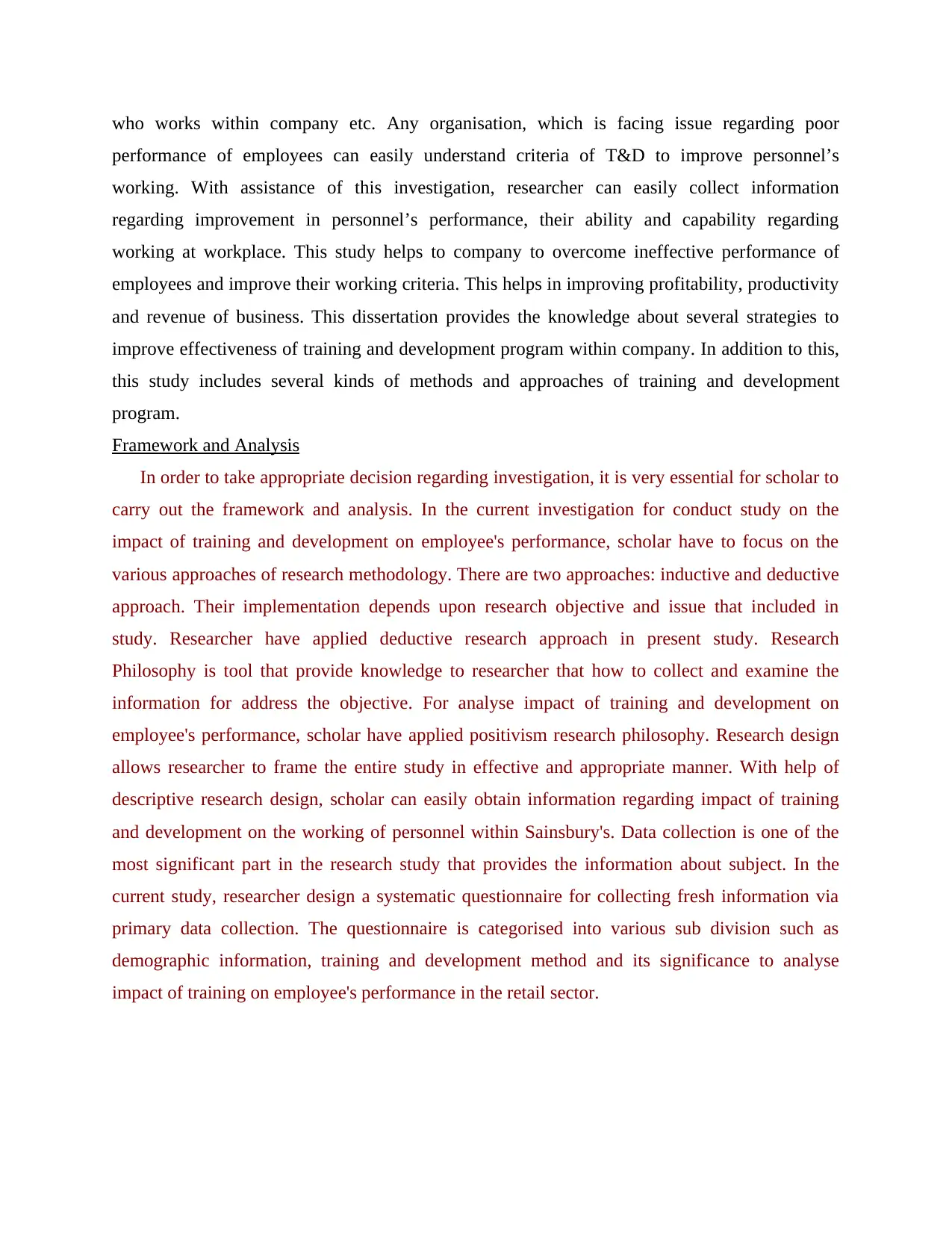
who works within company etc. Any organisation, which is facing issue regarding poor
performance of employees can easily understand criteria of T&D to improve personnel’s
working. With assistance of this investigation, researcher can easily collect information
regarding improvement in personnel’s performance, their ability and capability regarding
working at workplace. This study helps to company to overcome ineffective performance of
employees and improve their working criteria. This helps in improving profitability, productivity
and revenue of business. This dissertation provides the knowledge about several strategies to
improve effectiveness of training and development program within company. In addition to this,
this study includes several kinds of methods and approaches of training and development
program.
Framework and Analysis
In order to take appropriate decision regarding investigation, it is very essential for scholar to
carry out the framework and analysis. In the current investigation for conduct study on the
impact of training and development on employee's performance, scholar have to focus on the
various approaches of research methodology. There are two approaches: inductive and deductive
approach. Their implementation depends upon research objective and issue that included in
study. Researcher have applied deductive research approach in present study. Research
Philosophy is tool that provide knowledge to researcher that how to collect and examine the
information for address the objective. For analyse impact of training and development on
employee's performance, scholar have applied positivism research philosophy. Research design
allows researcher to frame the entire study in effective and appropriate manner. With help of
descriptive research design, scholar can easily obtain information regarding impact of training
and development on the working of personnel within Sainsbury's. Data collection is one of the
most significant part in the research study that provides the information about subject. In the
current study, researcher design a systematic questionnaire for collecting fresh information via
primary data collection. The questionnaire is categorised into various sub division such as
demographic information, training and development method and its significance to analyse
impact of training on employee's performance in the retail sector.
performance of employees can easily understand criteria of T&D to improve personnel’s
working. With assistance of this investigation, researcher can easily collect information
regarding improvement in personnel’s performance, their ability and capability regarding
working at workplace. This study helps to company to overcome ineffective performance of
employees and improve their working criteria. This helps in improving profitability, productivity
and revenue of business. This dissertation provides the knowledge about several strategies to
improve effectiveness of training and development program within company. In addition to this,
this study includes several kinds of methods and approaches of training and development
program.
Framework and Analysis
In order to take appropriate decision regarding investigation, it is very essential for scholar to
carry out the framework and analysis. In the current investigation for conduct study on the
impact of training and development on employee's performance, scholar have to focus on the
various approaches of research methodology. There are two approaches: inductive and deductive
approach. Their implementation depends upon research objective and issue that included in
study. Researcher have applied deductive research approach in present study. Research
Philosophy is tool that provide knowledge to researcher that how to collect and examine the
information for address the objective. For analyse impact of training and development on
employee's performance, scholar have applied positivism research philosophy. Research design
allows researcher to frame the entire study in effective and appropriate manner. With help of
descriptive research design, scholar can easily obtain information regarding impact of training
and development on the working of personnel within Sainsbury's. Data collection is one of the
most significant part in the research study that provides the information about subject. In the
current study, researcher design a systematic questionnaire for collecting fresh information via
primary data collection. The questionnaire is categorised into various sub division such as
demographic information, training and development method and its significance to analyse
impact of training on employee's performance in the retail sector.
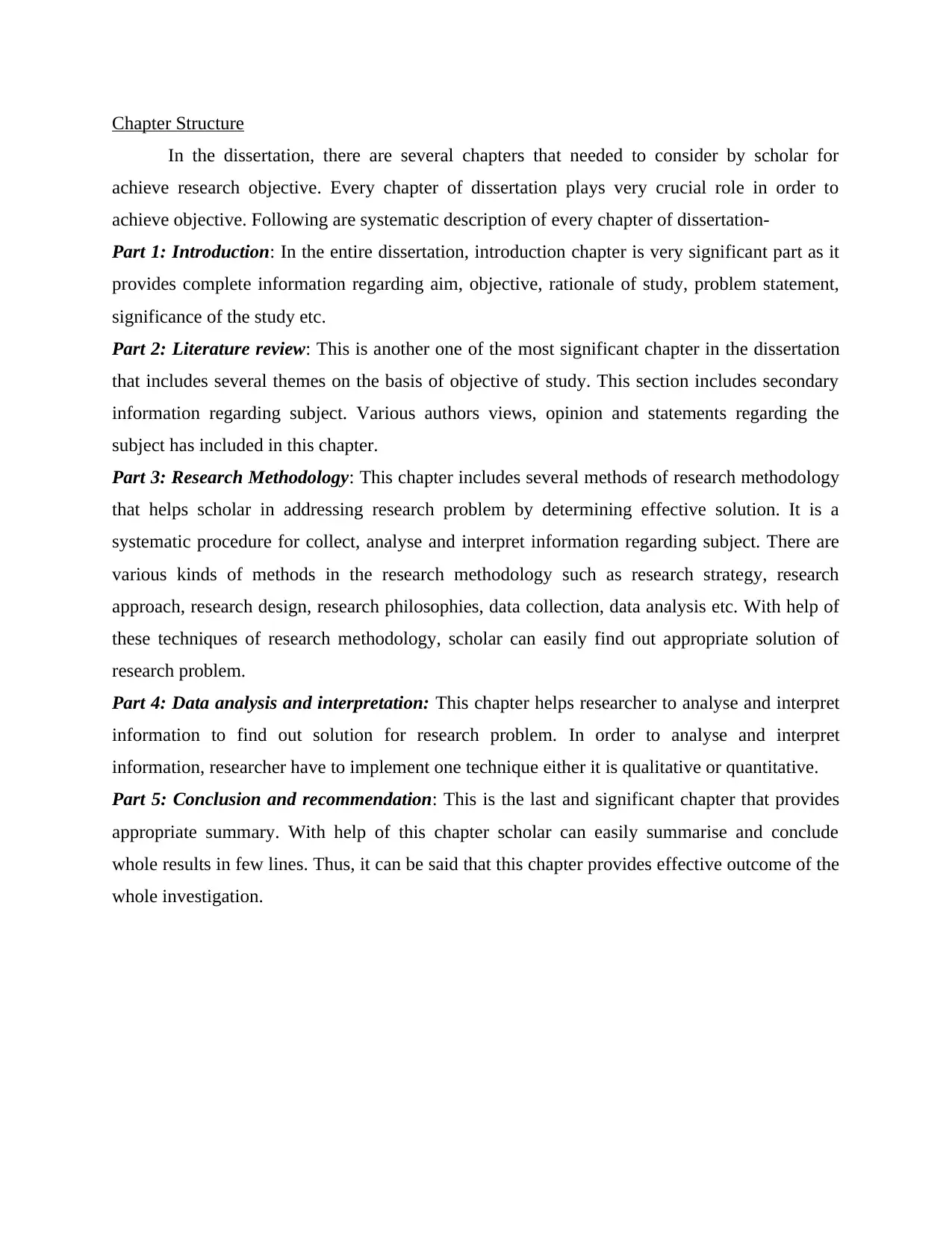
Chapter Structure
In the dissertation, there are several chapters that needed to consider by scholar for
achieve research objective. Every chapter of dissertation plays very crucial role in order to
achieve objective. Following are systematic description of every chapter of dissertation-
Part 1: Introduction: In the entire dissertation, introduction chapter is very significant part as it
provides complete information regarding aim, objective, rationale of study, problem statement,
significance of the study etc.
Part 2: Literature review: This is another one of the most significant chapter in the dissertation
that includes several themes on the basis of objective of study. This section includes secondary
information regarding subject. Various authors views, opinion and statements regarding the
subject has included in this chapter.
Part 3: Research Methodology: This chapter includes several methods of research methodology
that helps scholar in addressing research problem by determining effective solution. It is a
systematic procedure for collect, analyse and interpret information regarding subject. There are
various kinds of methods in the research methodology such as research strategy, research
approach, research design, research philosophies, data collection, data analysis etc. With help of
these techniques of research methodology, scholar can easily find out appropriate solution of
research problem.
Part 4: Data analysis and interpretation: This chapter helps researcher to analyse and interpret
information to find out solution for research problem. In order to analyse and interpret
information, researcher have to implement one technique either it is qualitative or quantitative.
Part 5: Conclusion and recommendation: This is the last and significant chapter that provides
appropriate summary. With help of this chapter scholar can easily summarise and conclude
whole results in few lines. Thus, it can be said that this chapter provides effective outcome of the
whole investigation.
In the dissertation, there are several chapters that needed to consider by scholar for
achieve research objective. Every chapter of dissertation plays very crucial role in order to
achieve objective. Following are systematic description of every chapter of dissertation-
Part 1: Introduction: In the entire dissertation, introduction chapter is very significant part as it
provides complete information regarding aim, objective, rationale of study, problem statement,
significance of the study etc.
Part 2: Literature review: This is another one of the most significant chapter in the dissertation
that includes several themes on the basis of objective of study. This section includes secondary
information regarding subject. Various authors views, opinion and statements regarding the
subject has included in this chapter.
Part 3: Research Methodology: This chapter includes several methods of research methodology
that helps scholar in addressing research problem by determining effective solution. It is a
systematic procedure for collect, analyse and interpret information regarding subject. There are
various kinds of methods in the research methodology such as research strategy, research
approach, research design, research philosophies, data collection, data analysis etc. With help of
these techniques of research methodology, scholar can easily find out appropriate solution of
research problem.
Part 4: Data analysis and interpretation: This chapter helps researcher to analyse and interpret
information to find out solution for research problem. In order to analyse and interpret
information, researcher have to implement one technique either it is qualitative or quantitative.
Part 5: Conclusion and recommendation: This is the last and significant chapter that provides
appropriate summary. With help of this chapter scholar can easily summarise and conclude
whole results in few lines. Thus, it can be said that this chapter provides effective outcome of the
whole investigation.
Secure Best Marks with AI Grader
Need help grading? Try our AI Grader for instant feedback on your assignments.

CHAPTER- 2 LITERATURE REVIEW
Introduction
Human resources are pillar of organisation who carries various functions and activities of
business in order to achieve specific objective. There are various functional department in the
organisation such as marketing, human resource, administration, marketing, information
technology, etc. Employees plays a great role in each functional department for carrying out
business functions. Thus, it is very significant for management to maintain, motivate and
encourage workforce in way that they can retain within firm for long time and perform their
responsibility in excellent manner.
Literature review chapter in the entire dissertation is very important because it gives deep
knowledge and understanding about aim and objective. It includes several themes regarding the
subject and each theme constructs according to research objective. With help of literature review
chapter, researcher can collect secondary information by use of articles, journals, books,
magazines, newspaper etc. Secondary information is published data that have been used by
investigators in their study. In the current study, scholar have used various articles, blogs, books
and journal for collect information about training and development and its impact upon
employee’s performance. This chapter provides knowledge and information that how training
and development helps retail organisation in improving employee’s performance and
productivity. Following are several themes that developed according to research objectives-
Concept of Training and Development
In the opinion of Purce, (2014) Training is any learning activity that considered on
acquiring specific knowledge, skill required for a particular job and task. It faces an immediate
challenge and teaches the knowledge or skills required by company employees in the short
period. On the other hand, development considers to be a long term learning process. In this
procedure of development, human resource manager focuses on the strategy to put in place over
several months or years. Training is a program organised by the corporation to develop
knowledge and skill among personnel’s according to requirement of job. On the other hand,
development is a well-structured program in which the employees can improve their overall
personality and professionalism.
Introduction
Human resources are pillar of organisation who carries various functions and activities of
business in order to achieve specific objective. There are various functional department in the
organisation such as marketing, human resource, administration, marketing, information
technology, etc. Employees plays a great role in each functional department for carrying out
business functions. Thus, it is very significant for management to maintain, motivate and
encourage workforce in way that they can retain within firm for long time and perform their
responsibility in excellent manner.
Literature review chapter in the entire dissertation is very important because it gives deep
knowledge and understanding about aim and objective. It includes several themes regarding the
subject and each theme constructs according to research objective. With help of literature review
chapter, researcher can collect secondary information by use of articles, journals, books,
magazines, newspaper etc. Secondary information is published data that have been used by
investigators in their study. In the current study, scholar have used various articles, blogs, books
and journal for collect information about training and development and its impact upon
employee’s performance. This chapter provides knowledge and information that how training
and development helps retail organisation in improving employee’s performance and
productivity. Following are several themes that developed according to research objectives-
Concept of Training and Development
In the opinion of Purce, (2014) Training is any learning activity that considered on
acquiring specific knowledge, skill required for a particular job and task. It faces an immediate
challenge and teaches the knowledge or skills required by company employees in the short
period. On the other hand, development considers to be a long term learning process. In this
procedure of development, human resource manager focuses on the strategy to put in place over
several months or years. Training is a program organised by the corporation to develop
knowledge and skill among personnel’s according to requirement of job. On the other hand,
development is a well-structured program in which the employees can improve their overall
personality and professionalism.
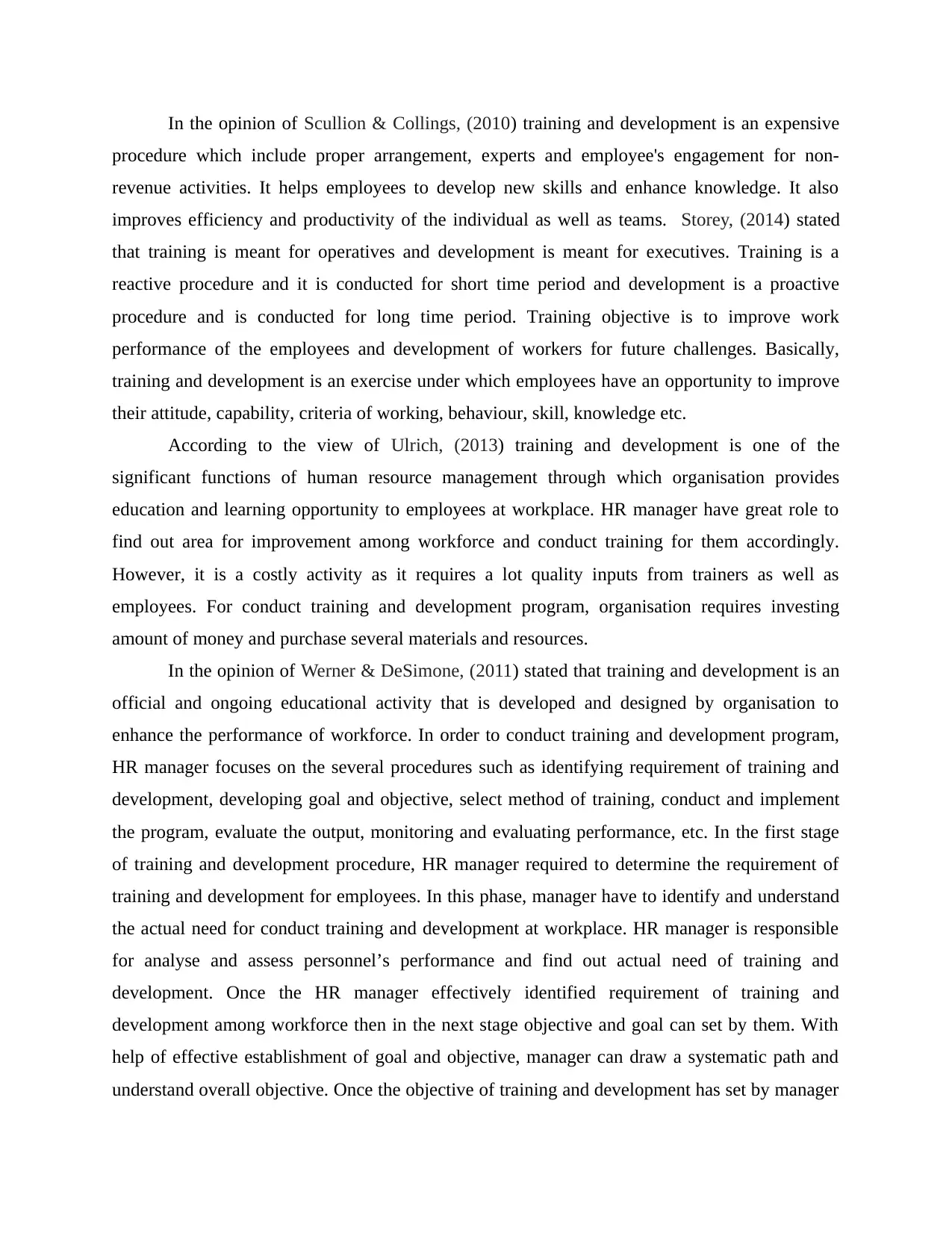
In the opinion of Scullion & Collings, (2010) training and development is an expensive
procedure which include proper arrangement, experts and employee's engagement for non-
revenue activities. It helps employees to develop new skills and enhance knowledge. It also
improves efficiency and productivity of the individual as well as teams. Storey, (2014) stated
that training is meant for operatives and development is meant for executives. Training is a
reactive procedure and it is conducted for short time period and development is a proactive
procedure and is conducted for long time period. Training objective is to improve work
performance of the employees and development of workers for future challenges. Basically,
training and development is an exercise under which employees have an opportunity to improve
their attitude, capability, criteria of working, behaviour, skill, knowledge etc.
According to the view of Ulrich, (2013) training and development is one of the
significant functions of human resource management through which organisation provides
education and learning opportunity to employees at workplace. HR manager have great role to
find out area for improvement among workforce and conduct training for them accordingly.
However, it is a costly activity as it requires a lot quality inputs from trainers as well as
employees. For conduct training and development program, organisation requires investing
amount of money and purchase several materials and resources.
In the opinion of Werner & DeSimone, (2011) stated that training and development is an
official and ongoing educational activity that is developed and designed by organisation to
enhance the performance of workforce. In order to conduct training and development program,
HR manager focuses on the several procedures such as identifying requirement of training and
development, developing goal and objective, select method of training, conduct and implement
the program, evaluate the output, monitoring and evaluating performance, etc. In the first stage
of training and development procedure, HR manager required to determine the requirement of
training and development for employees. In this phase, manager have to identify and understand
the actual need for conduct training and development at workplace. HR manager is responsible
for analyse and assess personnel’s performance and find out actual need of training and
development. Once the HR manager effectively identified requirement of training and
development among workforce then in the next stage objective and goal can set by them. With
help of effective establishment of goal and objective, manager can draw a systematic path and
understand overall objective. Once the objective of training and development has set by manager
procedure which include proper arrangement, experts and employee's engagement for non-
revenue activities. It helps employees to develop new skills and enhance knowledge. It also
improves efficiency and productivity of the individual as well as teams. Storey, (2014) stated
that training is meant for operatives and development is meant for executives. Training is a
reactive procedure and it is conducted for short time period and development is a proactive
procedure and is conducted for long time period. Training objective is to improve work
performance of the employees and development of workers for future challenges. Basically,
training and development is an exercise under which employees have an opportunity to improve
their attitude, capability, criteria of working, behaviour, skill, knowledge etc.
According to the view of Ulrich, (2013) training and development is one of the
significant functions of human resource management through which organisation provides
education and learning opportunity to employees at workplace. HR manager have great role to
find out area for improvement among workforce and conduct training for them accordingly.
However, it is a costly activity as it requires a lot quality inputs from trainers as well as
employees. For conduct training and development program, organisation requires investing
amount of money and purchase several materials and resources.
In the opinion of Werner & DeSimone, (2011) stated that training and development is an
official and ongoing educational activity that is developed and designed by organisation to
enhance the performance of workforce. In order to conduct training and development program,
HR manager focuses on the several procedures such as identifying requirement of training and
development, developing goal and objective, select method of training, conduct and implement
the program, evaluate the output, monitoring and evaluating performance, etc. In the first stage
of training and development procedure, HR manager required to determine the requirement of
training and development for employees. In this phase, manager have to identify and understand
the actual need for conduct training and development at workplace. HR manager is responsible
for analyse and assess personnel’s performance and find out actual need of training and
development. Once the HR manager effectively identified requirement of training and
development among workforce then in the next stage objective and goal can set by them. With
help of effective establishment of goal and objective, manager can draw a systematic path and
understand overall objective. Once the objective of training and development has set by manager
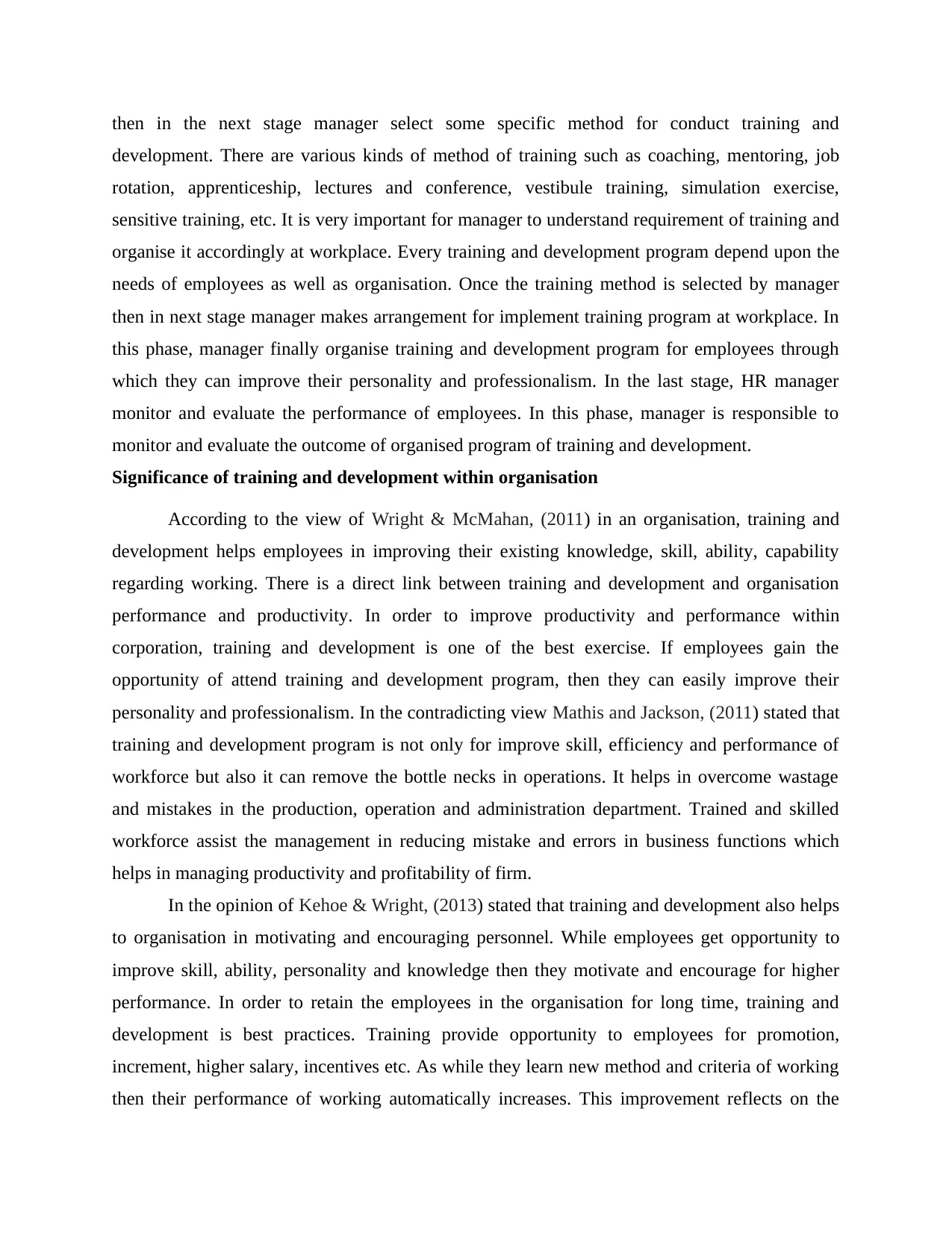
then in the next stage manager select some specific method for conduct training and
development. There are various kinds of method of training such as coaching, mentoring, job
rotation, apprenticeship, lectures and conference, vestibule training, simulation exercise,
sensitive training, etc. It is very important for manager to understand requirement of training and
organise it accordingly at workplace. Every training and development program depend upon the
needs of employees as well as organisation. Once the training method is selected by manager
then in next stage manager makes arrangement for implement training program at workplace. In
this phase, manager finally organise training and development program for employees through
which they can improve their personality and professionalism. In the last stage, HR manager
monitor and evaluate the performance of employees. In this phase, manager is responsible to
monitor and evaluate the outcome of organised program of training and development.
Significance of training and development within organisation
According to the view of Wright & McMahan, (2011) in an organisation, training and
development helps employees in improving their existing knowledge, skill, ability, capability
regarding working. There is a direct link between training and development and organisation
performance and productivity. In order to improve productivity and performance within
corporation, training and development is one of the best exercise. If employees gain the
opportunity of attend training and development program, then they can easily improve their
personality and professionalism. In the contradicting view Mathis and Jackson, (2011) stated that
training and development program is not only for improve skill, efficiency and performance of
workforce but also it can remove the bottle necks in operations. It helps in overcome wastage
and mistakes in the production, operation and administration department. Trained and skilled
workforce assist the management in reducing mistake and errors in business functions which
helps in managing productivity and profitability of firm.
In the opinion of Kehoe & Wright, (2013) stated that training and development also helps
to organisation in motivating and encouraging personnel. While employees get opportunity to
improve skill, ability, personality and knowledge then they motivate and encourage for higher
performance. In order to retain the employees in the organisation for long time, training and
development is best practices. Training provide opportunity to employees for promotion,
increment, higher salary, incentives etc. As while they learn new method and criteria of working
then their performance of working automatically increases. This improvement reflects on the
development. There are various kinds of method of training such as coaching, mentoring, job
rotation, apprenticeship, lectures and conference, vestibule training, simulation exercise,
sensitive training, etc. It is very important for manager to understand requirement of training and
organise it accordingly at workplace. Every training and development program depend upon the
needs of employees as well as organisation. Once the training method is selected by manager
then in next stage manager makes arrangement for implement training program at workplace. In
this phase, manager finally organise training and development program for employees through
which they can improve their personality and professionalism. In the last stage, HR manager
monitor and evaluate the performance of employees. In this phase, manager is responsible to
monitor and evaluate the outcome of organised program of training and development.
Significance of training and development within organisation
According to the view of Wright & McMahan, (2011) in an organisation, training and
development helps employees in improving their existing knowledge, skill, ability, capability
regarding working. There is a direct link between training and development and organisation
performance and productivity. In order to improve productivity and performance within
corporation, training and development is one of the best exercise. If employees gain the
opportunity of attend training and development program, then they can easily improve their
personality and professionalism. In the contradicting view Mathis and Jackson, (2011) stated that
training and development program is not only for improve skill, efficiency and performance of
workforce but also it can remove the bottle necks in operations. It helps in overcome wastage
and mistakes in the production, operation and administration department. Trained and skilled
workforce assist the management in reducing mistake and errors in business functions which
helps in managing productivity and profitability of firm.
In the opinion of Kehoe & Wright, (2013) stated that training and development also helps
to organisation in motivating and encouraging personnel. While employees get opportunity to
improve skill, ability, personality and knowledge then they motivate and encourage for higher
performance. In order to retain the employees in the organisation for long time, training and
development is best practices. Training provide opportunity to employees for promotion,
increment, higher salary, incentives etc. As while they learn new method and criteria of working
then their performance of working automatically increases. This improvement reflects on the
Paraphrase This Document
Need a fresh take? Get an instant paraphrase of this document with our AI Paraphraser
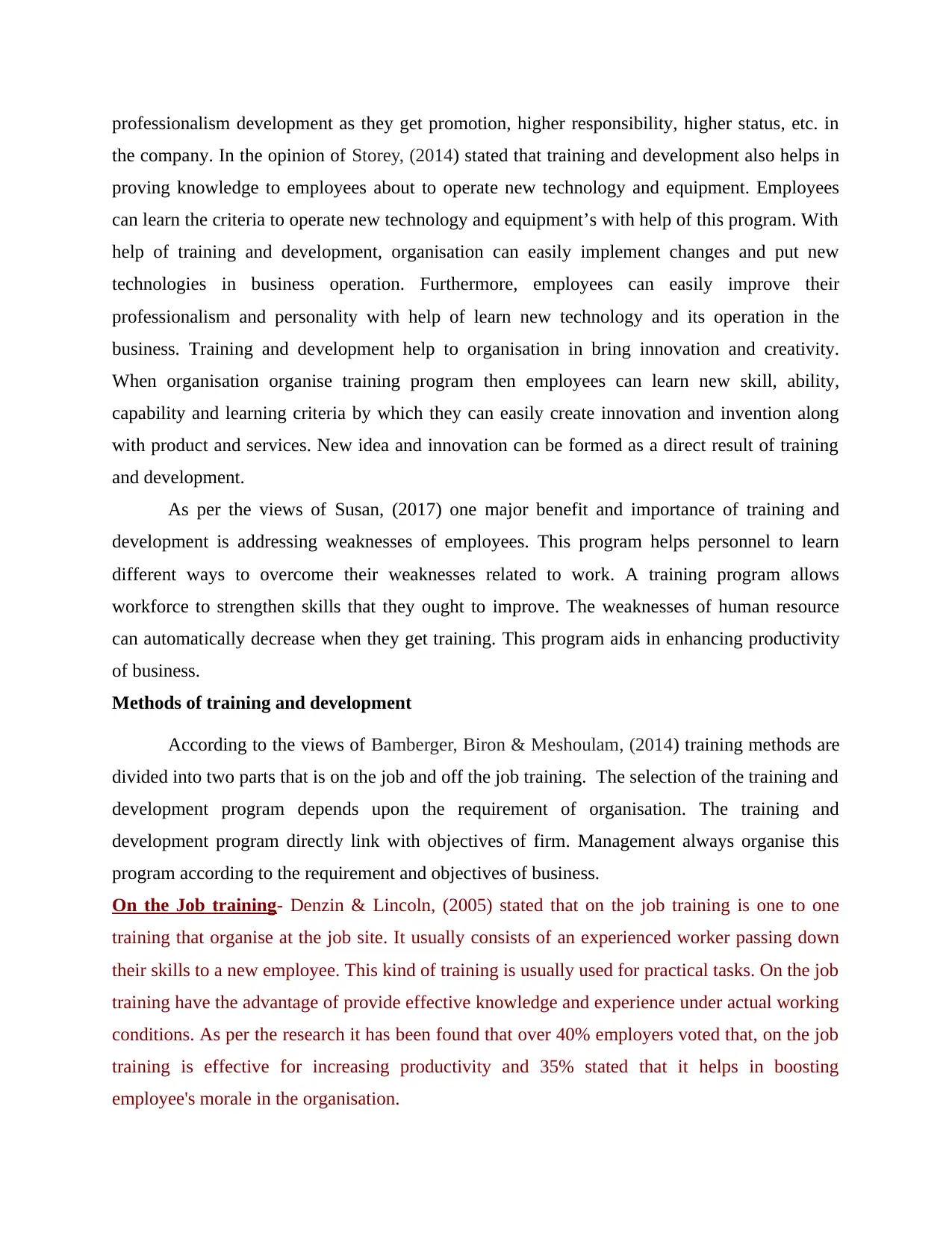
professionalism development as they get promotion, higher responsibility, higher status, etc. in
the company. In the opinion of Storey, (2014) stated that training and development also helps in
proving knowledge to employees about to operate new technology and equipment. Employees
can learn the criteria to operate new technology and equipment’s with help of this program. With
help of training and development, organisation can easily implement changes and put new
technologies in business operation. Furthermore, employees can easily improve their
professionalism and personality with help of learn new technology and its operation in the
business. Training and development help to organisation in bring innovation and creativity.
When organisation organise training program then employees can learn new skill, ability,
capability and learning criteria by which they can easily create innovation and invention along
with product and services. New idea and innovation can be formed as a direct result of training
and development.
As per the views of Susan, (2017) one major benefit and importance of training and
development is addressing weaknesses of employees. This program helps personnel to learn
different ways to overcome their weaknesses related to work. A training program allows
workforce to strengthen skills that they ought to improve. The weaknesses of human resource
can automatically decrease when they get training. This program aids in enhancing productivity
of business.
Methods of training and development
According to the views of Bamberger, Biron & Meshoulam, (2014) training methods are
divided into two parts that is on the job and off the job training. The selection of the training and
development program depends upon the requirement of organisation. The training and
development program directly link with objectives of firm. Management always organise this
program according to the requirement and objectives of business.
On the Job training- Denzin & Lincoln, (2005) stated that on the job training is one to one
training that organise at the job site. It usually consists of an experienced worker passing down
their skills to a new employee. This kind of training is usually used for practical tasks. On the job
training have the advantage of provide effective knowledge and experience under actual working
conditions. As per the research it has been found that over 40% employers voted that, on the job
training is effective for increasing productivity and 35% stated that it helps in boosting
employee's morale in the organisation.
the company. In the opinion of Storey, (2014) stated that training and development also helps in
proving knowledge to employees about to operate new technology and equipment. Employees
can learn the criteria to operate new technology and equipment’s with help of this program. With
help of training and development, organisation can easily implement changes and put new
technologies in business operation. Furthermore, employees can easily improve their
professionalism and personality with help of learn new technology and its operation in the
business. Training and development help to organisation in bring innovation and creativity.
When organisation organise training program then employees can learn new skill, ability,
capability and learning criteria by which they can easily create innovation and invention along
with product and services. New idea and innovation can be formed as a direct result of training
and development.
As per the views of Susan, (2017) one major benefit and importance of training and
development is addressing weaknesses of employees. This program helps personnel to learn
different ways to overcome their weaknesses related to work. A training program allows
workforce to strengthen skills that they ought to improve. The weaknesses of human resource
can automatically decrease when they get training. This program aids in enhancing productivity
of business.
Methods of training and development
According to the views of Bamberger, Biron & Meshoulam, (2014) training methods are
divided into two parts that is on the job and off the job training. The selection of the training and
development program depends upon the requirement of organisation. The training and
development program directly link with objectives of firm. Management always organise this
program according to the requirement and objectives of business.
On the Job training- Denzin & Lincoln, (2005) stated that on the job training is one to one
training that organise at the job site. It usually consists of an experienced worker passing down
their skills to a new employee. This kind of training is usually used for practical tasks. On the job
training have the advantage of provide effective knowledge and experience under actual working
conditions. As per the research it has been found that over 40% employers voted that, on the job
training is effective for increasing productivity and 35% stated that it helps in boosting
employee's morale in the organisation.
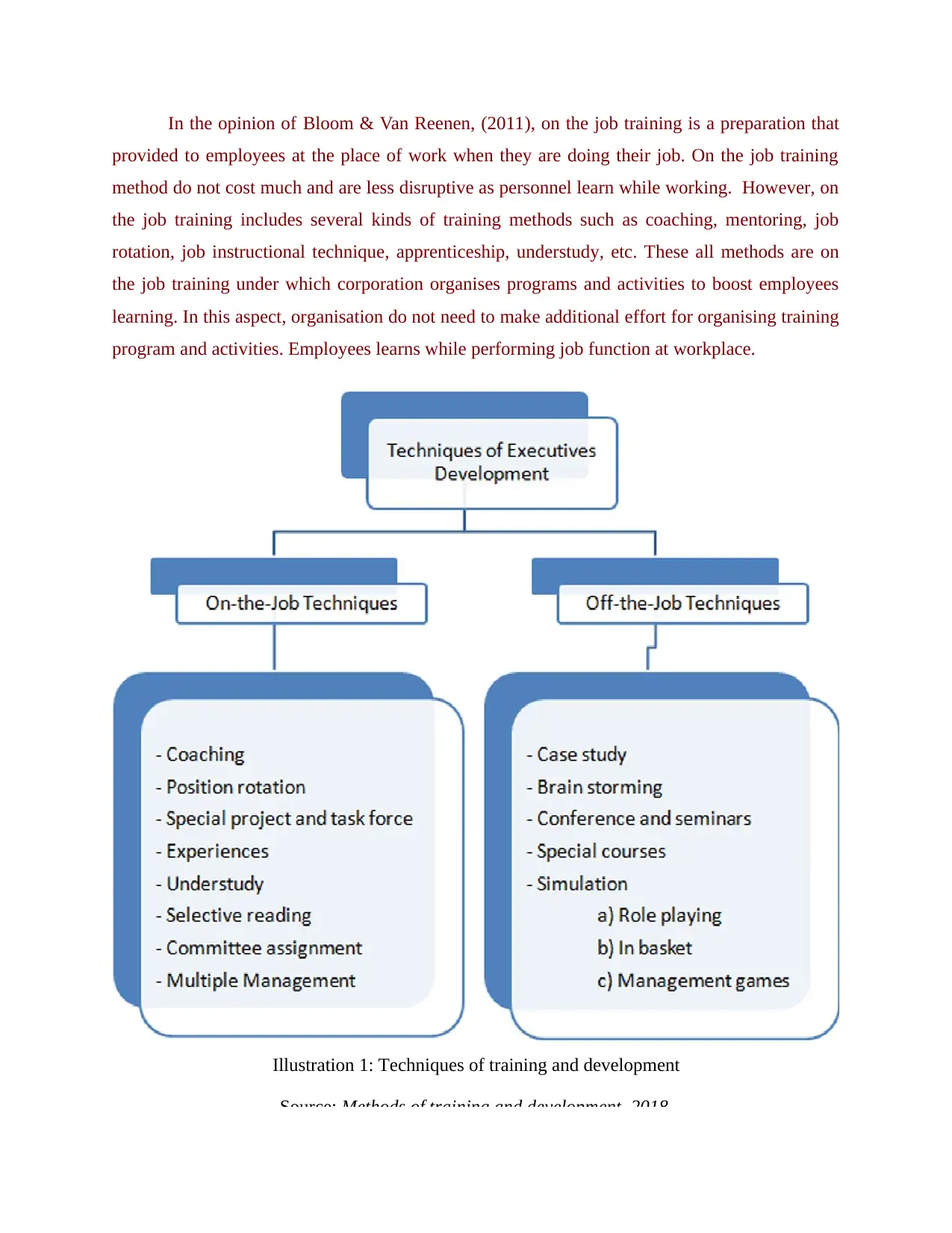
In the opinion of Bloom & Van Reenen, (2011), on the job training is a preparation that
provided to employees at the place of work when they are doing their job. On the job training
method do not cost much and are less disruptive as personnel learn while working. However, on
the job training includes several kinds of training methods such as coaching, mentoring, job
rotation, job instructional technique, apprenticeship, understudy, etc. These all methods are on
the job training under which corporation organises programs and activities to boost employees
learning. In this aspect, organisation do not need to make additional effort for organising training
program and activities. Employees learns while performing job function at workplace.
Illustration 1: Techniques of training and development
Source: Methods of training and development, 2018.
provided to employees at the place of work when they are doing their job. On the job training
method do not cost much and are less disruptive as personnel learn while working. However, on
the job training includes several kinds of training methods such as coaching, mentoring, job
rotation, job instructional technique, apprenticeship, understudy, etc. These all methods are on
the job training under which corporation organises programs and activities to boost employees
learning. In this aspect, organisation do not need to make additional effort for organising training
program and activities. Employees learns while performing job function at workplace.
Illustration 1: Techniques of training and development
Source: Methods of training and development, 2018.
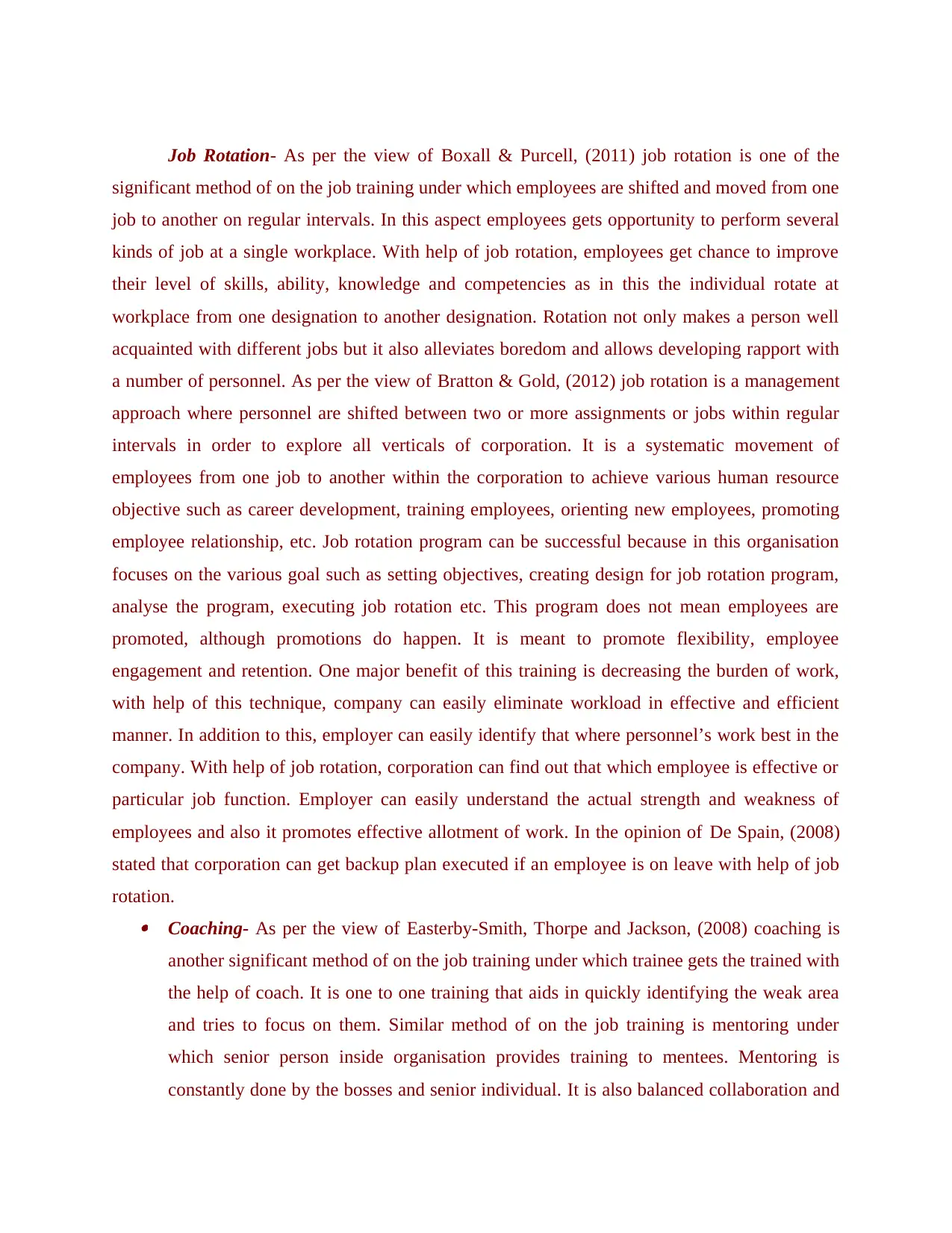
Job Rotation- As per the view of Boxall & Purcell, (2011) job rotation is one of the
significant method of on the job training under which employees are shifted and moved from one
job to another on regular intervals. In this aspect employees gets opportunity to perform several
kinds of job at a single workplace. With help of job rotation, employees get chance to improve
their level of skills, ability, knowledge and competencies as in this the individual rotate at
workplace from one designation to another designation. Rotation not only makes a person well
acquainted with different jobs but it also alleviates boredom and allows developing rapport with
a number of personnel. As per the view of Bratton & Gold, (2012) job rotation is a management
approach where personnel are shifted between two or more assignments or jobs within regular
intervals in order to explore all verticals of corporation. It is a systematic movement of
employees from one job to another within the corporation to achieve various human resource
objective such as career development, training employees, orienting new employees, promoting
employee relationship, etc. Job rotation program can be successful because in this organisation
focuses on the various goal such as setting objectives, creating design for job rotation program,
analyse the program, executing job rotation etc. This program does not mean employees are
promoted, although promotions do happen. It is meant to promote flexibility, employee
engagement and retention. One major benefit of this training is decreasing the burden of work,
with help of this technique, company can easily eliminate workload in effective and efficient
manner. In addition to this, employer can easily identify that where personnel’s work best in the
company. With help of job rotation, corporation can find out that which employee is effective or
particular job function. Employer can easily understand the actual strength and weakness of
employees and also it promotes effective allotment of work. In the opinion of De Spain, (2008)
stated that corporation can get backup plan executed if an employee is on leave with help of job
rotation. Coaching- As per the view of Easterby-Smith, Thorpe and Jackson, (2008) coaching is
another significant method of on the job training under which trainee gets the trained with
the help of coach. It is one to one training that aids in quickly identifying the weak area
and tries to focus on them. Similar method of on the job training is mentoring under
which senior person inside organisation provides training to mentees. Mentoring is
constantly done by the bosses and senior individual. It is also balanced collaboration and
significant method of on the job training under which employees are shifted and moved from one
job to another on regular intervals. In this aspect employees gets opportunity to perform several
kinds of job at a single workplace. With help of job rotation, employees get chance to improve
their level of skills, ability, knowledge and competencies as in this the individual rotate at
workplace from one designation to another designation. Rotation not only makes a person well
acquainted with different jobs but it also alleviates boredom and allows developing rapport with
a number of personnel. As per the view of Bratton & Gold, (2012) job rotation is a management
approach where personnel are shifted between two or more assignments or jobs within regular
intervals in order to explore all verticals of corporation. It is a systematic movement of
employees from one job to another within the corporation to achieve various human resource
objective such as career development, training employees, orienting new employees, promoting
employee relationship, etc. Job rotation program can be successful because in this organisation
focuses on the various goal such as setting objectives, creating design for job rotation program,
analyse the program, executing job rotation etc. This program does not mean employees are
promoted, although promotions do happen. It is meant to promote flexibility, employee
engagement and retention. One major benefit of this training is decreasing the burden of work,
with help of this technique, company can easily eliminate workload in effective and efficient
manner. In addition to this, employer can easily identify that where personnel’s work best in the
company. With help of job rotation, corporation can find out that which employee is effective or
particular job function. Employer can easily understand the actual strength and weakness of
employees and also it promotes effective allotment of work. In the opinion of De Spain, (2008)
stated that corporation can get backup plan executed if an employee is on leave with help of job
rotation. Coaching- As per the view of Easterby-Smith, Thorpe and Jackson, (2008) coaching is
another significant method of on the job training under which trainee gets the trained with
the help of coach. It is one to one training that aids in quickly identifying the weak area
and tries to focus on them. Similar method of on the job training is mentoring under
which senior person inside organisation provides training to mentees. Mentoring is
constantly done by the bosses and senior individual. It is also balanced collaboration and
Secure Best Marks with AI Grader
Need help grading? Try our AI Grader for instant feedback on your assignments.
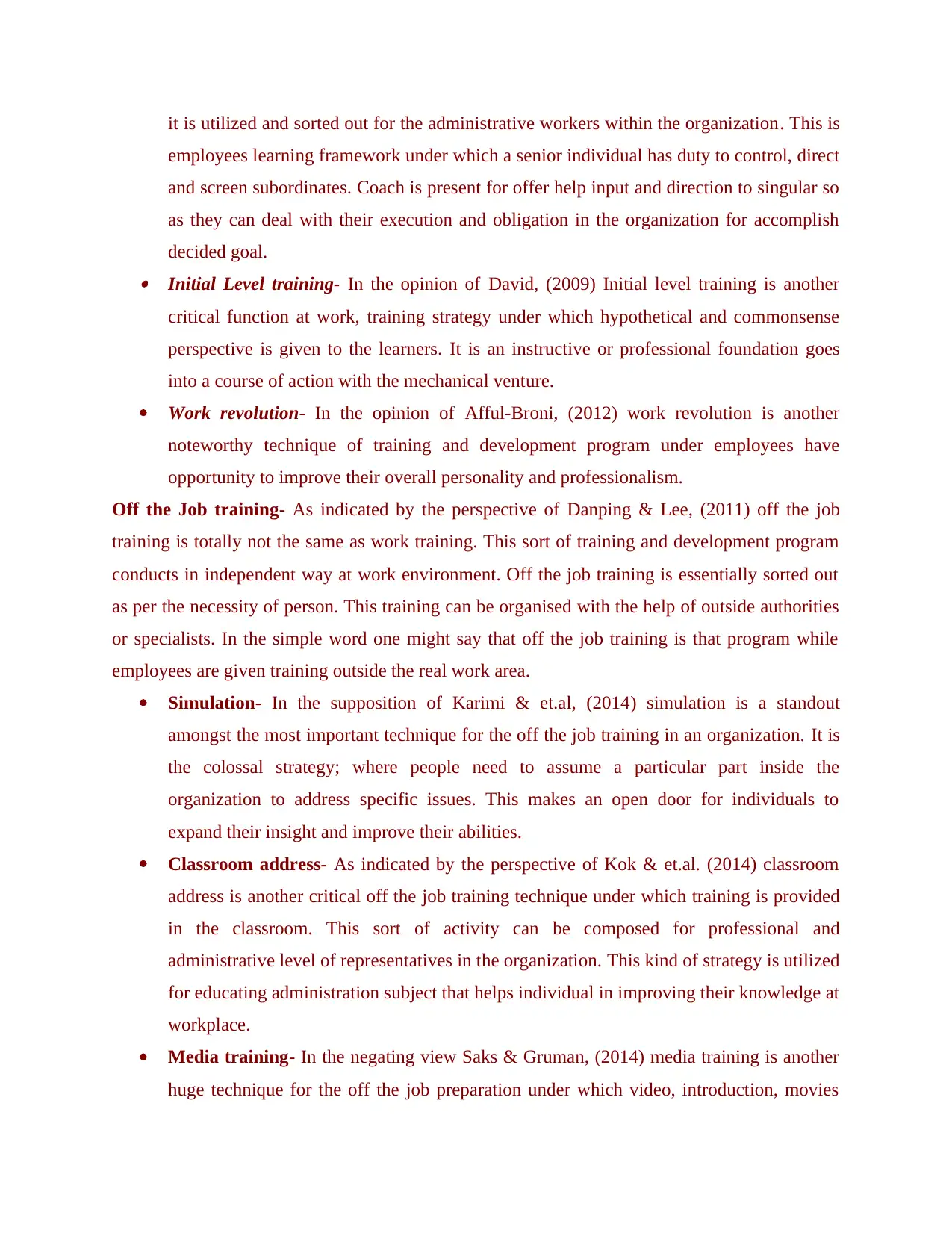
it is utilized and sorted out for the administrative workers within the organization. This is
employees learning framework under which a senior individual has duty to control, direct
and screen subordinates. Coach is present for offer help input and direction to singular so
as they can deal with their execution and obligation in the organization for accomplish
decided goal. Initial Level training- In the opinion of David, (2009) Initial level training is another
critical function at work, training strategy under which hypothetical and commonsense
perspective is given to the learners. It is an instructive or professional foundation goes
into a course of action with the mechanical venture.
Work revolution- In the opinion of Afful-Broni, (2012) work revolution is another
noteworthy technique of training and development program under employees have
opportunity to improve their overall personality and professionalism.
Off the Job training- As indicated by the perspective of Danping & Lee, (2011) off the job
training is totally not the same as work training. This sort of training and development program
conducts in independent way at work environment. Off the job training is essentially sorted out
as per the necessity of person. This training can be organised with the help of outside authorities
or specialists. In the simple word one might say that off the job training is that program while
employees are given training outside the real work area.
Simulation- In the supposition of Karimi & et.al, (2014) simulation is a standout
amongst the most important technique for the off the job training in an organization. It is
the colossal strategy; where people need to assume a particular part inside the
organization to address specific issues. This makes an open door for individuals to
expand their insight and improve their abilities.
Classroom address- As indicated by the perspective of Kok & et.al. (2014) classroom
address is another critical off the job training technique under which training is provided
in the classroom. This sort of activity can be composed for professional and
administrative level of representatives in the organization. This kind of strategy is utilized
for educating administration subject that helps individual in improving their knowledge at
workplace.
Media training- In the negating view Saks & Gruman, (2014) media training is another
huge technique for the off the job preparation under which video, introduction, movies
employees learning framework under which a senior individual has duty to control, direct
and screen subordinates. Coach is present for offer help input and direction to singular so
as they can deal with their execution and obligation in the organization for accomplish
decided goal. Initial Level training- In the opinion of David, (2009) Initial level training is another
critical function at work, training strategy under which hypothetical and commonsense
perspective is given to the learners. It is an instructive or professional foundation goes
into a course of action with the mechanical venture.
Work revolution- In the opinion of Afful-Broni, (2012) work revolution is another
noteworthy technique of training and development program under employees have
opportunity to improve their overall personality and professionalism.
Off the Job training- As indicated by the perspective of Danping & Lee, (2011) off the job
training is totally not the same as work training. This sort of training and development program
conducts in independent way at work environment. Off the job training is essentially sorted out
as per the necessity of person. This training can be organised with the help of outside authorities
or specialists. In the simple word one might say that off the job training is that program while
employees are given training outside the real work area.
Simulation- In the supposition of Karimi & et.al, (2014) simulation is a standout
amongst the most important technique for the off the job training in an organization. It is
the colossal strategy; where people need to assume a particular part inside the
organization to address specific issues. This makes an open door for individuals to
expand their insight and improve their abilities.
Classroom address- As indicated by the perspective of Kok & et.al. (2014) classroom
address is another critical off the job training technique under which training is provided
in the classroom. This sort of activity can be composed for professional and
administrative level of representatives in the organization. This kind of strategy is utilized
for educating administration subject that helps individual in improving their knowledge at
workplace.
Media training- In the negating view Saks & Gruman, (2014) media training is another
huge technique for the off the job preparation under which video, introduction, movies
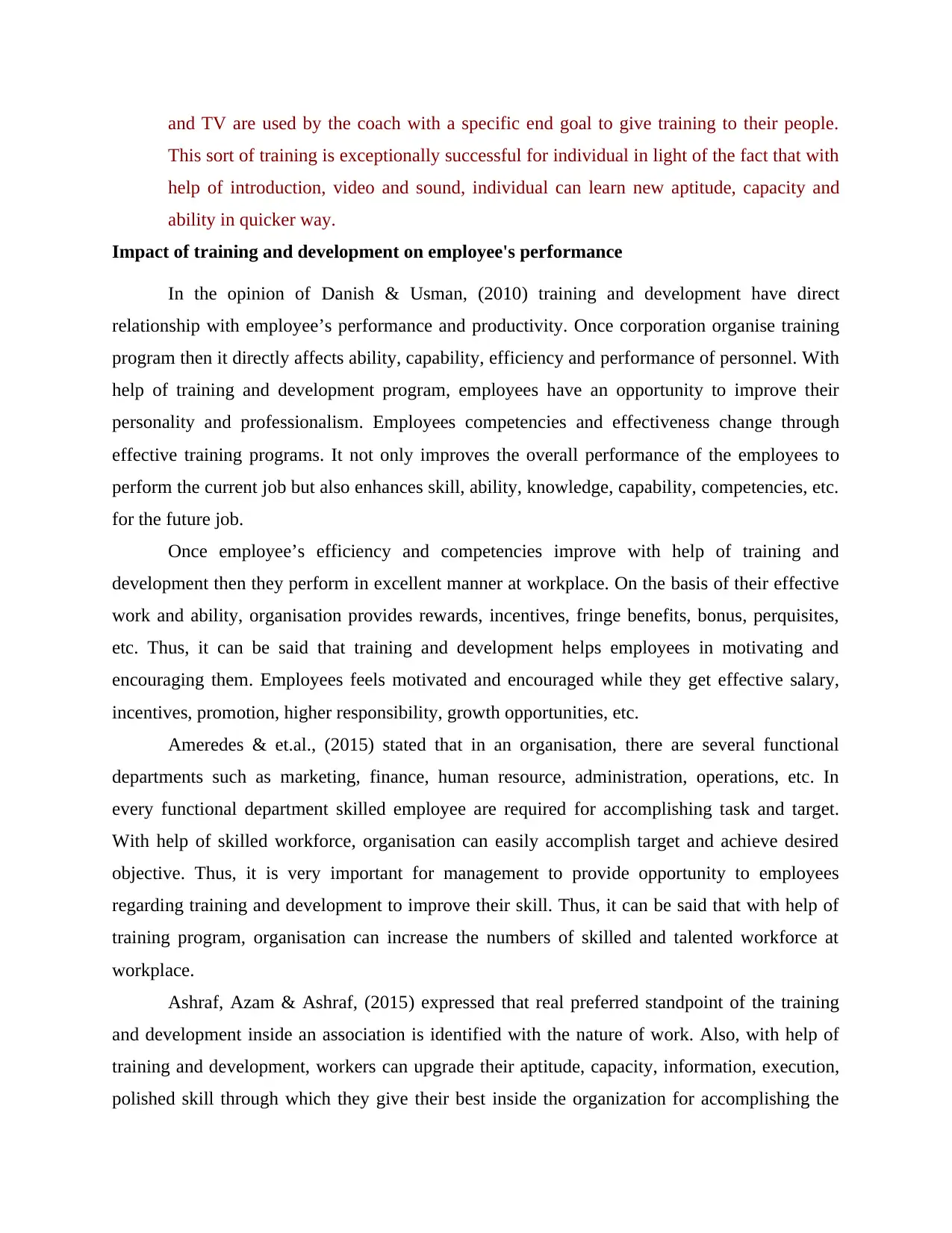
and TV are used by the coach with a specific end goal to give training to their people.
This sort of training is exceptionally successful for individual in light of the fact that with
help of introduction, video and sound, individual can learn new aptitude, capacity and
ability in quicker way.
Impact of training and development on employee's performance
In the opinion of Danish & Usman, (2010) training and development have direct
relationship with employee’s performance and productivity. Once corporation organise training
program then it directly affects ability, capability, efficiency and performance of personnel. With
help of training and development program, employees have an opportunity to improve their
personality and professionalism. Employees competencies and effectiveness change through
effective training programs. It not only improves the overall performance of the employees to
perform the current job but also enhances skill, ability, knowledge, capability, competencies, etc.
for the future job.
Once employee’s efficiency and competencies improve with help of training and
development then they perform in excellent manner at workplace. On the basis of their effective
work and ability, organisation provides rewards, incentives, fringe benefits, bonus, perquisites,
etc. Thus, it can be said that training and development helps employees in motivating and
encouraging them. Employees feels motivated and encouraged while they get effective salary,
incentives, promotion, higher responsibility, growth opportunities, etc.
Ameredes & et.al., (2015) stated that in an organisation, there are several functional
departments such as marketing, finance, human resource, administration, operations, etc. In
every functional department skilled employee are required for accomplishing task and target.
With help of skilled workforce, organisation can easily accomplish target and achieve desired
objective. Thus, it is very important for management to provide opportunity to employees
regarding training and development to improve their skill. Thus, it can be said that with help of
training program, organisation can increase the numbers of skilled and talented workforce at
workplace.
Ashraf, Azam & Ashraf, (2015) expressed that real preferred standpoint of the training
and development inside an association is identified with the nature of work. Also, with help of
training and development, workers can upgrade their aptitude, capacity, information, execution,
polished skill through which they give their best inside the organization for accomplishing the
This sort of training is exceptionally successful for individual in light of the fact that with
help of introduction, video and sound, individual can learn new aptitude, capacity and
ability in quicker way.
Impact of training and development on employee's performance
In the opinion of Danish & Usman, (2010) training and development have direct
relationship with employee’s performance and productivity. Once corporation organise training
program then it directly affects ability, capability, efficiency and performance of personnel. With
help of training and development program, employees have an opportunity to improve their
personality and professionalism. Employees competencies and effectiveness change through
effective training programs. It not only improves the overall performance of the employees to
perform the current job but also enhances skill, ability, knowledge, capability, competencies, etc.
for the future job.
Once employee’s efficiency and competencies improve with help of training and
development then they perform in excellent manner at workplace. On the basis of their effective
work and ability, organisation provides rewards, incentives, fringe benefits, bonus, perquisites,
etc. Thus, it can be said that training and development helps employees in motivating and
encouraging them. Employees feels motivated and encouraged while they get effective salary,
incentives, promotion, higher responsibility, growth opportunities, etc.
Ameredes & et.al., (2015) stated that in an organisation, there are several functional
departments such as marketing, finance, human resource, administration, operations, etc. In
every functional department skilled employee are required for accomplishing task and target.
With help of skilled workforce, organisation can easily accomplish target and achieve desired
objective. Thus, it is very important for management to provide opportunity to employees
regarding training and development to improve their skill. Thus, it can be said that with help of
training program, organisation can increase the numbers of skilled and talented workforce at
workplace.
Ashraf, Azam & Ashraf, (2015) expressed that real preferred standpoint of the training
and development inside an association is identified with the nature of work. Also, with help of
training and development, workers can upgrade their aptitude, capacity, information, execution,
polished skill through which they give their best inside the organization for accomplishing the
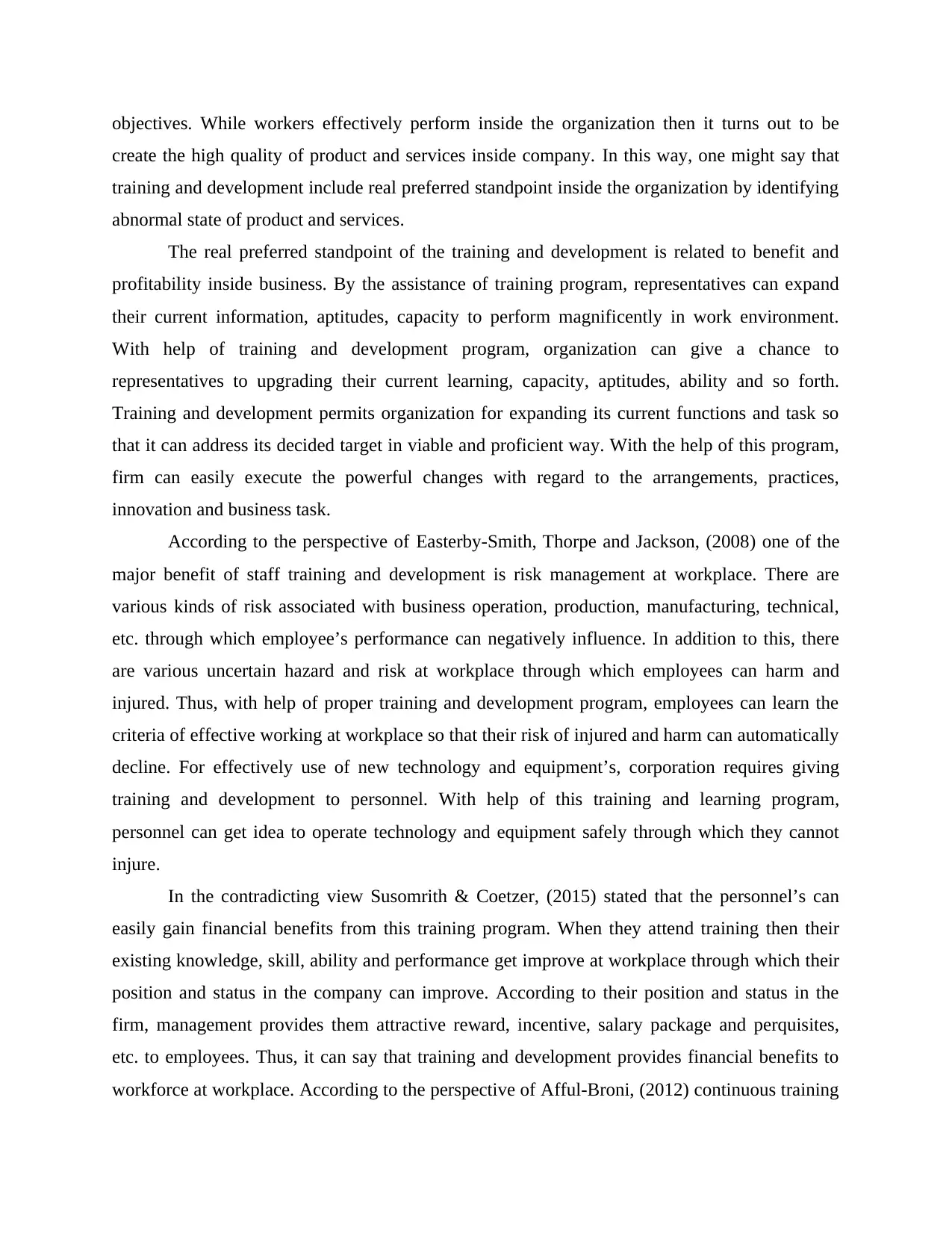
objectives. While workers effectively perform inside the organization then it turns out to be
create the high quality of product and services inside company. In this way, one might say that
training and development include real preferred standpoint inside the organization by identifying
abnormal state of product and services.
The real preferred standpoint of the training and development is related to benefit and
profitability inside business. By the assistance of training program, representatives can expand
their current information, aptitudes, capacity to perform magnificently in work environment.
With help of training and development program, organization can give a chance to
representatives to upgrading their current learning, capacity, aptitudes, ability and so forth.
Training and development permits organization for expanding its current functions and task so
that it can address its decided target in viable and proficient way. With the help of this program,
firm can easily execute the powerful changes with regard to the arrangements, practices,
innovation and business task.
According to the perspective of Easterby-Smith, Thorpe and Jackson, (2008) one of the
major benefit of staff training and development is risk management at workplace. There are
various kinds of risk associated with business operation, production, manufacturing, technical,
etc. through which employee’s performance can negatively influence. In addition to this, there
are various uncertain hazard and risk at workplace through which employees can harm and
injured. Thus, with help of proper training and development program, employees can learn the
criteria of effective working at workplace so that their risk of injured and harm can automatically
decline. For effectively use of new technology and equipment’s, corporation requires giving
training and development to personnel. With help of this training and learning program,
personnel can get idea to operate technology and equipment safely through which they cannot
injure.
In the contradicting view Susomrith & Coetzer, (2015) stated that the personnel’s can
easily gain financial benefits from this training program. When they attend training then their
existing knowledge, skill, ability and performance get improve at workplace through which their
position and status in the company can improve. According to their position and status in the
firm, management provides them attractive reward, incentive, salary package and perquisites,
etc. to employees. Thus, it can say that training and development provides financial benefits to
workforce at workplace. According to the perspective of Afful-Broni, (2012) continuous training
create the high quality of product and services inside company. In this way, one might say that
training and development include real preferred standpoint inside the organization by identifying
abnormal state of product and services.
The real preferred standpoint of the training and development is related to benefit and
profitability inside business. By the assistance of training program, representatives can expand
their current information, aptitudes, capacity to perform magnificently in work environment.
With help of training and development program, organization can give a chance to
representatives to upgrading their current learning, capacity, aptitudes, ability and so forth.
Training and development permits organization for expanding its current functions and task so
that it can address its decided target in viable and proficient way. With the help of this program,
firm can easily execute the powerful changes with regard to the arrangements, practices,
innovation and business task.
According to the perspective of Easterby-Smith, Thorpe and Jackson, (2008) one of the
major benefit of staff training and development is risk management at workplace. There are
various kinds of risk associated with business operation, production, manufacturing, technical,
etc. through which employee’s performance can negatively influence. In addition to this, there
are various uncertain hazard and risk at workplace through which employees can harm and
injured. Thus, with help of proper training and development program, employees can learn the
criteria of effective working at workplace so that their risk of injured and harm can automatically
decline. For effectively use of new technology and equipment’s, corporation requires giving
training and development to personnel. With help of this training and learning program,
personnel can get idea to operate technology and equipment safely through which they cannot
injure.
In the contradicting view Susomrith & Coetzer, (2015) stated that the personnel’s can
easily gain financial benefits from this training program. When they attend training then their
existing knowledge, skill, ability and performance get improve at workplace through which their
position and status in the company can improve. According to their position and status in the
firm, management provides them attractive reward, incentive, salary package and perquisites,
etc. to employees. Thus, it can say that training and development provides financial benefits to
workforce at workplace. According to the perspective of Afful-Broni, (2012) continuous training
Paraphrase This Document
Need a fresh take? Get an instant paraphrase of this document with our AI Paraphraser
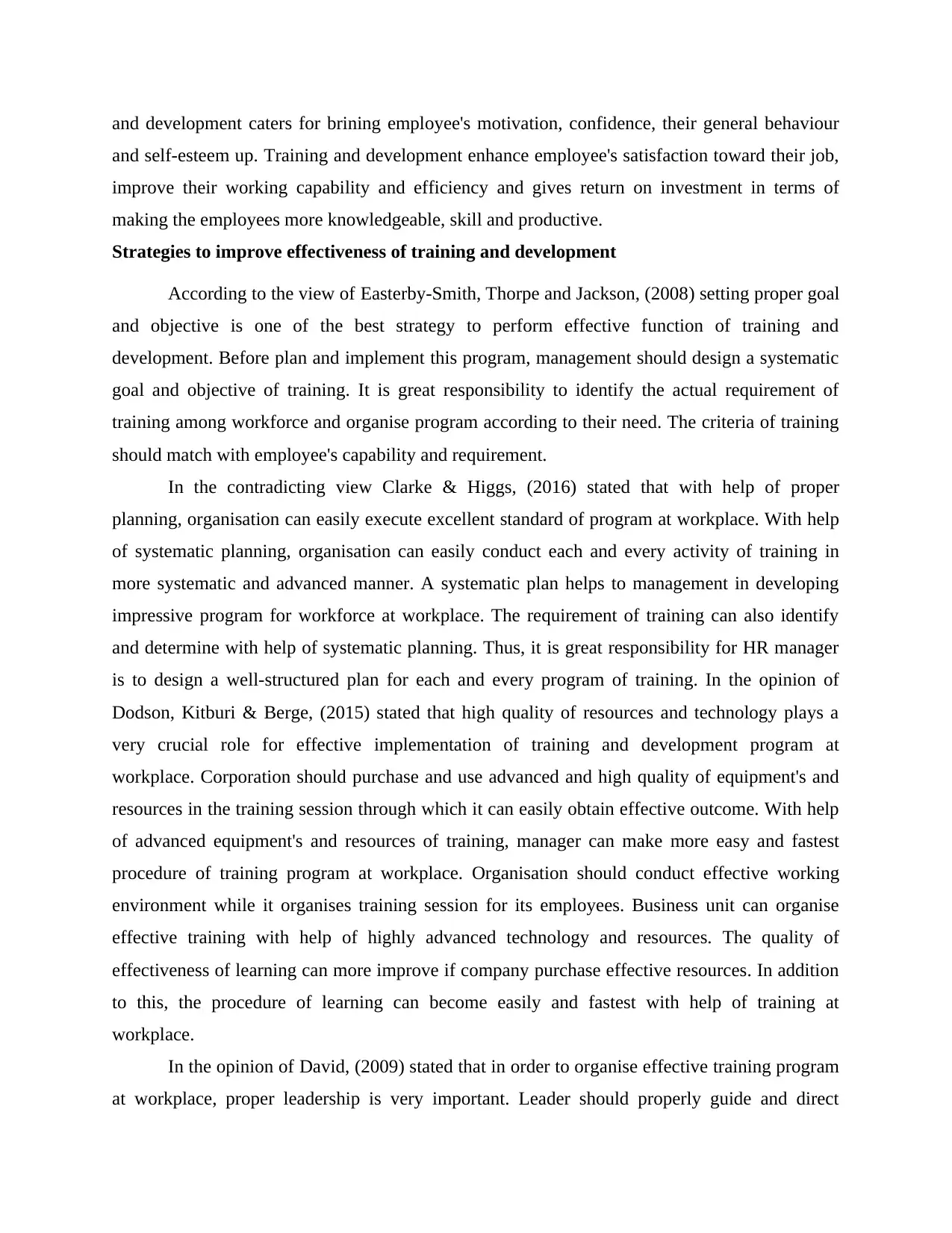
and development caters for brining employee's motivation, confidence, their general behaviour
and self-esteem up. Training and development enhance employee's satisfaction toward their job,
improve their working capability and efficiency and gives return on investment in terms of
making the employees more knowledgeable, skill and productive.
Strategies to improve effectiveness of training and development
According to the view of Easterby-Smith, Thorpe and Jackson, (2008) setting proper goal
and objective is one of the best strategy to perform effective function of training and
development. Before plan and implement this program, management should design a systematic
goal and objective of training. It is great responsibility to identify the actual requirement of
training among workforce and organise program according to their need. The criteria of training
should match with employee's capability and requirement.
In the contradicting view Clarke & Higgs, (2016) stated that with help of proper
planning, organisation can easily execute excellent standard of program at workplace. With help
of systematic planning, organisation can easily conduct each and every activity of training in
more systematic and advanced manner. A systematic plan helps to management in developing
impressive program for workforce at workplace. The requirement of training can also identify
and determine with help of systematic planning. Thus, it is great responsibility for HR manager
is to design a well-structured plan for each and every program of training. In the opinion of
Dodson, Kitburi & Berge, (2015) stated that high quality of resources and technology plays a
very crucial role for effective implementation of training and development program at
workplace. Corporation should purchase and use advanced and high quality of equipment's and
resources in the training session through which it can easily obtain effective outcome. With help
of advanced equipment's and resources of training, manager can make more easy and fastest
procedure of training program at workplace. Organisation should conduct effective working
environment while it organises training session for its employees. Business unit can organise
effective training with help of highly advanced technology and resources. The quality of
effectiveness of learning can more improve if company purchase effective resources. In addition
to this, the procedure of learning can become easily and fastest with help of training at
workplace.
In the opinion of David, (2009) stated that in order to organise effective training program
at workplace, proper leadership is very important. Leader should properly guide and direct
and self-esteem up. Training and development enhance employee's satisfaction toward their job,
improve their working capability and efficiency and gives return on investment in terms of
making the employees more knowledgeable, skill and productive.
Strategies to improve effectiveness of training and development
According to the view of Easterby-Smith, Thorpe and Jackson, (2008) setting proper goal
and objective is one of the best strategy to perform effective function of training and
development. Before plan and implement this program, management should design a systematic
goal and objective of training. It is great responsibility to identify the actual requirement of
training among workforce and organise program according to their need. The criteria of training
should match with employee's capability and requirement.
In the contradicting view Clarke & Higgs, (2016) stated that with help of proper
planning, organisation can easily execute excellent standard of program at workplace. With help
of systematic planning, organisation can easily conduct each and every activity of training in
more systematic and advanced manner. A systematic plan helps to management in developing
impressive program for workforce at workplace. The requirement of training can also identify
and determine with help of systematic planning. Thus, it is great responsibility for HR manager
is to design a well-structured plan for each and every program of training. In the opinion of
Dodson, Kitburi & Berge, (2015) stated that high quality of resources and technology plays a
very crucial role for effective implementation of training and development program at
workplace. Corporation should purchase and use advanced and high quality of equipment's and
resources in the training session through which it can easily obtain effective outcome. With help
of advanced equipment's and resources of training, manager can make more easy and fastest
procedure of training program at workplace. Organisation should conduct effective working
environment while it organises training session for its employees. Business unit can organise
effective training with help of highly advanced technology and resources. The quality of
effectiveness of learning can more improve if company purchase effective resources. In addition
to this, the procedure of learning can become easily and fastest with help of training at
workplace.
In the opinion of David, (2009) stated that in order to organise effective training program
at workplace, proper leadership is very important. Leader should properly guide and direct
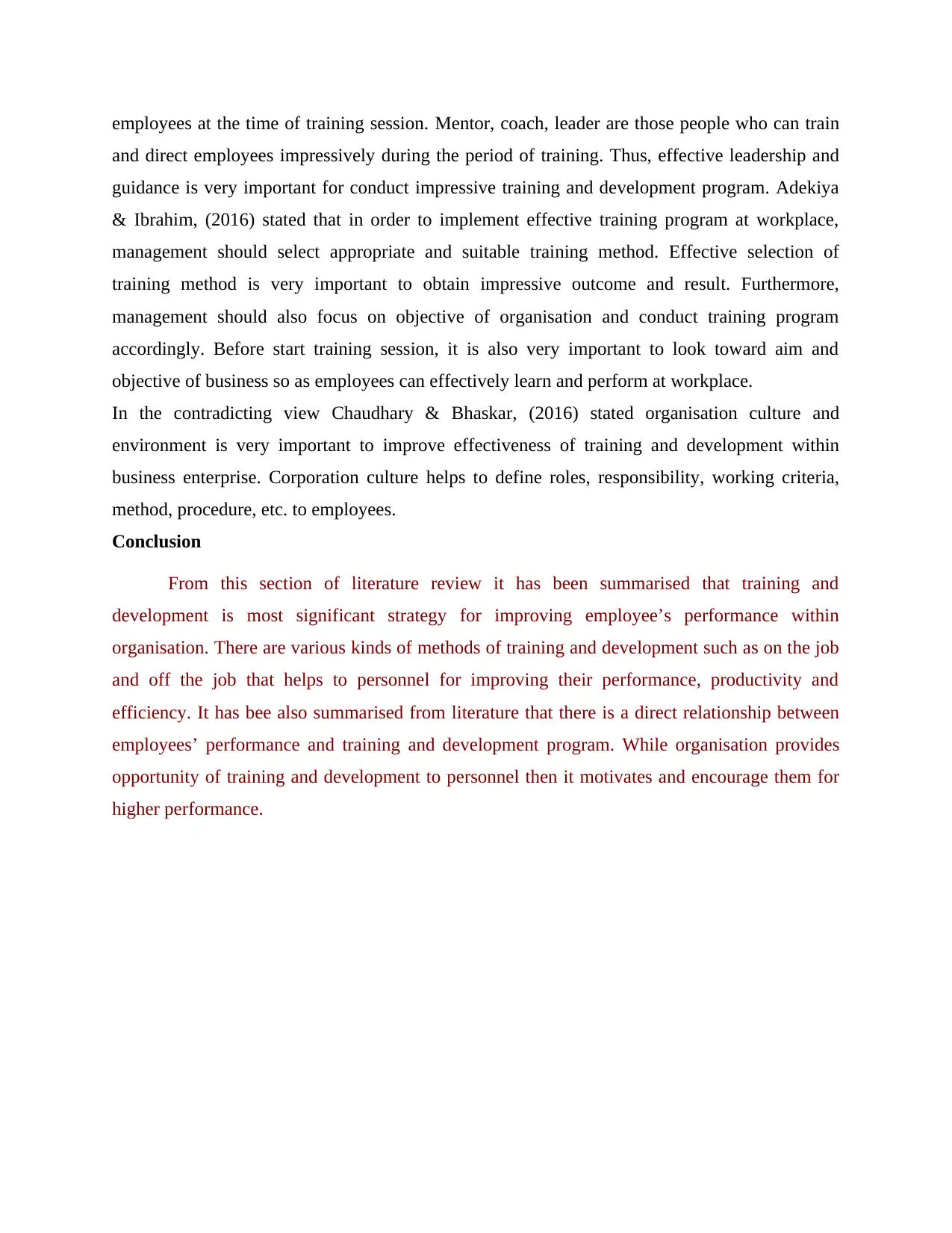
employees at the time of training session. Mentor, coach, leader are those people who can train
and direct employees impressively during the period of training. Thus, effective leadership and
guidance is very important for conduct impressive training and development program. Adekiya
& Ibrahim, (2016) stated that in order to implement effective training program at workplace,
management should select appropriate and suitable training method. Effective selection of
training method is very important to obtain impressive outcome and result. Furthermore,
management should also focus on objective of organisation and conduct training program
accordingly. Before start training session, it is also very important to look toward aim and
objective of business so as employees can effectively learn and perform at workplace.
In the contradicting view Chaudhary & Bhaskar, (2016) stated organisation culture and
environment is very important to improve effectiveness of training and development within
business enterprise. Corporation culture helps to define roles, responsibility, working criteria,
method, procedure, etc. to employees.
Conclusion
From this section of literature review it has been summarised that training and
development is most significant strategy for improving employee’s performance within
organisation. There are various kinds of methods of training and development such as on the job
and off the job that helps to personnel for improving their performance, productivity and
efficiency. It has bee also summarised from literature that there is a direct relationship between
employees’ performance and training and development program. While organisation provides
opportunity of training and development to personnel then it motivates and encourage them for
higher performance.
and direct employees impressively during the period of training. Thus, effective leadership and
guidance is very important for conduct impressive training and development program. Adekiya
& Ibrahim, (2016) stated that in order to implement effective training program at workplace,
management should select appropriate and suitable training method. Effective selection of
training method is very important to obtain impressive outcome and result. Furthermore,
management should also focus on objective of organisation and conduct training program
accordingly. Before start training session, it is also very important to look toward aim and
objective of business so as employees can effectively learn and perform at workplace.
In the contradicting view Chaudhary & Bhaskar, (2016) stated organisation culture and
environment is very important to improve effectiveness of training and development within
business enterprise. Corporation culture helps to define roles, responsibility, working criteria,
method, procedure, etc. to employees.
Conclusion
From this section of literature review it has been summarised that training and
development is most significant strategy for improving employee’s performance within
organisation. There are various kinds of methods of training and development such as on the job
and off the job that helps to personnel for improving their performance, productivity and
efficiency. It has bee also summarised from literature that there is a direct relationship between
employees’ performance and training and development program. While organisation provides
opportunity of training and development to personnel then it motivates and encourage them for
higher performance.
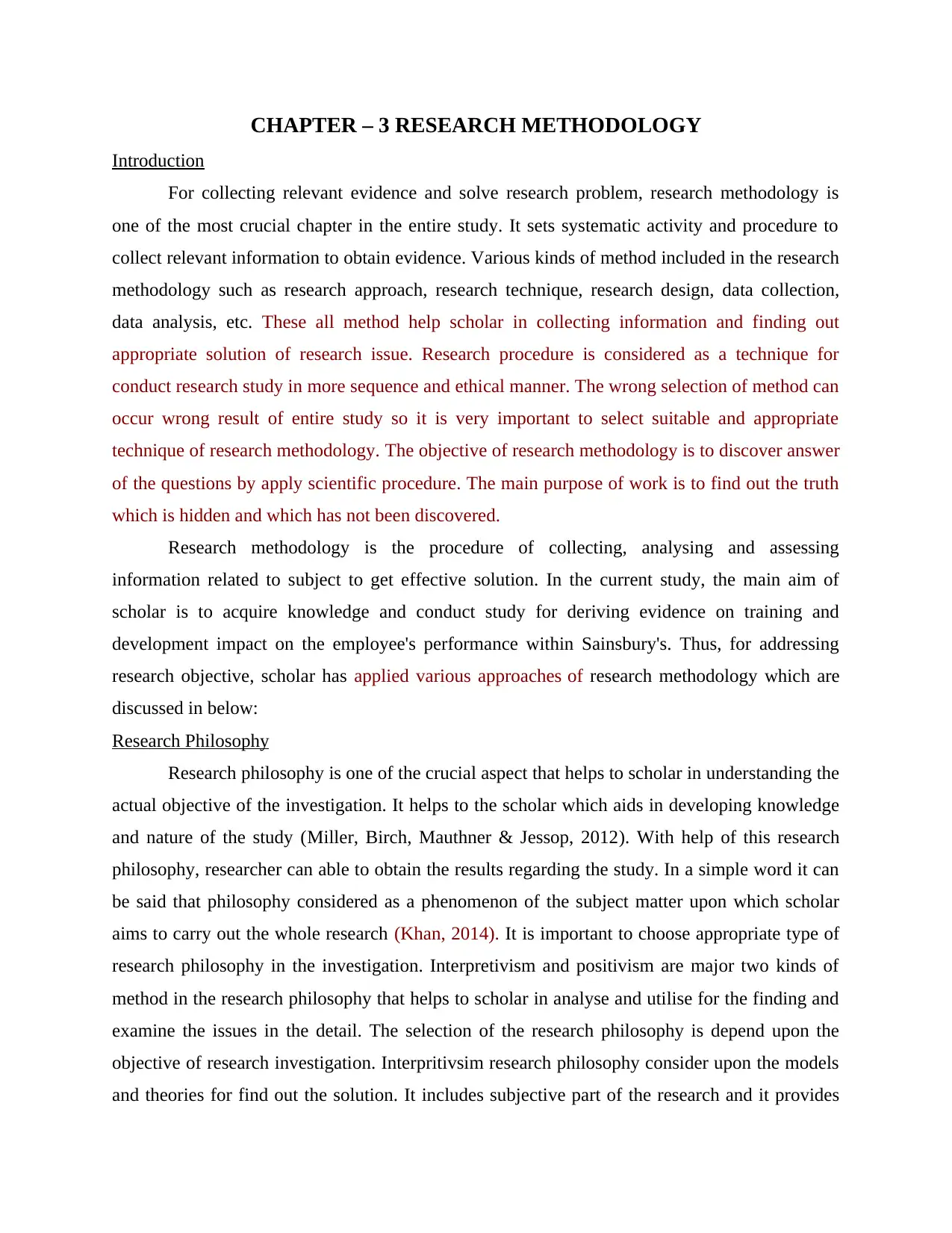
CHAPTER – 3 RESEARCH METHODOLOGY
Introduction
For collecting relevant evidence and solve research problem, research methodology is
one of the most crucial chapter in the entire study. It sets systematic activity and procedure to
collect relevant information to obtain evidence. Various kinds of method included in the research
methodology such as research approach, research technique, research design, data collection,
data analysis, etc. These all method help scholar in collecting information and finding out
appropriate solution of research issue. Research procedure is considered as a technique for
conduct research study in more sequence and ethical manner. The wrong selection of method can
occur wrong result of entire study so it is very important to select suitable and appropriate
technique of research methodology. The objective of research methodology is to discover answer
of the questions by apply scientific procedure. The main purpose of work is to find out the truth
which is hidden and which has not been discovered.
Research methodology is the procedure of collecting, analysing and assessing
information related to subject to get effective solution. In the current study, the main aim of
scholar is to acquire knowledge and conduct study for deriving evidence on training and
development impact on the employee's performance within Sainsbury's. Thus, for addressing
research objective, scholar has applied various approaches of research methodology which are
discussed in below:
Research Philosophy
Research philosophy is one of the crucial aspect that helps to scholar in understanding the
actual objective of the investigation. It helps to the scholar which aids in developing knowledge
and nature of the study (Miller, Birch, Mauthner & Jessop, 2012). With help of this research
philosophy, researcher can able to obtain the results regarding the study. In a simple word it can
be said that philosophy considered as a phenomenon of the subject matter upon which scholar
aims to carry out the whole research (Khan, 2014). It is important to choose appropriate type of
research philosophy in the investigation. Interpretivism and positivism are major two kinds of
method in the research philosophy that helps to scholar in analyse and utilise for the finding and
examine the issues in the detail. The selection of the research philosophy is depend upon the
objective of research investigation. Interpritivsim research philosophy consider upon the models
and theories for find out the solution. It includes subjective part of the research and it provides
Introduction
For collecting relevant evidence and solve research problem, research methodology is
one of the most crucial chapter in the entire study. It sets systematic activity and procedure to
collect relevant information to obtain evidence. Various kinds of method included in the research
methodology such as research approach, research technique, research design, data collection,
data analysis, etc. These all method help scholar in collecting information and finding out
appropriate solution of research issue. Research procedure is considered as a technique for
conduct research study in more sequence and ethical manner. The wrong selection of method can
occur wrong result of entire study so it is very important to select suitable and appropriate
technique of research methodology. The objective of research methodology is to discover answer
of the questions by apply scientific procedure. The main purpose of work is to find out the truth
which is hidden and which has not been discovered.
Research methodology is the procedure of collecting, analysing and assessing
information related to subject to get effective solution. In the current study, the main aim of
scholar is to acquire knowledge and conduct study for deriving evidence on training and
development impact on the employee's performance within Sainsbury's. Thus, for addressing
research objective, scholar has applied various approaches of research methodology which are
discussed in below:
Research Philosophy
Research philosophy is one of the crucial aspect that helps to scholar in understanding the
actual objective of the investigation. It helps to the scholar which aids in developing knowledge
and nature of the study (Miller, Birch, Mauthner & Jessop, 2012). With help of this research
philosophy, researcher can able to obtain the results regarding the study. In a simple word it can
be said that philosophy considered as a phenomenon of the subject matter upon which scholar
aims to carry out the whole research (Khan, 2014). It is important to choose appropriate type of
research philosophy in the investigation. Interpretivism and positivism are major two kinds of
method in the research philosophy that helps to scholar in analyse and utilise for the finding and
examine the issues in the detail. The selection of the research philosophy is depend upon the
objective of research investigation. Interpritivsim research philosophy consider upon the models
and theories for find out the solution. It includes subjective part of the research and it provides
Secure Best Marks with AI Grader
Need help grading? Try our AI Grader for instant feedback on your assignments.
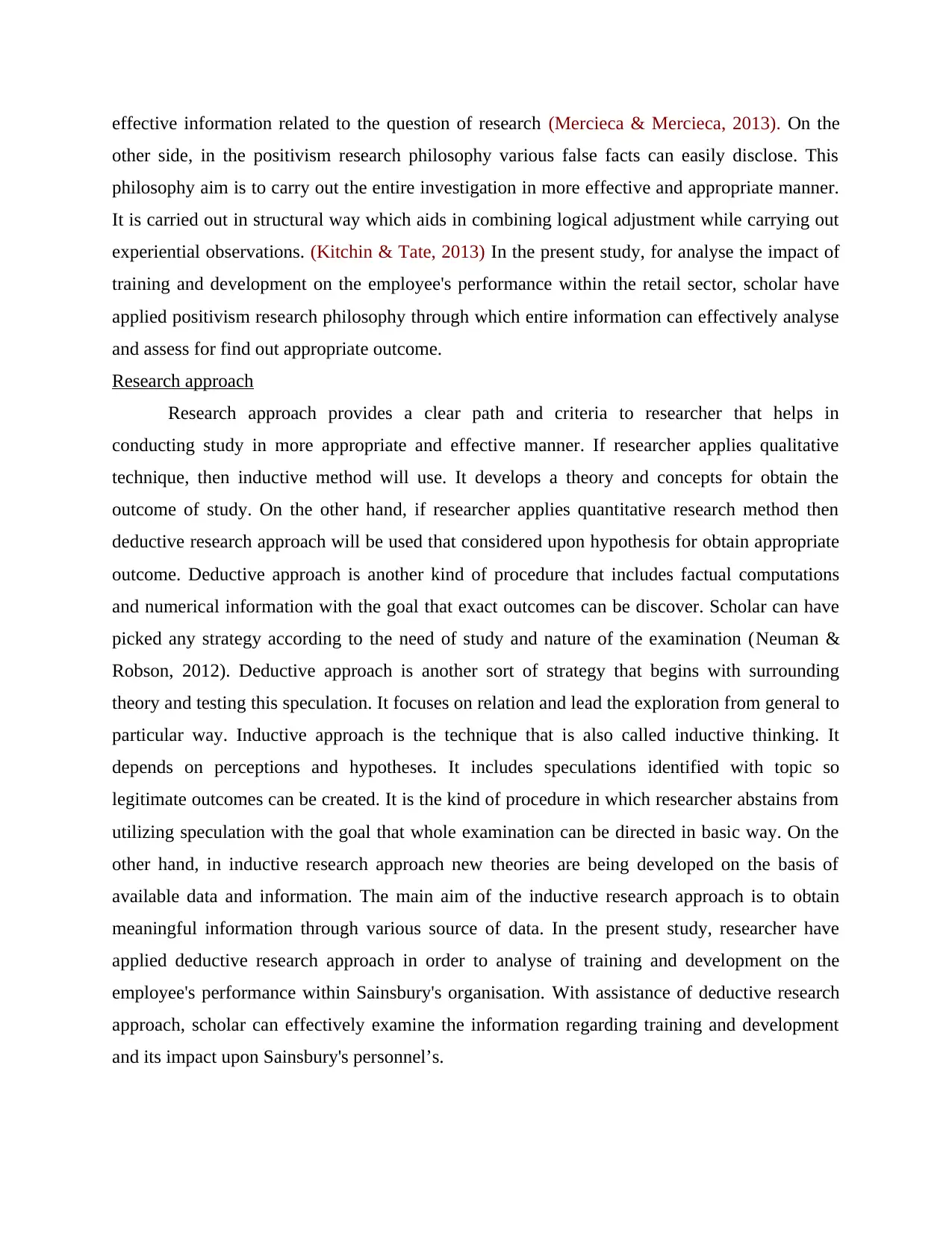
effective information related to the question of research (Mercieca & Mercieca, 2013). On the
other side, in the positivism research philosophy various false facts can easily disclose. This
philosophy aim is to carry out the entire investigation in more effective and appropriate manner.
It is carried out in structural way which aids in combining logical adjustment while carrying out
experiential observations. (Kitchin & Tate, 2013) In the present study, for analyse the impact of
training and development on the employee's performance within the retail sector, scholar have
applied positivism research philosophy through which entire information can effectively analyse
and assess for find out appropriate outcome.
Research approach
Research approach provides a clear path and criteria to researcher that helps in
conducting study in more appropriate and effective manner. If researcher applies qualitative
technique, then inductive method will use. It develops a theory and concepts for obtain the
outcome of study. On the other hand, if researcher applies quantitative research method then
deductive research approach will be used that considered upon hypothesis for obtain appropriate
outcome. Deductive approach is another kind of procedure that includes factual computations
and numerical information with the goal that exact outcomes can be discover. Scholar can have
picked any strategy according to the need of study and nature of the examination (Neuman &
Robson, 2012). Deductive approach is another sort of strategy that begins with surrounding
theory and testing this speculation. It focuses on relation and lead the exploration from general to
particular way. Inductive approach is the technique that is also called inductive thinking. It
depends on perceptions and hypotheses. It includes speculations identified with topic so
legitimate outcomes can be created. It is the kind of procedure in which researcher abstains from
utilizing speculation with the goal that whole examination can be directed in basic way. On the
other hand, in inductive research approach new theories are being developed on the basis of
available data and information. The main aim of the inductive research approach is to obtain
meaningful information through various source of data. In the present study, researcher have
applied deductive research approach in order to analyse of training and development on the
employee's performance within Sainsbury's organisation. With assistance of deductive research
approach, scholar can effectively examine the information regarding training and development
and its impact upon Sainsbury's personnel’s.
other side, in the positivism research philosophy various false facts can easily disclose. This
philosophy aim is to carry out the entire investigation in more effective and appropriate manner.
It is carried out in structural way which aids in combining logical adjustment while carrying out
experiential observations. (Kitchin & Tate, 2013) In the present study, for analyse the impact of
training and development on the employee's performance within the retail sector, scholar have
applied positivism research philosophy through which entire information can effectively analyse
and assess for find out appropriate outcome.
Research approach
Research approach provides a clear path and criteria to researcher that helps in
conducting study in more appropriate and effective manner. If researcher applies qualitative
technique, then inductive method will use. It develops a theory and concepts for obtain the
outcome of study. On the other hand, if researcher applies quantitative research method then
deductive research approach will be used that considered upon hypothesis for obtain appropriate
outcome. Deductive approach is another kind of procedure that includes factual computations
and numerical information with the goal that exact outcomes can be discover. Scholar can have
picked any strategy according to the need of study and nature of the examination (Neuman &
Robson, 2012). Deductive approach is another sort of strategy that begins with surrounding
theory and testing this speculation. It focuses on relation and lead the exploration from general to
particular way. Inductive approach is the technique that is also called inductive thinking. It
depends on perceptions and hypotheses. It includes speculations identified with topic so
legitimate outcomes can be created. It is the kind of procedure in which researcher abstains from
utilizing speculation with the goal that whole examination can be directed in basic way. On the
other hand, in inductive research approach new theories are being developed on the basis of
available data and information. The main aim of the inductive research approach is to obtain
meaningful information through various source of data. In the present study, researcher have
applied deductive research approach in order to analyse of training and development on the
employee's performance within Sainsbury's organisation. With assistance of deductive research
approach, scholar can effectively examine the information regarding training and development
and its impact upon Sainsbury's personnel’s.
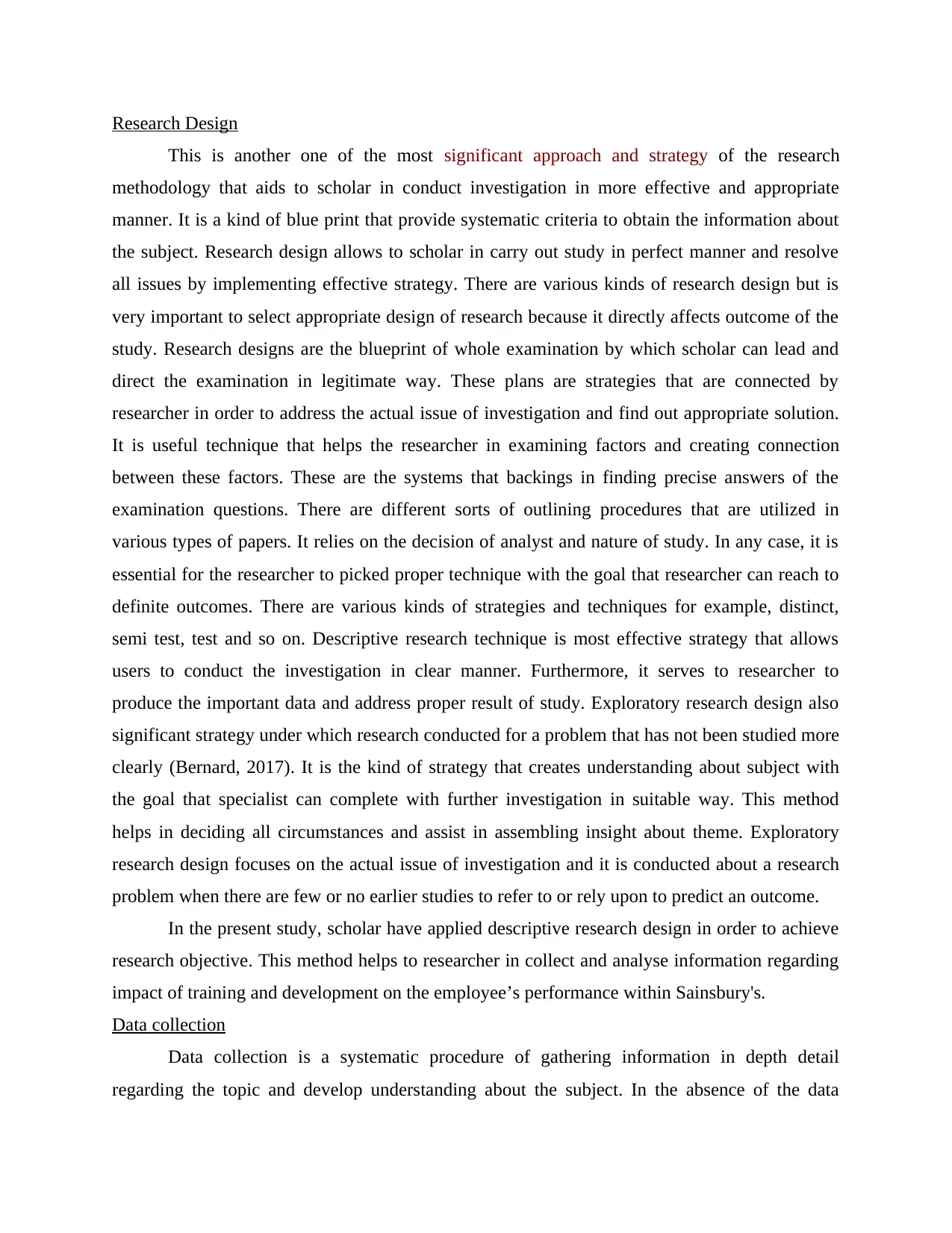
Research Design
This is another one of the most significant approach and strategy of the research
methodology that aids to scholar in conduct investigation in more effective and appropriate
manner. It is a kind of blue print that provide systematic criteria to obtain the information about
the subject. Research design allows to scholar in carry out study in perfect manner and resolve
all issues by implementing effective strategy. There are various kinds of research design but is
very important to select appropriate design of research because it directly affects outcome of the
study. Research designs are the blueprint of whole examination by which scholar can lead and
direct the examination in legitimate way. These plans are strategies that are connected by
researcher in order to address the actual issue of investigation and find out appropriate solution.
It is useful technique that helps the researcher in examining factors and creating connection
between these factors. These are the systems that backings in finding precise answers of the
examination questions. There are different sorts of outlining procedures that are utilized in
various types of papers. It relies on the decision of analyst and nature of study. In any case, it is
essential for the researcher to picked proper technique with the goal that researcher can reach to
definite outcomes. There are various kinds of strategies and techniques for example, distinct,
semi test, test and so on. Descriptive research technique is most effective strategy that allows
users to conduct the investigation in clear manner. Furthermore, it serves to researcher to
produce the important data and address proper result of study. Exploratory research design also
significant strategy under which research conducted for a problem that has not been studied more
clearly (Bernard, 2017). It is the kind of strategy that creates understanding about subject with
the goal that specialist can complete with further investigation in suitable way. This method
helps in deciding all circumstances and assist in assembling insight about theme. Exploratory
research design focuses on the actual issue of investigation and it is conducted about a research
problem when there are few or no earlier studies to refer to or rely upon to predict an outcome.
In the present study, scholar have applied descriptive research design in order to achieve
research objective. This method helps to researcher in collect and analyse information regarding
impact of training and development on the employee’s performance within Sainsbury's.
Data collection
Data collection is a systematic procedure of gathering information in depth detail
regarding the topic and develop understanding about the subject. In the absence of the data
This is another one of the most significant approach and strategy of the research
methodology that aids to scholar in conduct investigation in more effective and appropriate
manner. It is a kind of blue print that provide systematic criteria to obtain the information about
the subject. Research design allows to scholar in carry out study in perfect manner and resolve
all issues by implementing effective strategy. There are various kinds of research design but is
very important to select appropriate design of research because it directly affects outcome of the
study. Research designs are the blueprint of whole examination by which scholar can lead and
direct the examination in legitimate way. These plans are strategies that are connected by
researcher in order to address the actual issue of investigation and find out appropriate solution.
It is useful technique that helps the researcher in examining factors and creating connection
between these factors. These are the systems that backings in finding precise answers of the
examination questions. There are different sorts of outlining procedures that are utilized in
various types of papers. It relies on the decision of analyst and nature of study. In any case, it is
essential for the researcher to picked proper technique with the goal that researcher can reach to
definite outcomes. There are various kinds of strategies and techniques for example, distinct,
semi test, test and so on. Descriptive research technique is most effective strategy that allows
users to conduct the investigation in clear manner. Furthermore, it serves to researcher to
produce the important data and address proper result of study. Exploratory research design also
significant strategy under which research conducted for a problem that has not been studied more
clearly (Bernard, 2017). It is the kind of strategy that creates understanding about subject with
the goal that specialist can complete with further investigation in suitable way. This method
helps in deciding all circumstances and assist in assembling insight about theme. Exploratory
research design focuses on the actual issue of investigation and it is conducted about a research
problem when there are few or no earlier studies to refer to or rely upon to predict an outcome.
In the present study, scholar have applied descriptive research design in order to achieve
research objective. This method helps to researcher in collect and analyse information regarding
impact of training and development on the employee’s performance within Sainsbury's.
Data collection
Data collection is a systematic procedure of gathering information in depth detail
regarding the topic and develop understanding about the subject. In the absence of the data
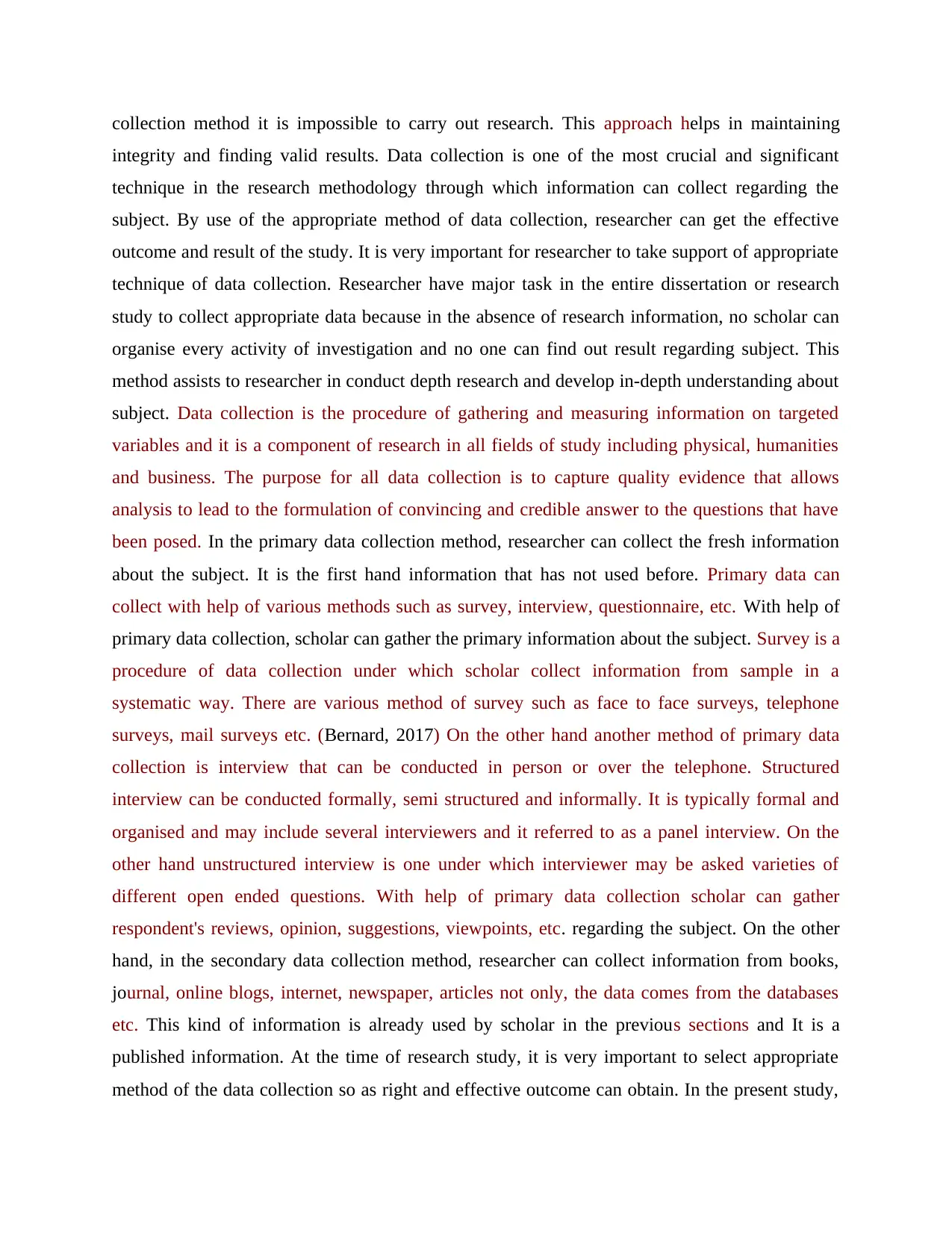
collection method it is impossible to carry out research. This approach helps in maintaining
integrity and finding valid results. Data collection is one of the most crucial and significant
technique in the research methodology through which information can collect regarding the
subject. By use of the appropriate method of data collection, researcher can get the effective
outcome and result of the study. It is very important for researcher to take support of appropriate
technique of data collection. Researcher have major task in the entire dissertation or research
study to collect appropriate data because in the absence of research information, no scholar can
organise every activity of investigation and no one can find out result regarding subject. This
method assists to researcher in conduct depth research and develop in-depth understanding about
subject. Data collection is the procedure of gathering and measuring information on targeted
variables and it is a component of research in all fields of study including physical, humanities
and business. The purpose for all data collection is to capture quality evidence that allows
analysis to lead to the formulation of convincing and credible answer to the questions that have
been posed. In the primary data collection method, researcher can collect the fresh information
about the subject. It is the first hand information that has not used before. Primary data can
collect with help of various methods such as survey, interview, questionnaire, etc. With help of
primary data collection, scholar can gather the primary information about the subject. Survey is a
procedure of data collection under which scholar collect information from sample in a
systematic way. There are various method of survey such as face to face surveys, telephone
surveys, mail surveys etc. (Bernard, 2017) On the other hand another method of primary data
collection is interview that can be conducted in person or over the telephone. Structured
interview can be conducted formally, semi structured and informally. It is typically formal and
organised and may include several interviewers and it referred to as a panel interview. On the
other hand unstructured interview is one under which interviewer may be asked varieties of
different open ended questions. With help of primary data collection scholar can gather
respondent's reviews, opinion, suggestions, viewpoints, etc. regarding the subject. On the other
hand, in the secondary data collection method, researcher can collect information from books,
journal, online blogs, internet, newspaper, articles not only, the data comes from the databases
etc. This kind of information is already used by scholar in the previous sections and It is a
published information. At the time of research study, it is very important to select appropriate
method of the data collection so as right and effective outcome can obtain. In the present study,
integrity and finding valid results. Data collection is one of the most crucial and significant
technique in the research methodology through which information can collect regarding the
subject. By use of the appropriate method of data collection, researcher can get the effective
outcome and result of the study. It is very important for researcher to take support of appropriate
technique of data collection. Researcher have major task in the entire dissertation or research
study to collect appropriate data because in the absence of research information, no scholar can
organise every activity of investigation and no one can find out result regarding subject. This
method assists to researcher in conduct depth research and develop in-depth understanding about
subject. Data collection is the procedure of gathering and measuring information on targeted
variables and it is a component of research in all fields of study including physical, humanities
and business. The purpose for all data collection is to capture quality evidence that allows
analysis to lead to the formulation of convincing and credible answer to the questions that have
been posed. In the primary data collection method, researcher can collect the fresh information
about the subject. It is the first hand information that has not used before. Primary data can
collect with help of various methods such as survey, interview, questionnaire, etc. With help of
primary data collection, scholar can gather the primary information about the subject. Survey is a
procedure of data collection under which scholar collect information from sample in a
systematic way. There are various method of survey such as face to face surveys, telephone
surveys, mail surveys etc. (Bernard, 2017) On the other hand another method of primary data
collection is interview that can be conducted in person or over the telephone. Structured
interview can be conducted formally, semi structured and informally. It is typically formal and
organised and may include several interviewers and it referred to as a panel interview. On the
other hand unstructured interview is one under which interviewer may be asked varieties of
different open ended questions. With help of primary data collection scholar can gather
respondent's reviews, opinion, suggestions, viewpoints, etc. regarding the subject. On the other
hand, in the secondary data collection method, researcher can collect information from books,
journal, online blogs, internet, newspaper, articles not only, the data comes from the databases
etc. This kind of information is already used by scholar in the previous sections and It is a
published information. At the time of research study, it is very important to select appropriate
method of the data collection so as right and effective outcome can obtain. In the present study,
Paraphrase This Document
Need a fresh take? Get an instant paraphrase of this document with our AI Paraphraser
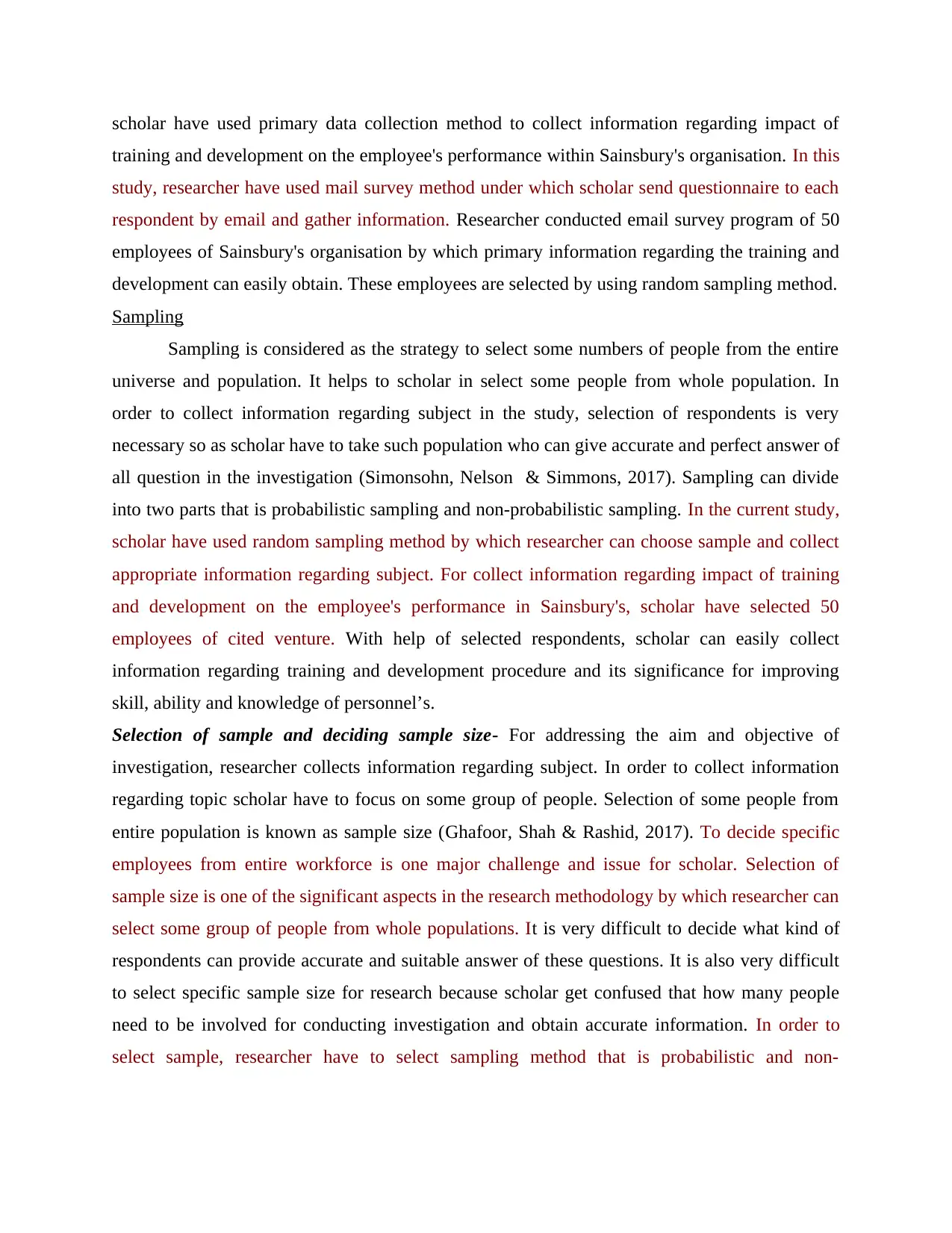
scholar have used primary data collection method to collect information regarding impact of
training and development on the employee's performance within Sainsbury's organisation. In this
study, researcher have used mail survey method under which scholar send questionnaire to each
respondent by email and gather information. Researcher conducted email survey program of 50
employees of Sainsbury's organisation by which primary information regarding the training and
development can easily obtain. These employees are selected by using random sampling method.
Sampling
Sampling is considered as the strategy to select some numbers of people from the entire
universe and population. It helps to scholar in select some people from whole population. In
order to collect information regarding subject in the study, selection of respondents is very
necessary so as scholar have to take such population who can give accurate and perfect answer of
all question in the investigation (Simonsohn, Nelson & Simmons, 2017). Sampling can divide
into two parts that is probabilistic sampling and non-probabilistic sampling. In the current study,
scholar have used random sampling method by which researcher can choose sample and collect
appropriate information regarding subject. For collect information regarding impact of training
and development on the employee's performance in Sainsbury's, scholar have selected 50
employees of cited venture. With help of selected respondents, scholar can easily collect
information regarding training and development procedure and its significance for improving
skill, ability and knowledge of personnel’s.
Selection of sample and deciding sample size- For addressing the aim and objective of
investigation, researcher collects information regarding subject. In order to collect information
regarding topic scholar have to focus on some group of people. Selection of some people from
entire population is known as sample size (Ghafoor, Shah & Rashid, 2017). To decide specific
employees from entire workforce is one major challenge and issue for scholar. Selection of
sample size is one of the significant aspects in the research methodology by which researcher can
select some group of people from whole populations. It is very difficult to decide what kind of
respondents can provide accurate and suitable answer of these questions. It is also very difficult
to select specific sample size for research because scholar get confused that how many people
need to be involved for conducting investigation and obtain accurate information. In order to
select sample, researcher have to select sampling method that is probabilistic and non-
training and development on the employee's performance within Sainsbury's organisation. In this
study, researcher have used mail survey method under which scholar send questionnaire to each
respondent by email and gather information. Researcher conducted email survey program of 50
employees of Sainsbury's organisation by which primary information regarding the training and
development can easily obtain. These employees are selected by using random sampling method.
Sampling
Sampling is considered as the strategy to select some numbers of people from the entire
universe and population. It helps to scholar in select some people from whole population. In
order to collect information regarding subject in the study, selection of respondents is very
necessary so as scholar have to take such population who can give accurate and perfect answer of
all question in the investigation (Simonsohn, Nelson & Simmons, 2017). Sampling can divide
into two parts that is probabilistic sampling and non-probabilistic sampling. In the current study,
scholar have used random sampling method by which researcher can choose sample and collect
appropriate information regarding subject. For collect information regarding impact of training
and development on the employee's performance in Sainsbury's, scholar have selected 50
employees of cited venture. With help of selected respondents, scholar can easily collect
information regarding training and development procedure and its significance for improving
skill, ability and knowledge of personnel’s.
Selection of sample and deciding sample size- For addressing the aim and objective of
investigation, researcher collects information regarding subject. In order to collect information
regarding topic scholar have to focus on some group of people. Selection of some people from
entire population is known as sample size (Ghafoor, Shah & Rashid, 2017). To decide specific
employees from entire workforce is one major challenge and issue for scholar. Selection of
sample size is one of the significant aspects in the research methodology by which researcher can
select some group of people from whole populations. It is very difficult to decide what kind of
respondents can provide accurate and suitable answer of these questions. It is also very difficult
to select specific sample size for research because scholar get confused that how many people
need to be involved for conducting investigation and obtain accurate information. In order to
select sample, researcher have to select sampling method that is probabilistic and non-
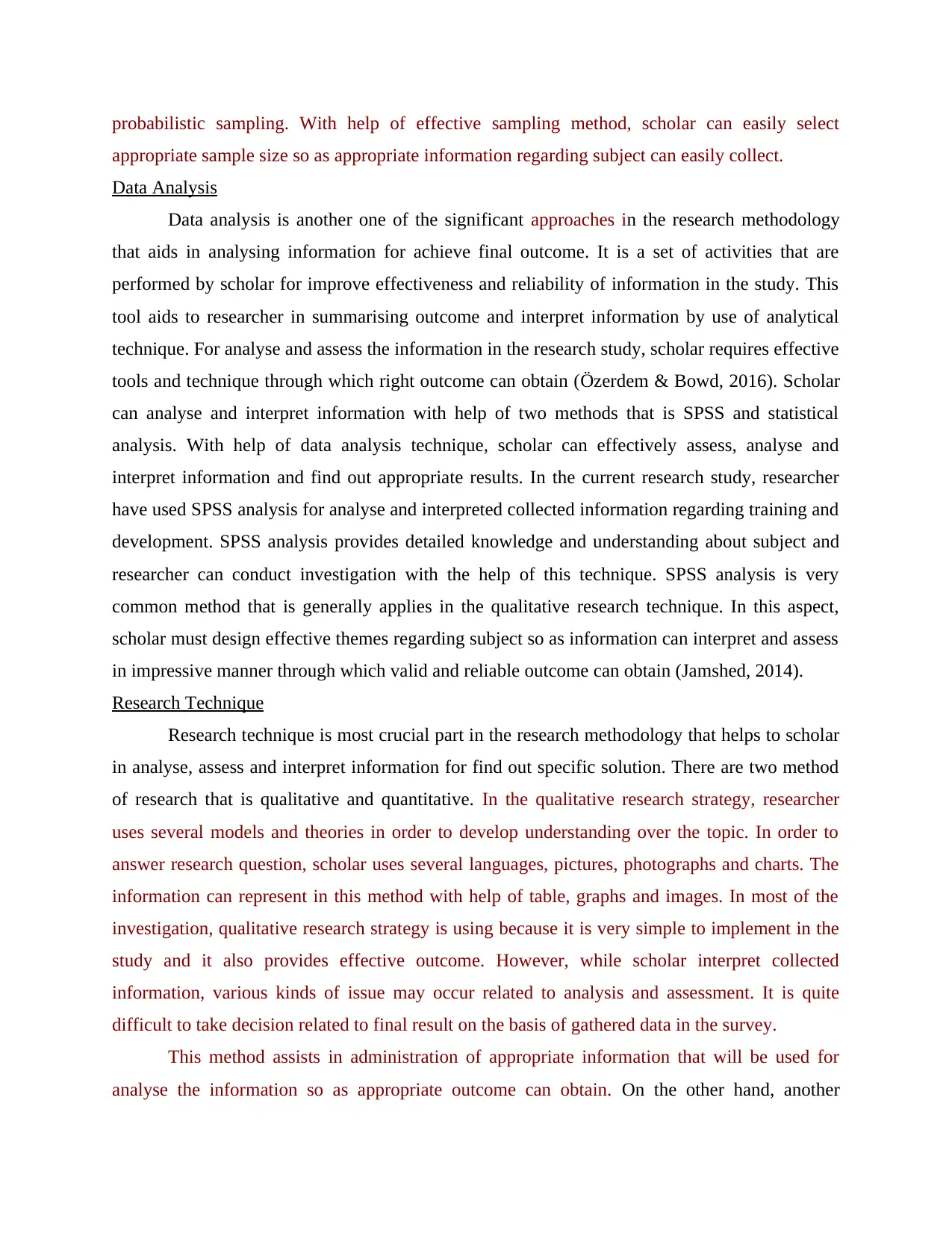
probabilistic sampling. With help of effective sampling method, scholar can easily select
appropriate sample size so as appropriate information regarding subject can easily collect.
Data Analysis
Data analysis is another one of the significant approaches in the research methodology
that aids in analysing information for achieve final outcome. It is a set of activities that are
performed by scholar for improve effectiveness and reliability of information in the study. This
tool aids to researcher in summarising outcome and interpret information by use of analytical
technique. For analyse and assess the information in the research study, scholar requires effective
tools and technique through which right outcome can obtain (Özerdem & Bowd, 2016). Scholar
can analyse and interpret information with help of two methods that is SPSS and statistical
analysis. With help of data analysis technique, scholar can effectively assess, analyse and
interpret information and find out appropriate results. In the current research study, researcher
have used SPSS analysis for analyse and interpreted collected information regarding training and
development. SPSS analysis provides detailed knowledge and understanding about subject and
researcher can conduct investigation with the help of this technique. SPSS analysis is very
common method that is generally applies in the qualitative research technique. In this aspect,
scholar must design effective themes regarding subject so as information can interpret and assess
in impressive manner through which valid and reliable outcome can obtain (Jamshed, 2014).
Research Technique
Research technique is most crucial part in the research methodology that helps to scholar
in analyse, assess and interpret information for find out specific solution. There are two method
of research that is qualitative and quantitative. In the qualitative research strategy, researcher
uses several models and theories in order to develop understanding over the topic. In order to
answer research question, scholar uses several languages, pictures, photographs and charts. The
information can represent in this method with help of table, graphs and images. In most of the
investigation, qualitative research strategy is using because it is very simple to implement in the
study and it also provides effective outcome. However, while scholar interpret collected
information, various kinds of issue may occur related to analysis and assessment. It is quite
difficult to take decision related to final result on the basis of gathered data in the survey.
This method assists in administration of appropriate information that will be used for
analyse the information so as appropriate outcome can obtain. On the other hand, another
appropriate sample size so as appropriate information regarding subject can easily collect.
Data Analysis
Data analysis is another one of the significant approaches in the research methodology
that aids in analysing information for achieve final outcome. It is a set of activities that are
performed by scholar for improve effectiveness and reliability of information in the study. This
tool aids to researcher in summarising outcome and interpret information by use of analytical
technique. For analyse and assess the information in the research study, scholar requires effective
tools and technique through which right outcome can obtain (Özerdem & Bowd, 2016). Scholar
can analyse and interpret information with help of two methods that is SPSS and statistical
analysis. With help of data analysis technique, scholar can effectively assess, analyse and
interpret information and find out appropriate results. In the current research study, researcher
have used SPSS analysis for analyse and interpreted collected information regarding training and
development. SPSS analysis provides detailed knowledge and understanding about subject and
researcher can conduct investigation with the help of this technique. SPSS analysis is very
common method that is generally applies in the qualitative research technique. In this aspect,
scholar must design effective themes regarding subject so as information can interpret and assess
in impressive manner through which valid and reliable outcome can obtain (Jamshed, 2014).
Research Technique
Research technique is most crucial part in the research methodology that helps to scholar
in analyse, assess and interpret information for find out specific solution. There are two method
of research that is qualitative and quantitative. In the qualitative research strategy, researcher
uses several models and theories in order to develop understanding over the topic. In order to
answer research question, scholar uses several languages, pictures, photographs and charts. The
information can represent in this method with help of table, graphs and images. In most of the
investigation, qualitative research strategy is using because it is very simple to implement in the
study and it also provides effective outcome. However, while scholar interpret collected
information, various kinds of issue may occur related to analysis and assessment. It is quite
difficult to take decision related to final result on the basis of gathered data in the survey.
This method assists in administration of appropriate information that will be used for
analyse the information so as appropriate outcome can obtain. On the other hand, another

technique is quantitative research technique that involves various numerical information and also
involves statistical calculations for find out the results (Schmidt & Hunter, 2014). Quantitative
research technique is different from the qualitative research method. Its implementation in the
research study is directly link with research aim and objective. This method directly affects final
outcome of study and provide valid and authentic information to individual regarding subject. In
order to implement quantitative research strategy, scholar required to take help of survey,
secondary information and observation. While data is collected through observation then there
are several ethics that considers by scholar. Major ethics are such as researcher have to provide
correct information about subject, maintain confidentiality regarding their personal information,
scholar do not force to anyone for taking participation in survey etc. using the quantitative
approach researcher uses the following SPSS package tools descriptive statistics, correlation,
anova test, regression analysis, etc.
Descriptive statistics- It is a summary statistic that quantitatively describes or summarises
features of a collection of information. this study will be focusing on mean, standard deviation
and etc. It is distinguished from inferential statistics that aims to summarise a sample rather than
use the data to learn about the population (Bernard, 2017). it simply provides results of questions
and measures with each other.
Correlation- This tool indicates positive and negative correlation among variables. It is a
statistical measure that indicate the extent to which two or more variable fluctuate together. It
determines the relationship between two variables that how closely they are related to each other.
For example – set goals and results obtained.
Anova- It is the significant technique of the SPSS by which variation among and between groups
can easily measure. It is used to analyse the difference among group means in a sample. It is
useful for compare and measure three or more group means for statistical significance Afful-
Broni, 2012). by this significance value is identified that shows how closely groups in sample
are related or varies with each other.
Regression- It is a statistical procedure for determine the relationship among variables. It is used
to analyse the relationship between variables to produce a specific result together. It states
relation between two variables. Also, shows strength between independent and dependent
variables. In linear regression each variable can be compared to another one.
involves statistical calculations for find out the results (Schmidt & Hunter, 2014). Quantitative
research technique is different from the qualitative research method. Its implementation in the
research study is directly link with research aim and objective. This method directly affects final
outcome of study and provide valid and authentic information to individual regarding subject. In
order to implement quantitative research strategy, scholar required to take help of survey,
secondary information and observation. While data is collected through observation then there
are several ethics that considers by scholar. Major ethics are such as researcher have to provide
correct information about subject, maintain confidentiality regarding their personal information,
scholar do not force to anyone for taking participation in survey etc. using the quantitative
approach researcher uses the following SPSS package tools descriptive statistics, correlation,
anova test, regression analysis, etc.
Descriptive statistics- It is a summary statistic that quantitatively describes or summarises
features of a collection of information. this study will be focusing on mean, standard deviation
and etc. It is distinguished from inferential statistics that aims to summarise a sample rather than
use the data to learn about the population (Bernard, 2017). it simply provides results of questions
and measures with each other.
Correlation- This tool indicates positive and negative correlation among variables. It is a
statistical measure that indicate the extent to which two or more variable fluctuate together. It
determines the relationship between two variables that how closely they are related to each other.
For example – set goals and results obtained.
Anova- It is the significant technique of the SPSS by which variation among and between groups
can easily measure. It is used to analyse the difference among group means in a sample. It is
useful for compare and measure three or more group means for statistical significance Afful-
Broni, 2012). by this significance value is identified that shows how closely groups in sample
are related or varies with each other.
Regression- It is a statistical procedure for determine the relationship among variables. It is used
to analyse the relationship between variables to produce a specific result together. It states
relation between two variables. Also, shows strength between independent and dependent
variables. In linear regression each variable can be compared to another one.
Secure Best Marks with AI Grader
Need help grading? Try our AI Grader for instant feedback on your assignments.
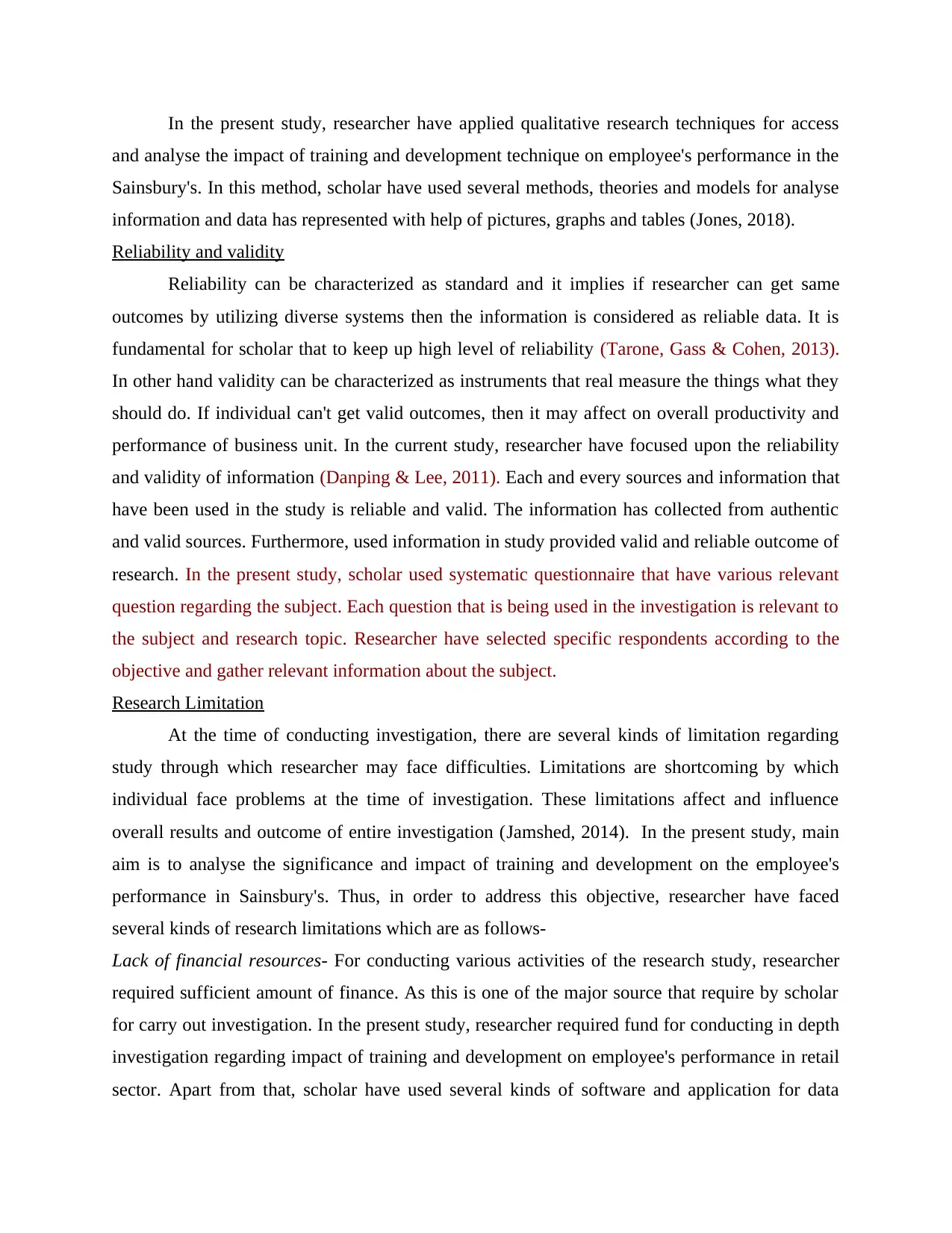
In the present study, researcher have applied qualitative research techniques for access
and analyse the impact of training and development technique on employee's performance in the
Sainsbury's. In this method, scholar have used several methods, theories and models for analyse
information and data has represented with help of pictures, graphs and tables (Jones, 2018).
Reliability and validity
Reliability can be characterized as standard and it implies if researcher can get same
outcomes by utilizing diverse systems then the information is considered as reliable data. It is
fundamental for scholar that to keep up high level of reliability (Tarone, Gass & Cohen, 2013).
In other hand validity can be characterized as instruments that real measure the things what they
should do. If individual can't get valid outcomes, then it may affect on overall productivity and
performance of business unit. In the current study, researcher have focused upon the reliability
and validity of information (Danping & Lee, 2011). Each and every sources and information that
have been used in the study is reliable and valid. The information has collected from authentic
and valid sources. Furthermore, used information in study provided valid and reliable outcome of
research. In the present study, scholar used systematic questionnaire that have various relevant
question regarding the subject. Each question that is being used in the investigation is relevant to
the subject and research topic. Researcher have selected specific respondents according to the
objective and gather relevant information about the subject.
Research Limitation
At the time of conducting investigation, there are several kinds of limitation regarding
study through which researcher may face difficulties. Limitations are shortcoming by which
individual face problems at the time of investigation. These limitations affect and influence
overall results and outcome of entire investigation (Jamshed, 2014). In the present study, main
aim is to analyse the significance and impact of training and development on the employee's
performance in Sainsbury's. Thus, in order to address this objective, researcher have faced
several kinds of research limitations which are as follows-
Lack of financial resources- For conducting various activities of the research study, researcher
required sufficient amount of finance. As this is one of the major source that require by scholar
for carry out investigation. In the present study, researcher required fund for conducting in depth
investigation regarding impact of training and development on employee's performance in retail
sector. Apart from that, scholar have used several kinds of software and application for data
and analyse the impact of training and development technique on employee's performance in the
Sainsbury's. In this method, scholar have used several methods, theories and models for analyse
information and data has represented with help of pictures, graphs and tables (Jones, 2018).
Reliability and validity
Reliability can be characterized as standard and it implies if researcher can get same
outcomes by utilizing diverse systems then the information is considered as reliable data. It is
fundamental for scholar that to keep up high level of reliability (Tarone, Gass & Cohen, 2013).
In other hand validity can be characterized as instruments that real measure the things what they
should do. If individual can't get valid outcomes, then it may affect on overall productivity and
performance of business unit. In the current study, researcher have focused upon the reliability
and validity of information (Danping & Lee, 2011). Each and every sources and information that
have been used in the study is reliable and valid. The information has collected from authentic
and valid sources. Furthermore, used information in study provided valid and reliable outcome of
research. In the present study, scholar used systematic questionnaire that have various relevant
question regarding the subject. Each question that is being used in the investigation is relevant to
the subject and research topic. Researcher have selected specific respondents according to the
objective and gather relevant information about the subject.
Research Limitation
At the time of conducting investigation, there are several kinds of limitation regarding
study through which researcher may face difficulties. Limitations are shortcoming by which
individual face problems at the time of investigation. These limitations affect and influence
overall results and outcome of entire investigation (Jamshed, 2014). In the present study, main
aim is to analyse the significance and impact of training and development on the employee's
performance in Sainsbury's. Thus, in order to address this objective, researcher have faced
several kinds of research limitations which are as follows-
Lack of financial resources- For conducting various activities of the research study, researcher
required sufficient amount of finance. As this is one of the major source that require by scholar
for carry out investigation. In the present study, researcher required fund for conducting in depth
investigation regarding impact of training and development on employee's performance in retail
sector. Apart from that, scholar have used several kinds of software and application for data
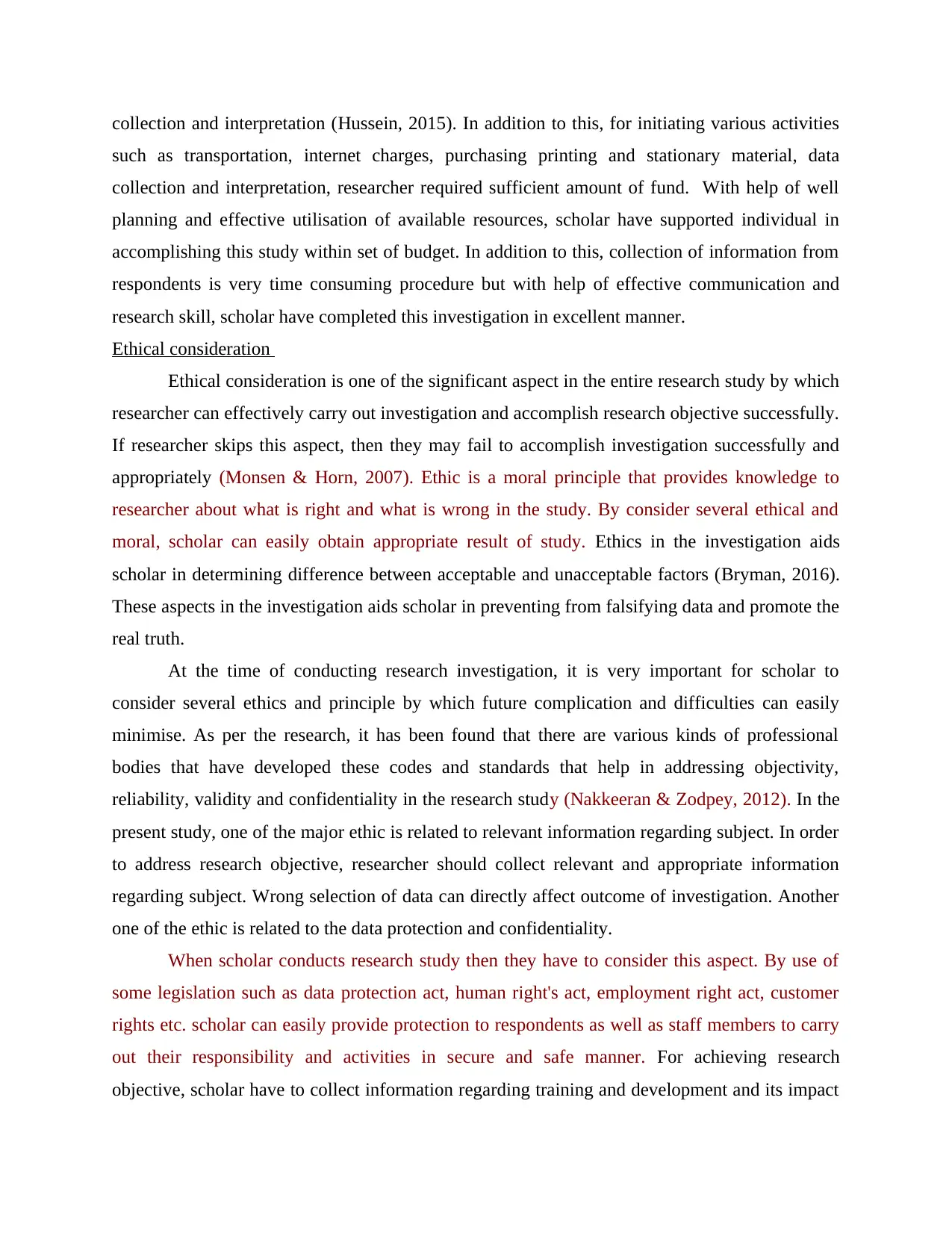
collection and interpretation (Hussein, 2015). In addition to this, for initiating various activities
such as transportation, internet charges, purchasing printing and stationary material, data
collection and interpretation, researcher required sufficient amount of fund. With help of well
planning and effective utilisation of available resources, scholar have supported individual in
accomplishing this study within set of budget. In addition to this, collection of information from
respondents is very time consuming procedure but with help of effective communication and
research skill, scholar have completed this investigation in excellent manner.
Ethical consideration
Ethical consideration is one of the significant aspect in the entire research study by which
researcher can effectively carry out investigation and accomplish research objective successfully.
If researcher skips this aspect, then they may fail to accomplish investigation successfully and
appropriately (Monsen & Horn, 2007). Ethic is a moral principle that provides knowledge to
researcher about what is right and what is wrong in the study. By consider several ethical and
moral, scholar can easily obtain appropriate result of study. Ethics in the investigation aids
scholar in determining difference between acceptable and unacceptable factors (Bryman, 2016).
These aspects in the investigation aids scholar in preventing from falsifying data and promote the
real truth.
At the time of conducting research investigation, it is very important for scholar to
consider several ethics and principle by which future complication and difficulties can easily
minimise. As per the research, it has been found that there are various kinds of professional
bodies that have developed these codes and standards that help in addressing objectivity,
reliability, validity and confidentiality in the research study (Nakkeeran & Zodpey, 2012). In the
present study, one of the major ethic is related to relevant information regarding subject. In order
to address research objective, researcher should collect relevant and appropriate information
regarding subject. Wrong selection of data can directly affect outcome of investigation. Another
one of the ethic is related to the data protection and confidentiality.
When scholar conducts research study then they have to consider this aspect. By use of
some legislation such as data protection act, human right's act, employment right act, customer
rights etc. scholar can easily provide protection to respondents as well as staff members to carry
out their responsibility and activities in secure and safe manner. For achieving research
objective, scholar have to collect information regarding training and development and its impact
such as transportation, internet charges, purchasing printing and stationary material, data
collection and interpretation, researcher required sufficient amount of fund. With help of well
planning and effective utilisation of available resources, scholar have supported individual in
accomplishing this study within set of budget. In addition to this, collection of information from
respondents is very time consuming procedure but with help of effective communication and
research skill, scholar have completed this investigation in excellent manner.
Ethical consideration
Ethical consideration is one of the significant aspect in the entire research study by which
researcher can effectively carry out investigation and accomplish research objective successfully.
If researcher skips this aspect, then they may fail to accomplish investigation successfully and
appropriately (Monsen & Horn, 2007). Ethic is a moral principle that provides knowledge to
researcher about what is right and what is wrong in the study. By consider several ethical and
moral, scholar can easily obtain appropriate result of study. Ethics in the investigation aids
scholar in determining difference between acceptable and unacceptable factors (Bryman, 2016).
These aspects in the investigation aids scholar in preventing from falsifying data and promote the
real truth.
At the time of conducting research investigation, it is very important for scholar to
consider several ethics and principle by which future complication and difficulties can easily
minimise. As per the research, it has been found that there are various kinds of professional
bodies that have developed these codes and standards that help in addressing objectivity,
reliability, validity and confidentiality in the research study (Nakkeeran & Zodpey, 2012). In the
present study, one of the major ethic is related to relevant information regarding subject. In order
to address research objective, researcher should collect relevant and appropriate information
regarding subject. Wrong selection of data can directly affect outcome of investigation. Another
one of the ethic is related to the data protection and confidentiality.
When scholar conducts research study then they have to consider this aspect. By use of
some legislation such as data protection act, human right's act, employment right act, customer
rights etc. scholar can easily provide protection to respondents as well as staff members to carry
out their responsibility and activities in secure and safe manner. For achieving research
objective, scholar have to collect information regarding training and development and its impact

upon personnel’s of Sainsbury's corporation. Scholar has to protect information of Sainsbury's
company and should not make any misuse of this information. Apart from this, another major
ethical consideration in the investigation is maintaining integrity and quality of information in
the entire investigation. In order to maintain quality and integrity, researcher should collect
secondary information from authentic sources. In addition to this, respondents should gather
primary information by use appropriate sample size and kind of respondents. Furthermore,
scholar can also consider some data protection legislation while investigation conduct.
company and should not make any misuse of this information. Apart from this, another major
ethical consideration in the investigation is maintaining integrity and quality of information in
the entire investigation. In order to maintain quality and integrity, researcher should collect
secondary information from authentic sources. In addition to this, respondents should gather
primary information by use appropriate sample size and kind of respondents. Furthermore,
scholar can also consider some data protection legislation while investigation conduct.
Paraphrase This Document
Need a fresh take? Get an instant paraphrase of this document with our AI Paraphraser

CHAPTER 4 DATA ANALYSIS
4.1 Chapter overview
In this chapter the data collected by researcher will be analysed by using SPSS analysis.
Here, researcher should have knowledge of the method or tool that is used in analysis of data so
that useful information can be obtained along with this, it must be kept in mind to present data in
such a manner that it is easily understood by user. If data is not analysed in proper way then aims
and objectives will not be achieved. The results and analysis of data collected for present
dissertation is described below.
4.2 Testing & theory
This is basically in context to the testing tool used in this investigation. This involved the
application of SPSS as a scientific method that has included a logical and consistent flow of
research. For this, experiments have been done on the collected set of data with support of
hypothesis to reach at refined goals that are not only well documented, but has also depicted well
tested results. It will help in doing relevant testing on data that is collected so that useful
information can be obtained. Testing theory helps in interpreting data in each question. Usually,
it is related to using SPSS in analysis of data. It is important to effectively interpret data so that
results of on and off the job training methods are obtained separately. By this it will be easy to
find out difference between both methods and its impact on employee performance.
4.3 Descriptive analysis
Statistics
Providingtraining
regularlyhasena
bledinmaintainin
gefficiency
Traininghelpedin
efficiencyandach
ievinggoals
Trainingatregular
lyleadstoeffectiv
ecommunication
Interactingwithcu
stomersenabledi
nsolvingproblem
sandsatisfication
trainingmethodsh
elpsinmultitaskin
gleadingtoattaini
nggoals
N Valid 50 50 50 50 50
Mean 1.4600 3.0400 2.4600 2.0600 1.4000
Median 1.0000 3.0000 2.0000 2.0000 1.0000
Mode 1.00 3.00a 1.00 2.00 1.00
Std. Deviation .83812 1.44222 1.31258 .31364 .49487
Variance .702 2.080 1.723 .098 .245
Sum 73.00 152.00 123.00 103.00 70.00
4.1 Chapter overview
In this chapter the data collected by researcher will be analysed by using SPSS analysis.
Here, researcher should have knowledge of the method or tool that is used in analysis of data so
that useful information can be obtained along with this, it must be kept in mind to present data in
such a manner that it is easily understood by user. If data is not analysed in proper way then aims
and objectives will not be achieved. The results and analysis of data collected for present
dissertation is described below.
4.2 Testing & theory
This is basically in context to the testing tool used in this investigation. This involved the
application of SPSS as a scientific method that has included a logical and consistent flow of
research. For this, experiments have been done on the collected set of data with support of
hypothesis to reach at refined goals that are not only well documented, but has also depicted well
tested results. It will help in doing relevant testing on data that is collected so that useful
information can be obtained. Testing theory helps in interpreting data in each question. Usually,
it is related to using SPSS in analysis of data. It is important to effectively interpret data so that
results of on and off the job training methods are obtained separately. By this it will be easy to
find out difference between both methods and its impact on employee performance.
4.3 Descriptive analysis
Statistics
Providingtraining
regularlyhasena
bledinmaintainin
gefficiency
Traininghelpedin
efficiencyandach
ievinggoals
Trainingatregular
lyleadstoeffectiv
ecommunication
Interactingwithcu
stomersenabledi
nsolvingproblem
sandsatisfication
trainingmethodsh
elpsinmultitaskin
gleadingtoattaini
nggoals
N Valid 50 50 50 50 50
Mean 1.4600 3.0400 2.4600 2.0600 1.4000
Median 1.0000 3.0000 2.0000 2.0000 1.0000
Mode 1.00 3.00a 1.00 2.00 1.00
Std. Deviation .83812 1.44222 1.31258 .31364 .49487
Variance .702 2.080 1.723 .098 .245
Sum 73.00 152.00 123.00 103.00 70.00
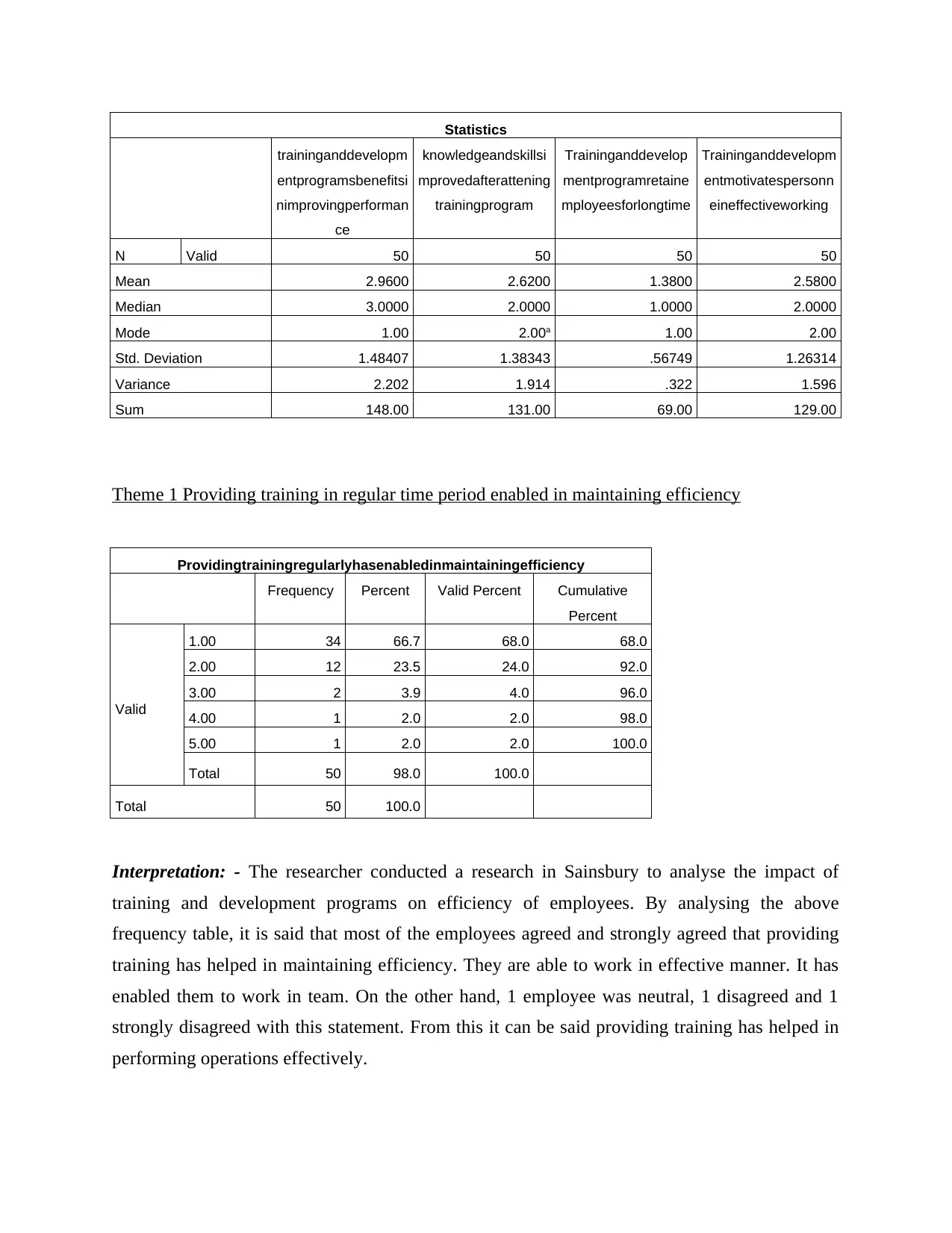
Statistics
traininganddevelopm
entprogramsbenefitsi
nimprovingperforman
ce
knowledgeandskillsi
mprovedafterattening
trainingprogram
Traininganddevelop
mentprogramretaine
mployeesforlongtime
Traininganddevelopm
entmotivatespersonn
eineffectiveworking
N Valid 50 50 50 50
Mean 2.9600 2.6200 1.3800 2.5800
Median 3.0000 2.0000 1.0000 2.0000
Mode 1.00 2.00a 1.00 2.00
Std. Deviation 1.48407 1.38343 .56749 1.26314
Variance 2.202 1.914 .322 1.596
Sum 148.00 131.00 69.00 129.00
Theme 1 Providing training in regular time period enabled in maintaining efficiency
Providingtrainingregularlyhasenabledinmaintainingefficiency
Frequency Percent Valid Percent Cumulative
Percent
Valid
1.00 34 66.7 68.0 68.0
2.00 12 23.5 24.0 92.0
3.00 2 3.9 4.0 96.0
4.00 1 2.0 2.0 98.0
5.00 1 2.0 2.0 100.0
Total 50 98.0 100.0
Total 50 100.0
Interpretation: - The researcher conducted a research in Sainsbury to analyse the impact of
training and development programs on efficiency of employees. By analysing the above
frequency table, it is said that most of the employees agreed and strongly agreed that providing
training has helped in maintaining efficiency. They are able to work in effective manner. It has
enabled them to work in team. On the other hand, 1 employee was neutral, 1 disagreed and 1
strongly disagreed with this statement. From this it can be said providing training has helped in
performing operations effectively.
traininganddevelopm
entprogramsbenefitsi
nimprovingperforman
ce
knowledgeandskillsi
mprovedafterattening
trainingprogram
Traininganddevelop
mentprogramretaine
mployeesforlongtime
Traininganddevelopm
entmotivatespersonn
eineffectiveworking
N Valid 50 50 50 50
Mean 2.9600 2.6200 1.3800 2.5800
Median 3.0000 2.0000 1.0000 2.0000
Mode 1.00 2.00a 1.00 2.00
Std. Deviation 1.48407 1.38343 .56749 1.26314
Variance 2.202 1.914 .322 1.596
Sum 148.00 131.00 69.00 129.00
Theme 1 Providing training in regular time period enabled in maintaining efficiency
Providingtrainingregularlyhasenabledinmaintainingefficiency
Frequency Percent Valid Percent Cumulative
Percent
Valid
1.00 34 66.7 68.0 68.0
2.00 12 23.5 24.0 92.0
3.00 2 3.9 4.0 96.0
4.00 1 2.0 2.0 98.0
5.00 1 2.0 2.0 100.0
Total 50 98.0 100.0
Total 50 100.0
Interpretation: - The researcher conducted a research in Sainsbury to analyse the impact of
training and development programs on efficiency of employees. By analysing the above
frequency table, it is said that most of the employees agreed and strongly agreed that providing
training has helped in maintaining efficiency. They are able to work in effective manner. It has
enabled them to work in team. On the other hand, 1 employee was neutral, 1 disagreed and 1
strongly disagreed with this statement. From this it can be said providing training has helped in
performing operations effectively.
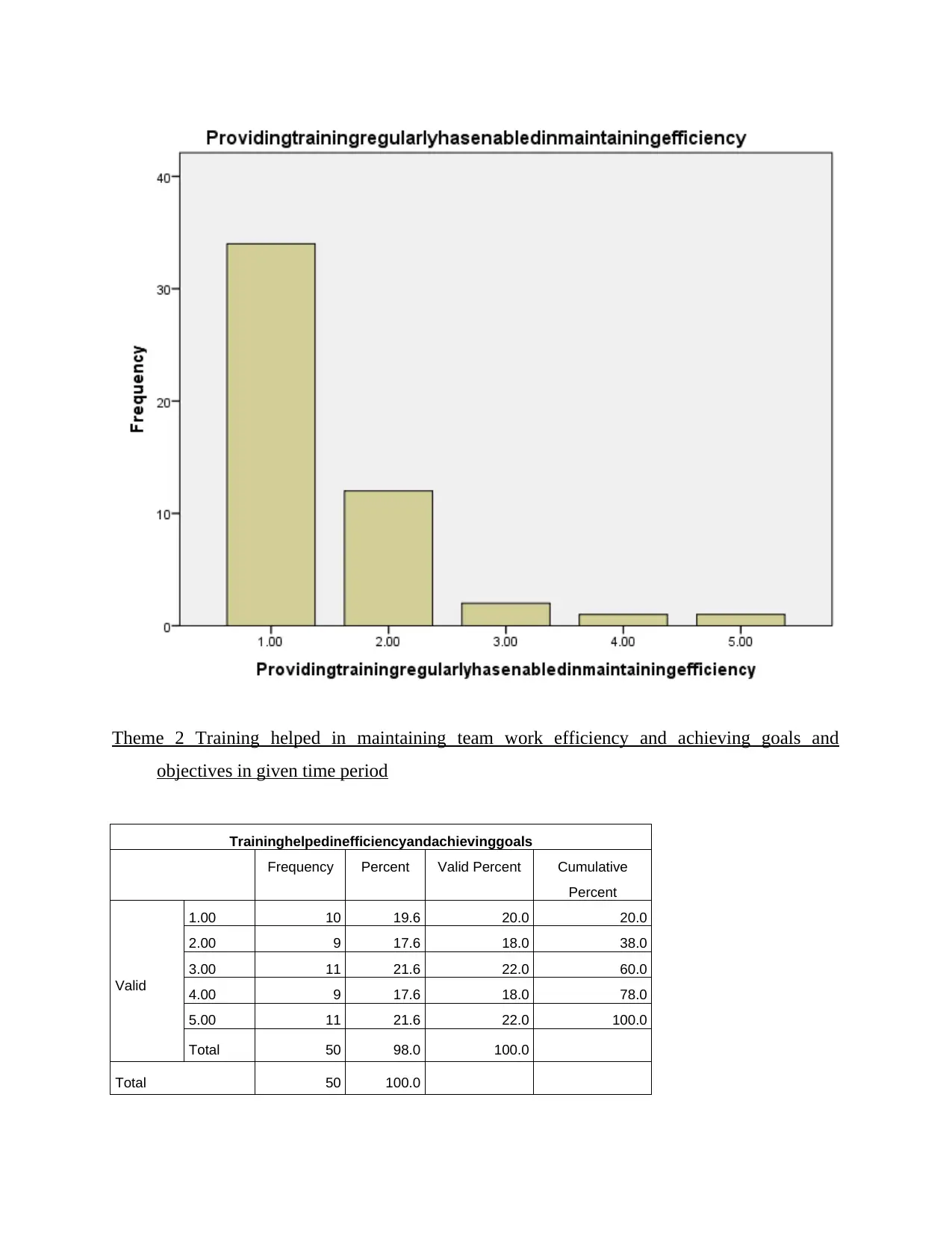
Theme 2 Training helped in maintaining team work efficiency and achieving goals and
objectives in given time period
Traininghelpedinefficiencyandachievinggoals
Frequency Percent Valid Percent Cumulative
Percent
Valid
1.00 10 19.6 20.0 20.0
2.00 9 17.6 18.0 38.0
3.00 11 21.6 22.0 60.0
4.00 9 17.6 18.0 78.0
5.00 11 21.6 22.0 100.0
Total 50 98.0 100.0
Total 50 100.0
objectives in given time period
Traininghelpedinefficiencyandachievinggoals
Frequency Percent Valid Percent Cumulative
Percent
Valid
1.00 10 19.6 20.0 20.0
2.00 9 17.6 18.0 38.0
3.00 11 21.6 22.0 60.0
4.00 9 17.6 18.0 78.0
5.00 11 21.6 22.0 100.0
Total 50 98.0 100.0
Total 50 100.0
Secure Best Marks with AI Grader
Need help grading? Try our AI Grader for instant feedback on your assignments.
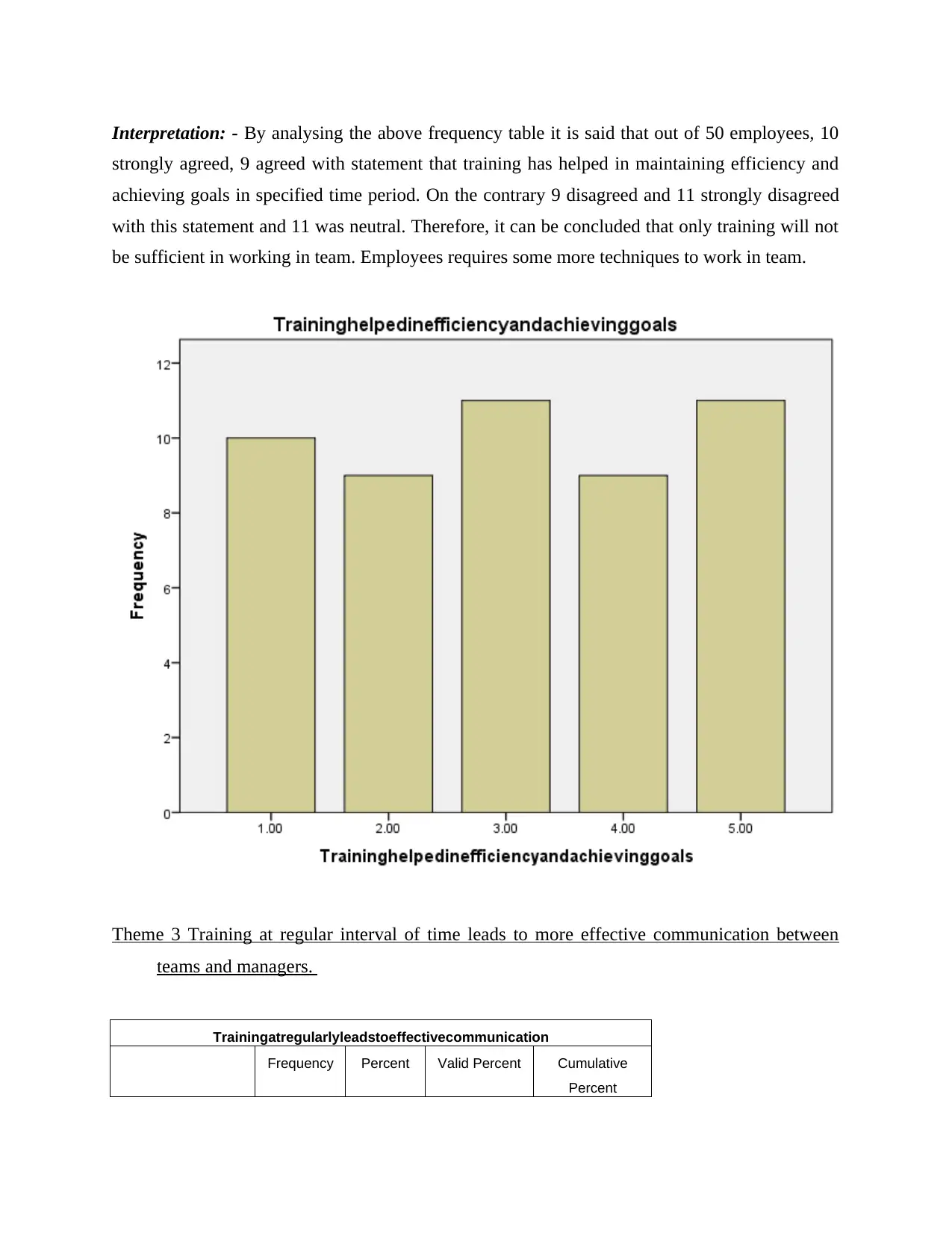
Interpretation: - By analysing the above frequency table it is said that out of 50 employees, 10
strongly agreed, 9 agreed with statement that training has helped in maintaining efficiency and
achieving goals in specified time period. On the contrary 9 disagreed and 11 strongly disagreed
with this statement and 11 was neutral. Therefore, it can be concluded that only training will not
be sufficient in working in team. Employees requires some more techniques to work in team.
Theme 3 Training at regular interval of time leads to more effective communication between
teams and managers.
Trainingatregularlyleadstoeffectivecommunication
Frequency Percent Valid Percent Cumulative
Percent
strongly agreed, 9 agreed with statement that training has helped in maintaining efficiency and
achieving goals in specified time period. On the contrary 9 disagreed and 11 strongly disagreed
with this statement and 11 was neutral. Therefore, it can be concluded that only training will not
be sufficient in working in team. Employees requires some more techniques to work in team.
Theme 3 Training at regular interval of time leads to more effective communication between
teams and managers.
Trainingatregularlyleadstoeffectivecommunication
Frequency Percent Valid Percent Cumulative
Percent
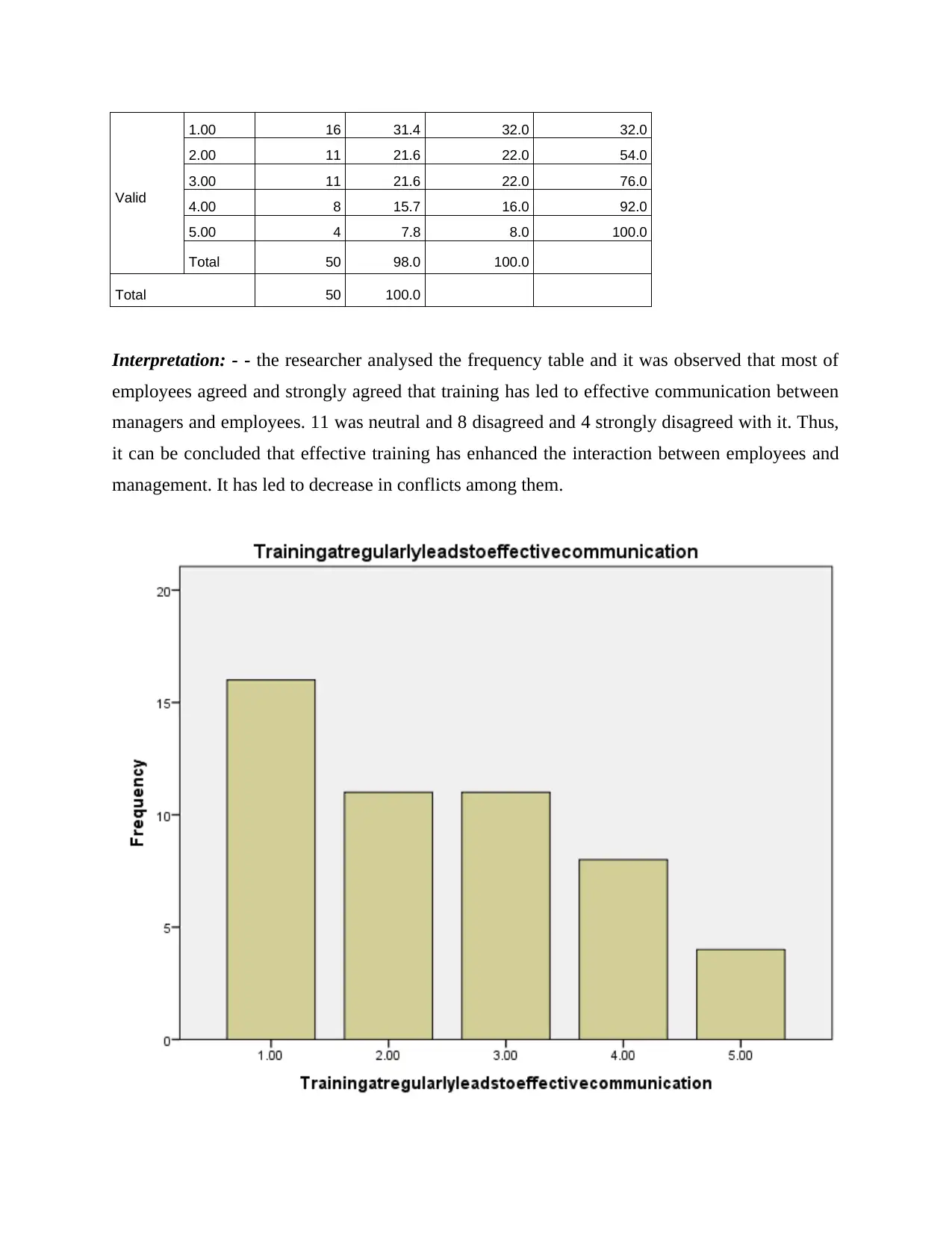
Valid
1.00 16 31.4 32.0 32.0
2.00 11 21.6 22.0 54.0
3.00 11 21.6 22.0 76.0
4.00 8 15.7 16.0 92.0
5.00 4 7.8 8.0 100.0
Total 50 98.0 100.0
Total 50 100.0
Interpretation: - - the researcher analysed the frequency table and it was observed that most of
employees agreed and strongly agreed that training has led to effective communication between
managers and employees. 11 was neutral and 8 disagreed and 4 strongly disagreed with it. Thus,
it can be concluded that effective training has enhanced the interaction between employees and
management. It has led to decrease in conflicts among them.
1.00 16 31.4 32.0 32.0
2.00 11 21.6 22.0 54.0
3.00 11 21.6 22.0 76.0
4.00 8 15.7 16.0 92.0
5.00 4 7.8 8.0 100.0
Total 50 98.0 100.0
Total 50 100.0
Interpretation: - - the researcher analysed the frequency table and it was observed that most of
employees agreed and strongly agreed that training has led to effective communication between
managers and employees. 11 was neutral and 8 disagreed and 4 strongly disagreed with it. Thus,
it can be concluded that effective training has enhanced the interaction between employees and
management. It has led to decrease in conflicts among them.

Theme 4 Interacting with customers enabled in solving their problems and satisfying them to a
great extent
Interactingwithcustomersenabledinsolvingproblemsandsatisfication
Frequency Percent Valid Percent Cumulative
Percent
Valid
1.00 1 2.0 2.0 2.0
2.00 45 88.2 90.0 92.0
3.00 4 7.8 8.0 100.0
Total 50 98.0 100.0
Total 50 100.0
Interpretation: - - the researcher analysed the frequency table and it was observed that effective
training has enabled employees to solve customer problems quickly. Out of 50, 45 strongly
agreed most of employees agreed and strongly agreed that training has led to effective
communication between managers and employees. 11 was neutral and 8 disagreed and 4 strongly
disagreed with it. Thus, it can be concluded that effective training has enhanced the interaction
between employees and management. Due to these goals are been attained in specified time
period.
great extent
Interactingwithcustomersenabledinsolvingproblemsandsatisfication
Frequency Percent Valid Percent Cumulative
Percent
Valid
1.00 1 2.0 2.0 2.0
2.00 45 88.2 90.0 92.0
3.00 4 7.8 8.0 100.0
Total 50 98.0 100.0
Total 50 100.0
Interpretation: - - the researcher analysed the frequency table and it was observed that effective
training has enabled employees to solve customer problems quickly. Out of 50, 45 strongly
agreed most of employees agreed and strongly agreed that training has led to effective
communication between managers and employees. 11 was neutral and 8 disagreed and 4 strongly
disagreed with it. Thus, it can be concluded that effective training has enhanced the interaction
between employees and management. Due to these goals are been attained in specified time
period.
Paraphrase This Document
Need a fresh take? Get an instant paraphrase of this document with our AI Paraphraser
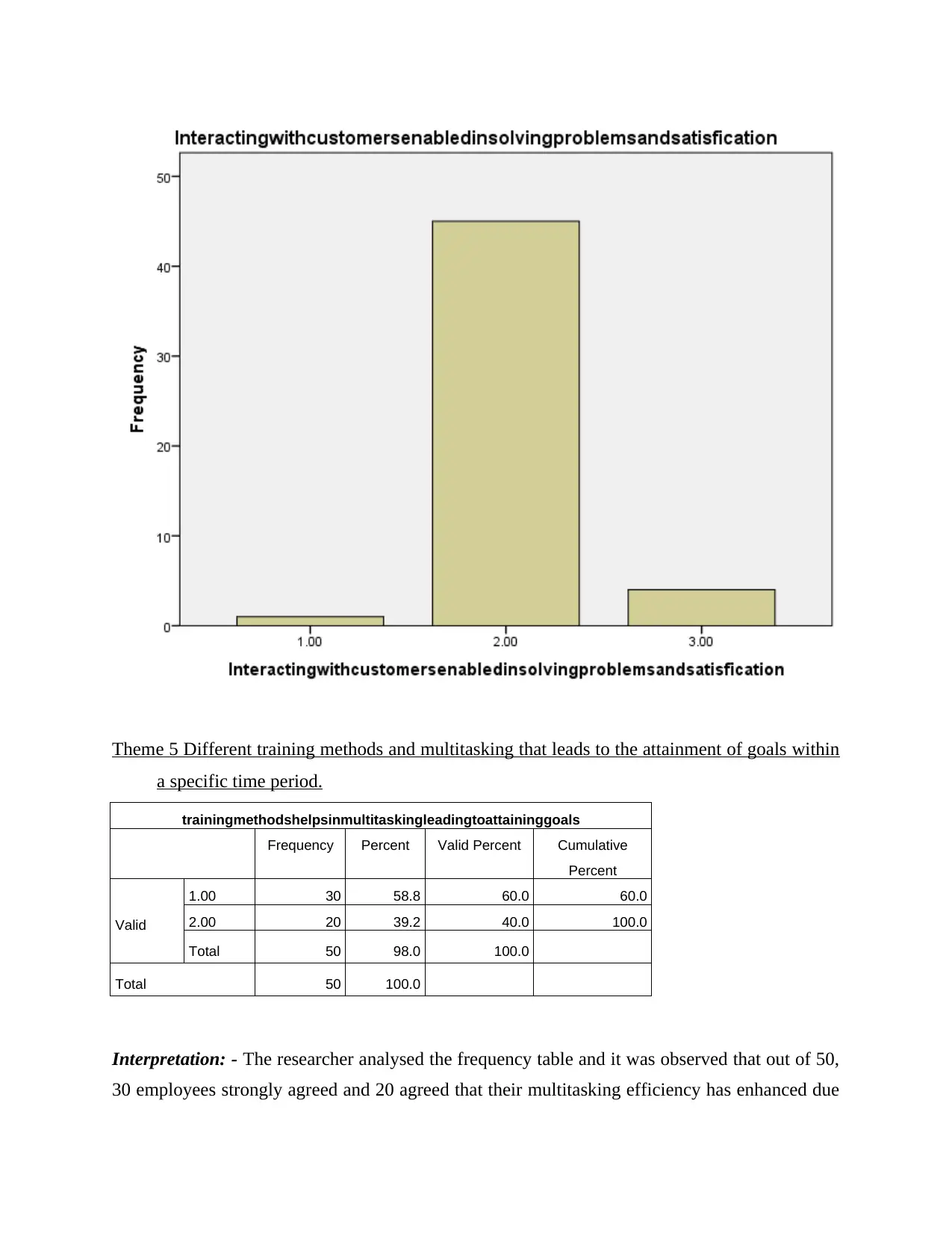
Theme 5 Different training methods and multitasking that leads to the attainment of goals within
a specific time period.
trainingmethodshelpsinmultitaskingleadingtoattaininggoals
Frequency Percent Valid Percent Cumulative
Percent
Valid
1.00 30 58.8 60.0 60.0
2.00 20 39.2 40.0 100.0
Total 50 98.0 100.0
Total 50 100.0
Interpretation: - The researcher analysed the frequency table and it was observed that out of 50,
30 employees strongly agreed and 20 agreed that their multitasking efficiency has enhanced due
a specific time period.
trainingmethodshelpsinmultitaskingleadingtoattaininggoals
Frequency Percent Valid Percent Cumulative
Percent
Valid
1.00 30 58.8 60.0 60.0
2.00 20 39.2 40.0 100.0
Total 50 98.0 100.0
Total 50 100.0
Interpretation: - The researcher analysed the frequency table and it was observed that out of 50,
30 employees strongly agreed and 20 agreed that their multitasking efficiency has enhanced due
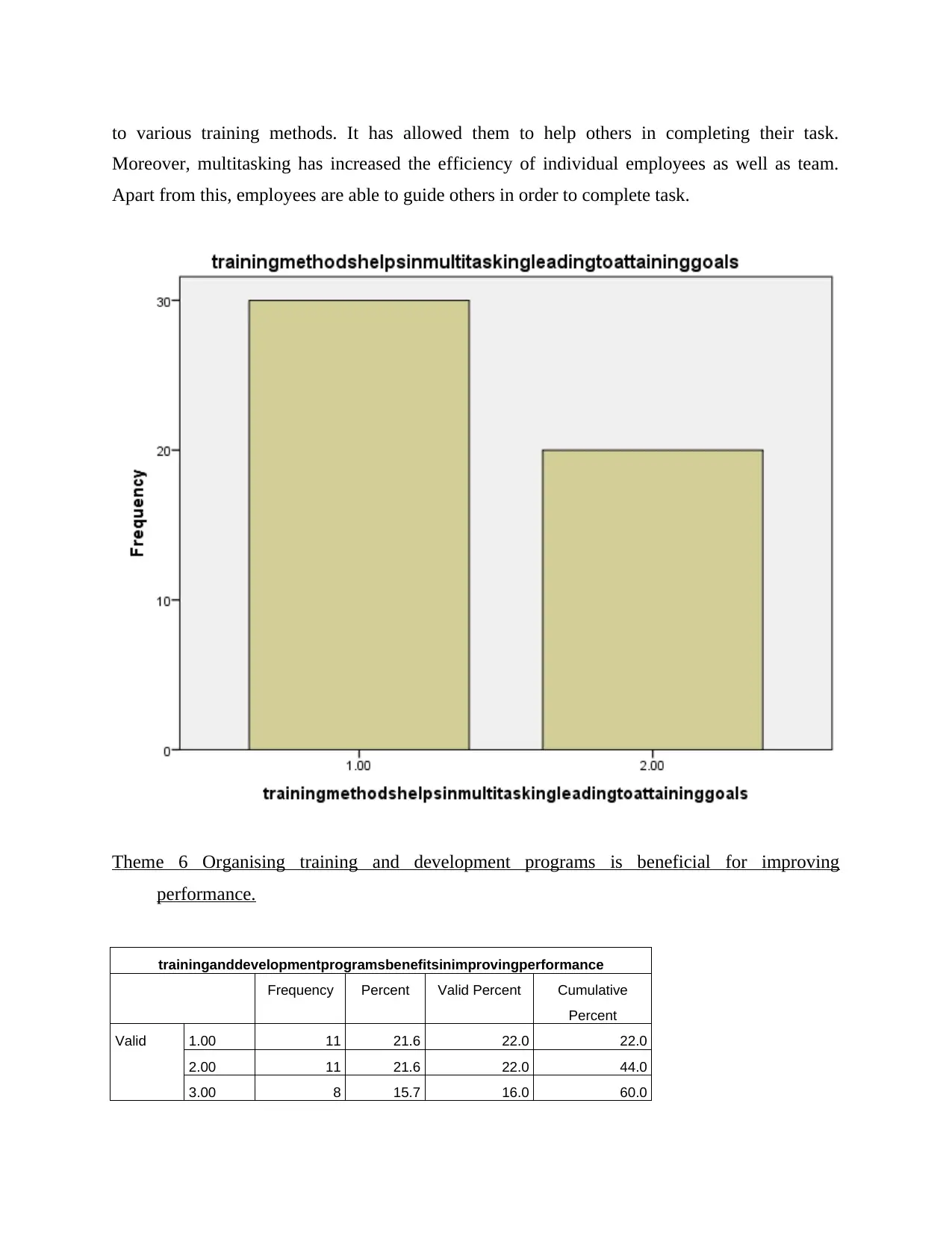
to various training methods. It has allowed them to help others in completing their task.
Moreover, multitasking has increased the efficiency of individual employees as well as team.
Apart from this, employees are able to guide others in order to complete task.
Theme 6 Organising training and development programs is beneficial for improving
performance.
traininganddevelopmentprogramsbenefitsinimprovingperformance
Frequency Percent Valid Percent Cumulative
Percent
Valid 1.00 11 21.6 22.0 22.0
2.00 11 21.6 22.0 44.0
3.00 8 15.7 16.0 60.0
Moreover, multitasking has increased the efficiency of individual employees as well as team.
Apart from this, employees are able to guide others in order to complete task.
Theme 6 Organising training and development programs is beneficial for improving
performance.
traininganddevelopmentprogramsbenefitsinimprovingperformance
Frequency Percent Valid Percent Cumulative
Percent
Valid 1.00 11 21.6 22.0 22.0
2.00 11 21.6 22.0 44.0
3.00 8 15.7 16.0 60.0

4.00 9 17.6 18.0 78.0
5.00 11 21.6 22.0 100.0
Total 50 98.0 100.0
Total 50 100.0
Interpretation: - By analysing the above frequency table it is said that out of 50 employees, 10
strongly agreed, 9 agreed with statement that training has helped in maintaining efficiency and
achieving goals in specified time period. On the contrary 9 disagreed and 11 strongly disagreed
with this statement and 11 was neutral. Therefore, it can be concluded that only training will not
be sufficient in working in team. Employees requires some more methods or ways to work in
team.
5.00 11 21.6 22.0 100.0
Total 50 98.0 100.0
Total 50 100.0
Interpretation: - By analysing the above frequency table it is said that out of 50 employees, 10
strongly agreed, 9 agreed with statement that training has helped in maintaining efficiency and
achieving goals in specified time period. On the contrary 9 disagreed and 11 strongly disagreed
with this statement and 11 was neutral. Therefore, it can be concluded that only training will not
be sufficient in working in team. Employees requires some more methods or ways to work in
team.
Secure Best Marks with AI Grader
Need help grading? Try our AI Grader for instant feedback on your assignments.
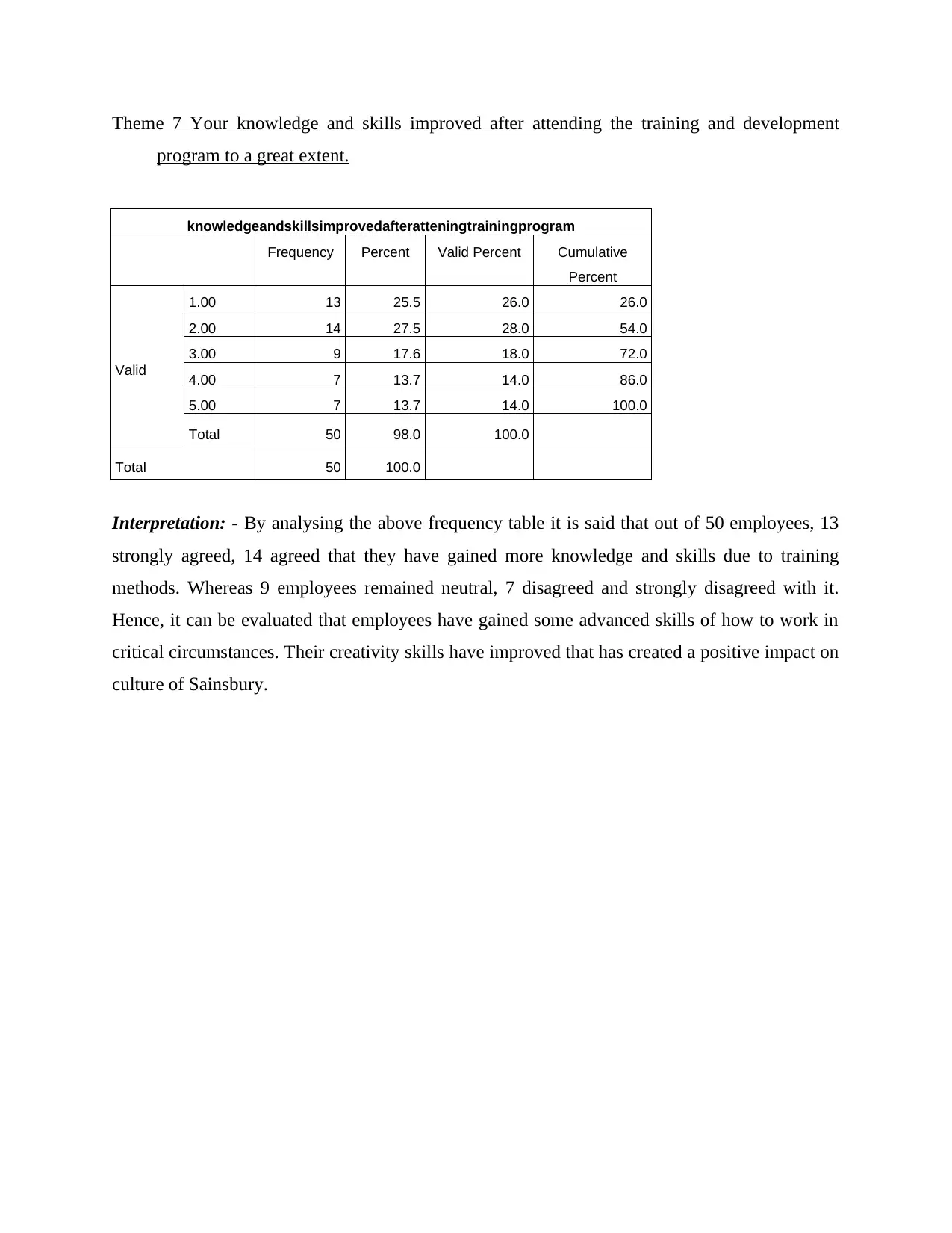
Theme 7 Your knowledge and skills improved after attending the training and development
program to a great extent.
knowledgeandskillsimprovedafteratteningtrainingprogram
Frequency Percent Valid Percent Cumulative
Percent
Valid
1.00 13 25.5 26.0 26.0
2.00 14 27.5 28.0 54.0
3.00 9 17.6 18.0 72.0
4.00 7 13.7 14.0 86.0
5.00 7 13.7 14.0 100.0
Total 50 98.0 100.0
Total 50 100.0
Interpretation: - By analysing the above frequency table it is said that out of 50 employees, 13
strongly agreed, 14 agreed that they have gained more knowledge and skills due to training
methods. Whereas 9 employees remained neutral, 7 disagreed and strongly disagreed with it.
Hence, it can be evaluated that employees have gained some advanced skills of how to work in
critical circumstances. Their creativity skills have improved that has created a positive impact on
culture of Sainsbury.
program to a great extent.
knowledgeandskillsimprovedafteratteningtrainingprogram
Frequency Percent Valid Percent Cumulative
Percent
Valid
1.00 13 25.5 26.0 26.0
2.00 14 27.5 28.0 54.0
3.00 9 17.6 18.0 72.0
4.00 7 13.7 14.0 86.0
5.00 7 13.7 14.0 100.0
Total 50 98.0 100.0
Total 50 100.0
Interpretation: - By analysing the above frequency table it is said that out of 50 employees, 13
strongly agreed, 14 agreed that they have gained more knowledge and skills due to training
methods. Whereas 9 employees remained neutral, 7 disagreed and strongly disagreed with it.
Hence, it can be evaluated that employees have gained some advanced skills of how to work in
critical circumstances. Their creativity skills have improved that has created a positive impact on
culture of Sainsbury.
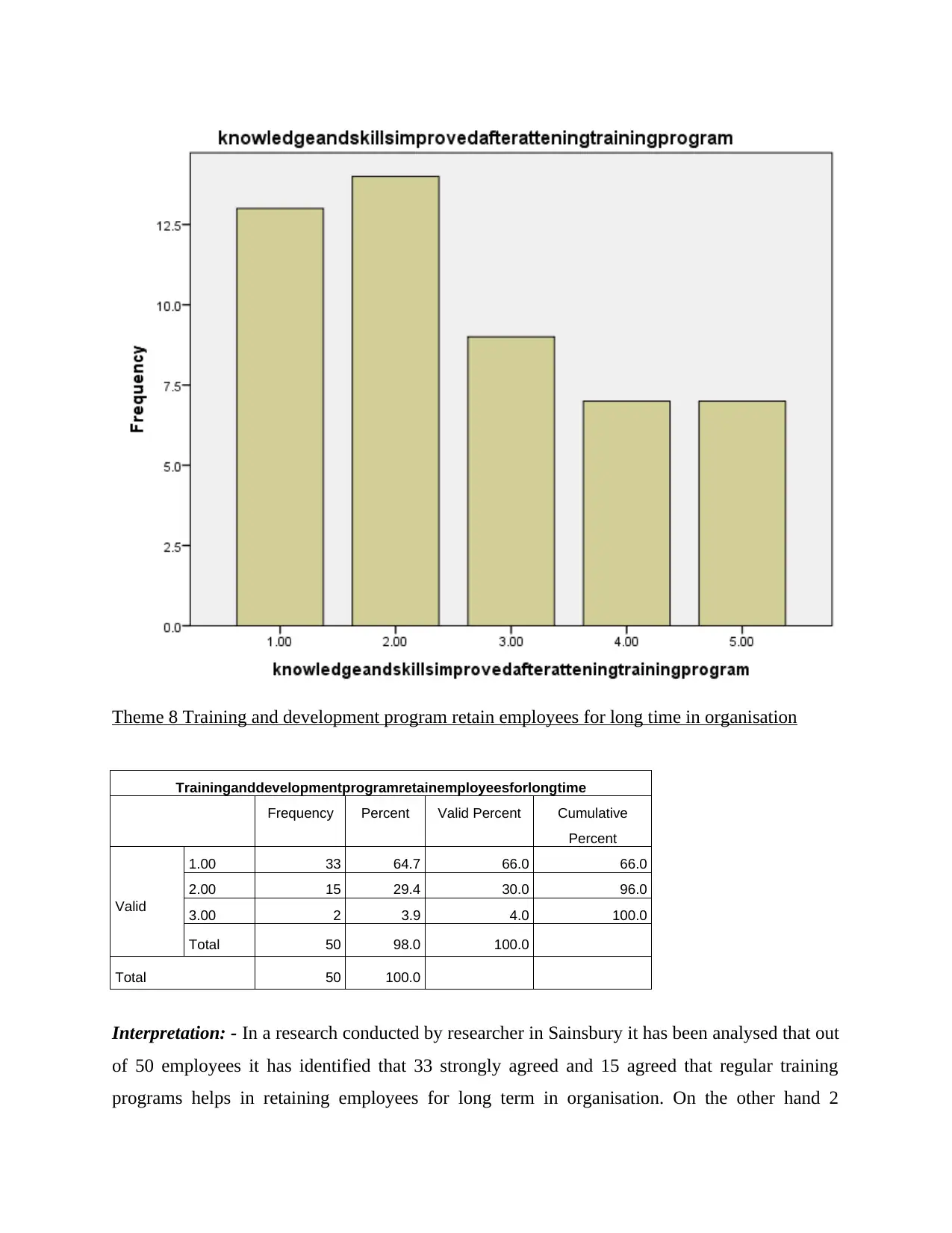
Theme 8 Training and development program retain employees for long time in organisation
Traininganddevelopmentprogramretainemployeesforlongtime
Frequency Percent Valid Percent Cumulative
Percent
Valid
1.00 33 64.7 66.0 66.0
2.00 15 29.4 30.0 96.0
3.00 2 3.9 4.0 100.0
Total 50 98.0 100.0
Total 50 100.0
Interpretation: - In a research conducted by researcher in Sainsbury it has been analysed that out
of 50 employees it has identified that 33 strongly agreed and 15 agreed that regular training
programs helps in retaining employees for long term in organisation. On the other hand 2
Traininganddevelopmentprogramretainemployeesforlongtime
Frequency Percent Valid Percent Cumulative
Percent
Valid
1.00 33 64.7 66.0 66.0
2.00 15 29.4 30.0 96.0
3.00 2 3.9 4.0 100.0
Total 50 98.0 100.0
Total 50 100.0
Interpretation: - In a research conducted by researcher in Sainsbury it has been analysed that out
of 50 employees it has identified that 33 strongly agreed and 15 agreed that regular training
programs helps in retaining employees for long term in organisation. On the other hand 2
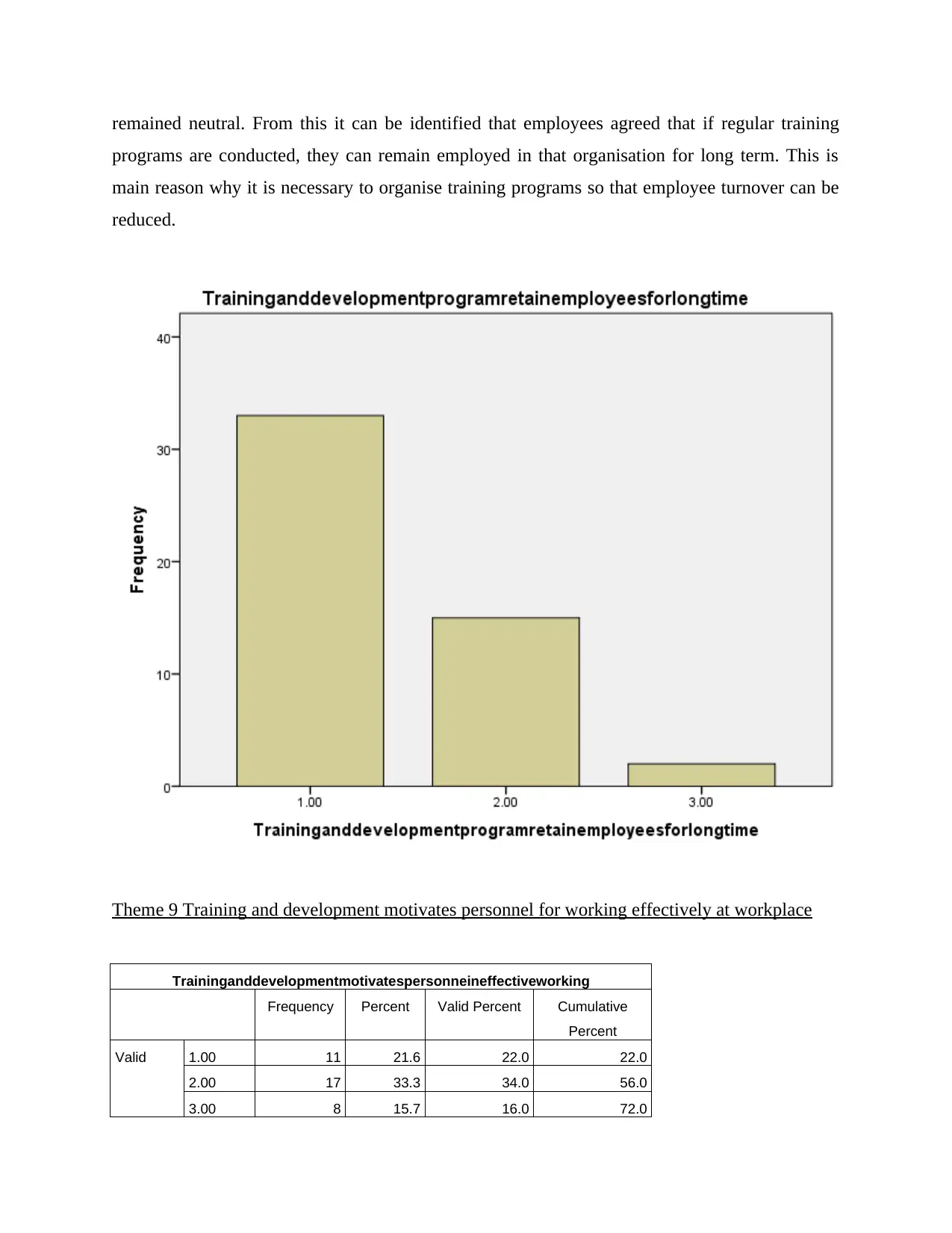
remained neutral. From this it can be identified that employees agreed that if regular training
programs are conducted, they can remain employed in that organisation for long term. This is
main reason why it is necessary to organise training programs so that employee turnover can be
reduced.
Theme 9 Training and development motivates personnel for working effectively at workplace
Traininganddevelopmentmotivatespersonneineffectiveworking
Frequency Percent Valid Percent Cumulative
Percent
Valid 1.00 11 21.6 22.0 22.0
2.00 17 33.3 34.0 56.0
3.00 8 15.7 16.0 72.0
programs are conducted, they can remain employed in that organisation for long term. This is
main reason why it is necessary to organise training programs so that employee turnover can be
reduced.
Theme 9 Training and development motivates personnel for working effectively at workplace
Traininganddevelopmentmotivatespersonneineffectiveworking
Frequency Percent Valid Percent Cumulative
Percent
Valid 1.00 11 21.6 22.0 22.0
2.00 17 33.3 34.0 56.0
3.00 8 15.7 16.0 72.0
Paraphrase This Document
Need a fresh take? Get an instant paraphrase of this document with our AI Paraphraser
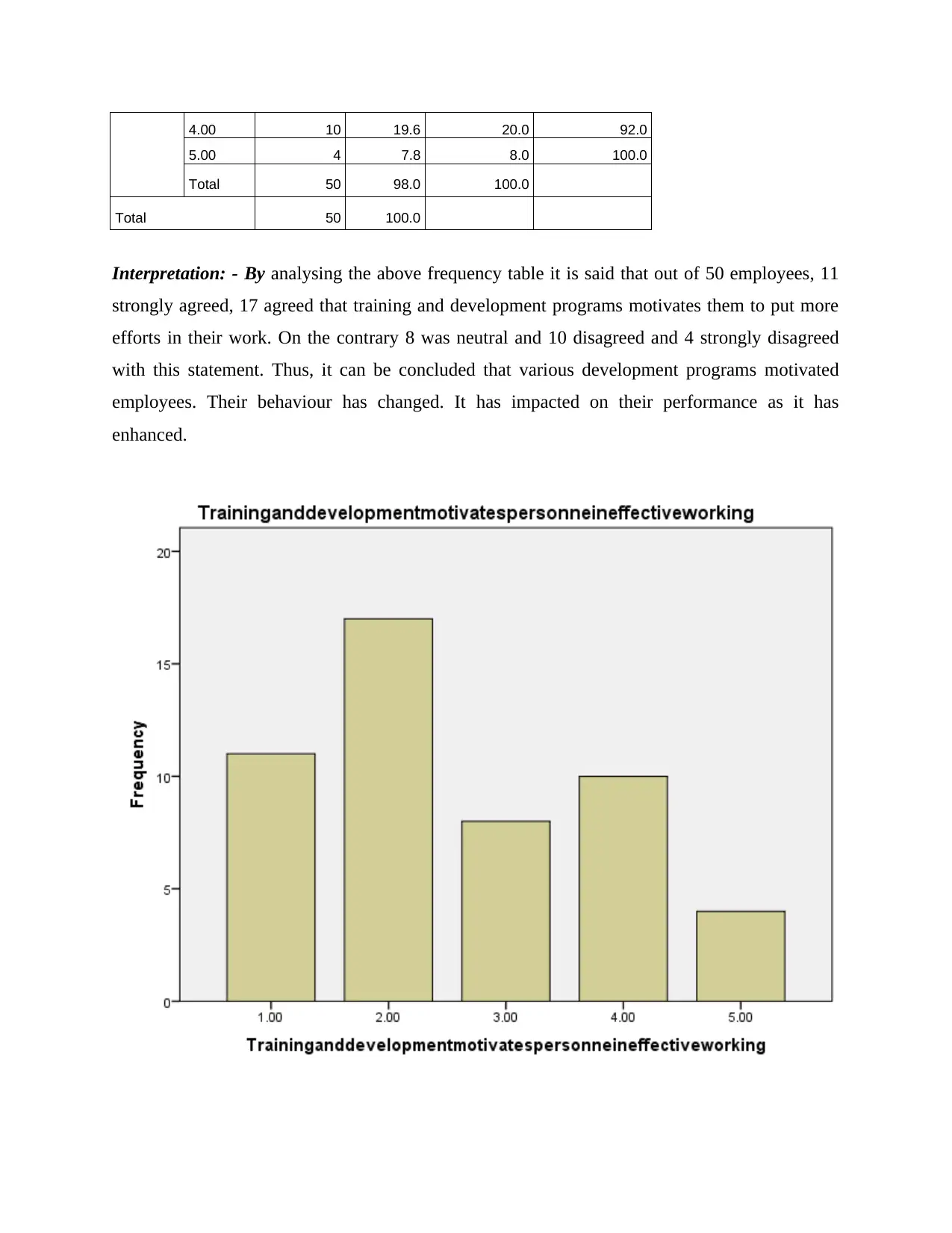
4.00 10 19.6 20.0 92.0
5.00 4 7.8 8.0 100.0
Total 50 98.0 100.0
Total 50 100.0
Interpretation: - By analysing the above frequency table it is said that out of 50 employees, 11
strongly agreed, 17 agreed that training and development programs motivates them to put more
efforts in their work. On the contrary 8 was neutral and 10 disagreed and 4 strongly disagreed
with this statement. Thus, it can be concluded that various development programs motivated
employees. Their behaviour has changed. It has impacted on their performance as it has
enhanced.
5.00 4 7.8 8.0 100.0
Total 50 98.0 100.0
Total 50 100.0
Interpretation: - By analysing the above frequency table it is said that out of 50 employees, 11
strongly agreed, 17 agreed that training and development programs motivates them to put more
efforts in their work. On the contrary 8 was neutral and 10 disagreed and 4 strongly disagreed
with this statement. Thus, it can be concluded that various development programs motivated
employees. Their behaviour has changed. It has impacted on their performance as it has
enhanced.
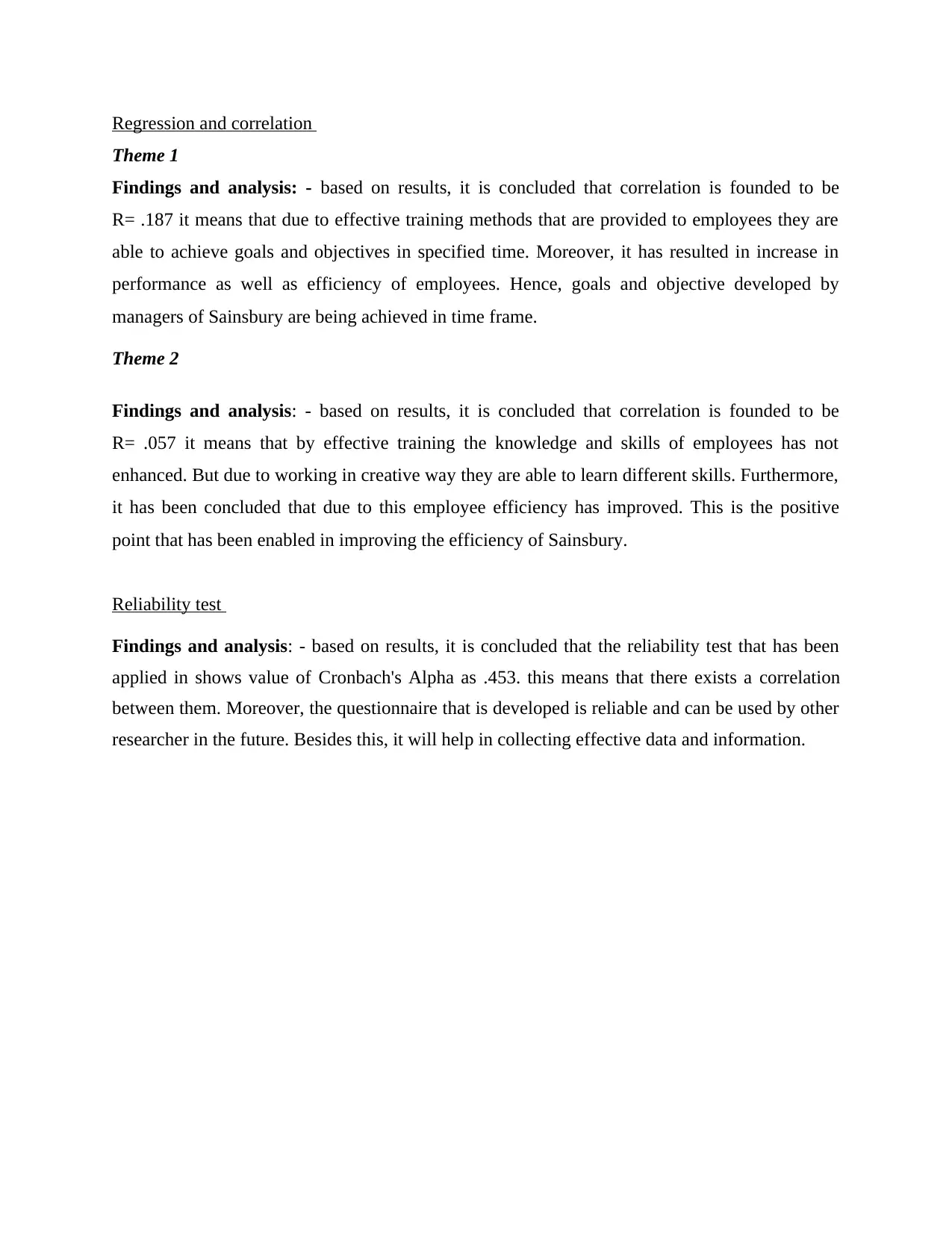
Regression and correlation
Theme 1
Findings and analysis: - based on results, it is concluded that correlation is founded to be
R= .187 it means that due to effective training methods that are provided to employees they are
able to achieve goals and objectives in specified time. Moreover, it has resulted in increase in
performance as well as efficiency of employees. Hence, goals and objective developed by
managers of Sainsbury are being achieved in time frame.
Theme 2
Findings and analysis: - based on results, it is concluded that correlation is founded to be
R= .057 it means that by effective training the knowledge and skills of employees has not
enhanced. But due to working in creative way they are able to learn different skills. Furthermore,
it has been concluded that due to this employee efficiency has improved. This is the positive
point that has been enabled in improving the efficiency of Sainsbury.
Reliability test
Findings and analysis: - based on results, it is concluded that the reliability test that has been
applied in shows value of Cronbach's Alpha as .453. this means that there exists a correlation
between them. Moreover, the questionnaire that is developed is reliable and can be used by other
researcher in the future. Besides this, it will help in collecting effective data and information.
Theme 1
Findings and analysis: - based on results, it is concluded that correlation is founded to be
R= .187 it means that due to effective training methods that are provided to employees they are
able to achieve goals and objectives in specified time. Moreover, it has resulted in increase in
performance as well as efficiency of employees. Hence, goals and objective developed by
managers of Sainsbury are being achieved in time frame.
Theme 2
Findings and analysis: - based on results, it is concluded that correlation is founded to be
R= .057 it means that by effective training the knowledge and skills of employees has not
enhanced. But due to working in creative way they are able to learn different skills. Furthermore,
it has been concluded that due to this employee efficiency has improved. This is the positive
point that has been enabled in improving the efficiency of Sainsbury.
Reliability test
Findings and analysis: - based on results, it is concluded that the reliability test that has been
applied in shows value of Cronbach's Alpha as .453. this means that there exists a correlation
between them. Moreover, the questionnaire that is developed is reliable and can be used by other
researcher in the future. Besides this, it will help in collecting effective data and information.
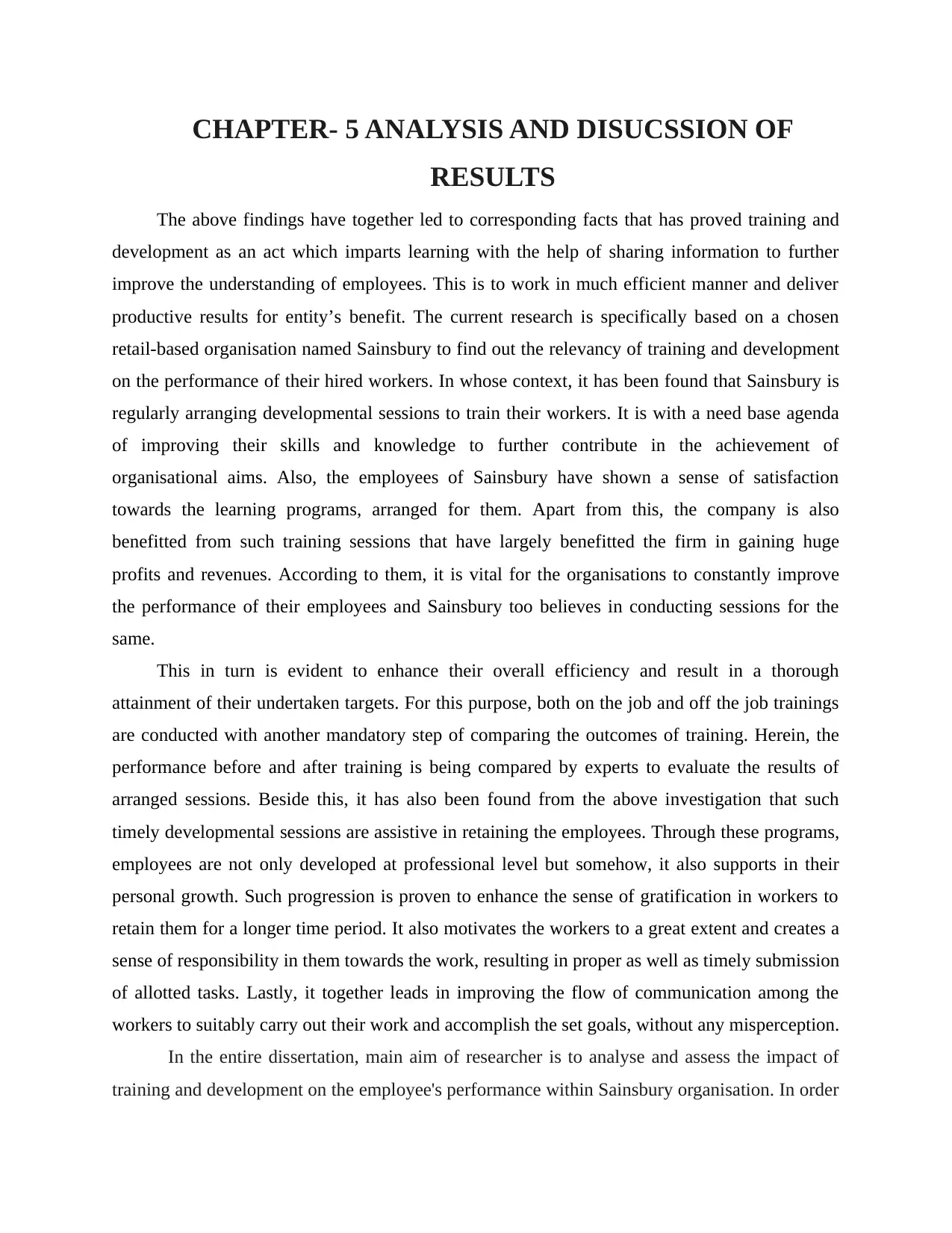
CHAPTER- 5 ANALYSIS AND DISUCSSION OF
RESULTS
The above findings have together led to corresponding facts that has proved training and
development as an act which imparts learning with the help of sharing information to further
improve the understanding of employees. This is to work in much efficient manner and deliver
productive results for entity’s benefit. The current research is specifically based on a chosen
retail-based organisation named Sainsbury to find out the relevancy of training and development
on the performance of their hired workers. In whose context, it has been found that Sainsbury is
regularly arranging developmental sessions to train their workers. It is with a need base agenda
of improving their skills and knowledge to further contribute in the achievement of
organisational aims. Also, the employees of Sainsbury have shown a sense of satisfaction
towards the learning programs, arranged for them. Apart from this, the company is also
benefitted from such training sessions that have largely benefitted the firm in gaining huge
profits and revenues. According to them, it is vital for the organisations to constantly improve
the performance of their employees and Sainsbury too believes in conducting sessions for the
same.
This in turn is evident to enhance their overall efficiency and result in a thorough
attainment of their undertaken targets. For this purpose, both on the job and off the job trainings
are conducted with another mandatory step of comparing the outcomes of training. Herein, the
performance before and after training is being compared by experts to evaluate the results of
arranged sessions. Beside this, it has also been found from the above investigation that such
timely developmental sessions are assistive in retaining the employees. Through these programs,
employees are not only developed at professional level but somehow, it also supports in their
personal growth. Such progression is proven to enhance the sense of gratification in workers to
retain them for a longer time period. It also motivates the workers to a great extent and creates a
sense of responsibility in them towards the work, resulting in proper as well as timely submission
of allotted tasks. Lastly, it together leads in improving the flow of communication among the
workers to suitably carry out their work and accomplish the set goals, without any misperception.
In the entire dissertation, main aim of researcher is to analyse and assess the impact of
training and development on the employee's performance within Sainsbury organisation. In order
RESULTS
The above findings have together led to corresponding facts that has proved training and
development as an act which imparts learning with the help of sharing information to further
improve the understanding of employees. This is to work in much efficient manner and deliver
productive results for entity’s benefit. The current research is specifically based on a chosen
retail-based organisation named Sainsbury to find out the relevancy of training and development
on the performance of their hired workers. In whose context, it has been found that Sainsbury is
regularly arranging developmental sessions to train their workers. It is with a need base agenda
of improving their skills and knowledge to further contribute in the achievement of
organisational aims. Also, the employees of Sainsbury have shown a sense of satisfaction
towards the learning programs, arranged for them. Apart from this, the company is also
benefitted from such training sessions that have largely benefitted the firm in gaining huge
profits and revenues. According to them, it is vital for the organisations to constantly improve
the performance of their employees and Sainsbury too believes in conducting sessions for the
same.
This in turn is evident to enhance their overall efficiency and result in a thorough
attainment of their undertaken targets. For this purpose, both on the job and off the job trainings
are conducted with another mandatory step of comparing the outcomes of training. Herein, the
performance before and after training is being compared by experts to evaluate the results of
arranged sessions. Beside this, it has also been found from the above investigation that such
timely developmental sessions are assistive in retaining the employees. Through these programs,
employees are not only developed at professional level but somehow, it also supports in their
personal growth. Such progression is proven to enhance the sense of gratification in workers to
retain them for a longer time period. It also motivates the workers to a great extent and creates a
sense of responsibility in them towards the work, resulting in proper as well as timely submission
of allotted tasks. Lastly, it together leads in improving the flow of communication among the
workers to suitably carry out their work and accomplish the set goals, without any misperception.
In the entire dissertation, main aim of researcher is to analyse and assess the impact of
training and development on the employee's performance within Sainsbury organisation. In order
Secure Best Marks with AI Grader
Need help grading? Try our AI Grader for instant feedback on your assignments.
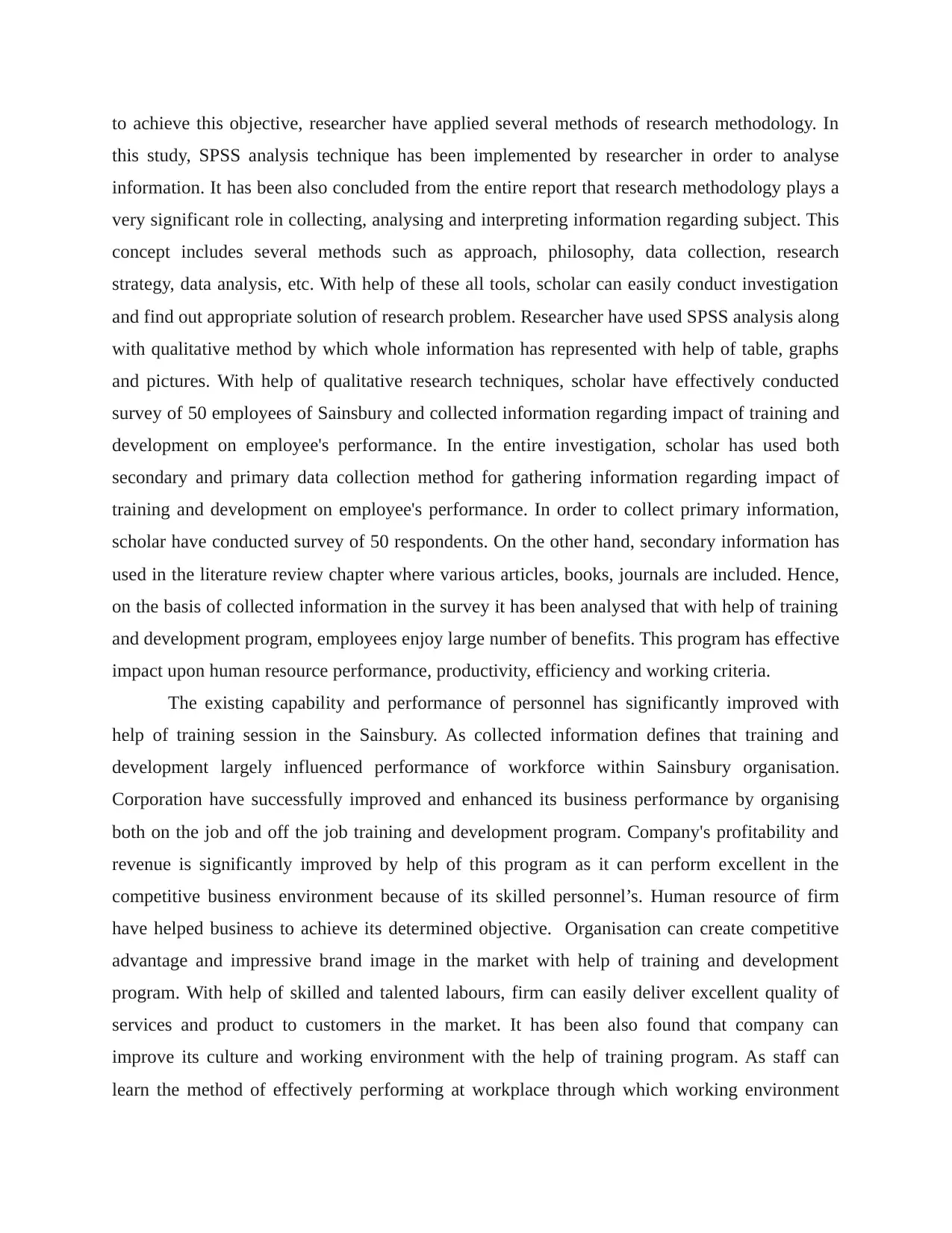
to achieve this objective, researcher have applied several methods of research methodology. In
this study, SPSS analysis technique has been implemented by researcher in order to analyse
information. It has been also concluded from the entire report that research methodology plays a
very significant role in collecting, analysing and interpreting information regarding subject. This
concept includes several methods such as approach, philosophy, data collection, research
strategy, data analysis, etc. With help of these all tools, scholar can easily conduct investigation
and find out appropriate solution of research problem. Researcher have used SPSS analysis along
with qualitative method by which whole information has represented with help of table, graphs
and pictures. With help of qualitative research techniques, scholar have effectively conducted
survey of 50 employees of Sainsbury and collected information regarding impact of training and
development on employee's performance. In the entire investigation, scholar has used both
secondary and primary data collection method for gathering information regarding impact of
training and development on employee's performance. In order to collect primary information,
scholar have conducted survey of 50 respondents. On the other hand, secondary information has
used in the literature review chapter where various articles, books, journals are included. Hence,
on the basis of collected information in the survey it has been analysed that with help of training
and development program, employees enjoy large number of benefits. This program has effective
impact upon human resource performance, productivity, efficiency and working criteria.
The existing capability and performance of personnel has significantly improved with
help of training session in the Sainsbury. As collected information defines that training and
development largely influenced performance of workforce within Sainsbury organisation.
Corporation have successfully improved and enhanced its business performance by organising
both on the job and off the job training and development program. Company's profitability and
revenue is significantly improved by help of this program as it can perform excellent in the
competitive business environment because of its skilled personnel’s. Human resource of firm
have helped business to achieve its determined objective. Organisation can create competitive
advantage and impressive brand image in the market with help of training and development
program. With help of skilled and talented labours, firm can easily deliver excellent quality of
services and product to customers in the market. It has been also found that company can
improve its culture and working environment with the help of training program. As staff can
learn the method of effectively performing at workplace through which working environment
this study, SPSS analysis technique has been implemented by researcher in order to analyse
information. It has been also concluded from the entire report that research methodology plays a
very significant role in collecting, analysing and interpreting information regarding subject. This
concept includes several methods such as approach, philosophy, data collection, research
strategy, data analysis, etc. With help of these all tools, scholar can easily conduct investigation
and find out appropriate solution of research problem. Researcher have used SPSS analysis along
with qualitative method by which whole information has represented with help of table, graphs
and pictures. With help of qualitative research techniques, scholar have effectively conducted
survey of 50 employees of Sainsbury and collected information regarding impact of training and
development on employee's performance. In the entire investigation, scholar has used both
secondary and primary data collection method for gathering information regarding impact of
training and development on employee's performance. In order to collect primary information,
scholar have conducted survey of 50 respondents. On the other hand, secondary information has
used in the literature review chapter where various articles, books, journals are included. Hence,
on the basis of collected information in the survey it has been analysed that with help of training
and development program, employees enjoy large number of benefits. This program has effective
impact upon human resource performance, productivity, efficiency and working criteria.
The existing capability and performance of personnel has significantly improved with
help of training session in the Sainsbury. As collected information defines that training and
development largely influenced performance of workforce within Sainsbury organisation.
Corporation have successfully improved and enhanced its business performance by organising
both on the job and off the job training and development program. Company's profitability and
revenue is significantly improved by help of this program as it can perform excellent in the
competitive business environment because of its skilled personnel’s. Human resource of firm
have helped business to achieve its determined objective. Organisation can create competitive
advantage and impressive brand image in the market with help of training and development
program. With help of skilled and talented labours, firm can easily deliver excellent quality of
services and product to customers in the market. It has been also found that company can
improve its culture and working environment with the help of training program. As staff can
learn the method of effectively performing at workplace through which working environment
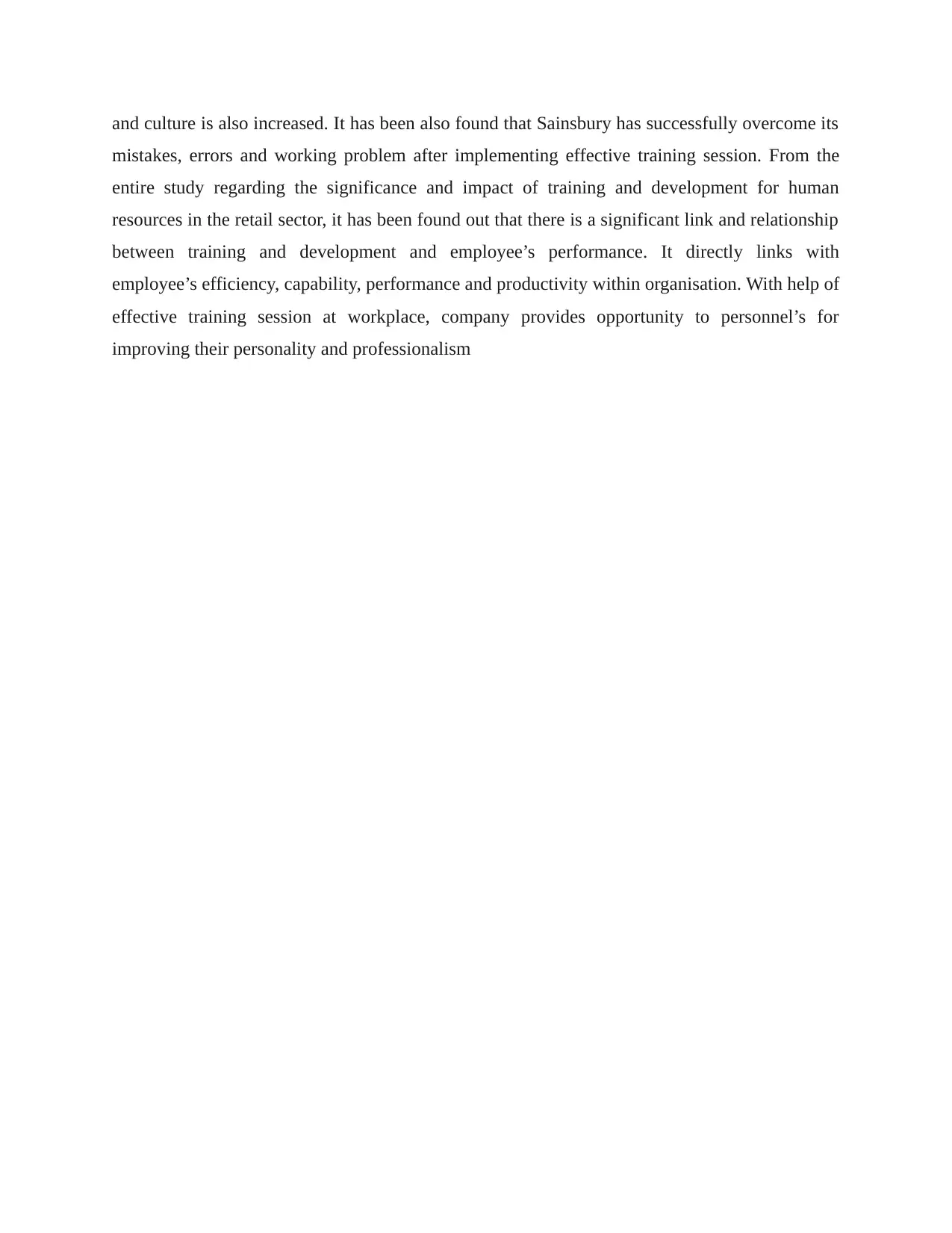
and culture is also increased. It has been also found that Sainsbury has successfully overcome its
mistakes, errors and working problem after implementing effective training session. From the
entire study regarding the significance and impact of training and development for human
resources in the retail sector, it has been found out that there is a significant link and relationship
between training and development and employee’s performance. It directly links with
employee’s efficiency, capability, performance and productivity within organisation. With help of
effective training session at workplace, company provides opportunity to personnel’s for
improving their personality and professionalism
mistakes, errors and working problem after implementing effective training session. From the
entire study regarding the significance and impact of training and development for human
resources in the retail sector, it has been found out that there is a significant link and relationship
between training and development and employee’s performance. It directly links with
employee’s efficiency, capability, performance and productivity within organisation. With help of
effective training session at workplace, company provides opportunity to personnel’s for
improving their personality and professionalism
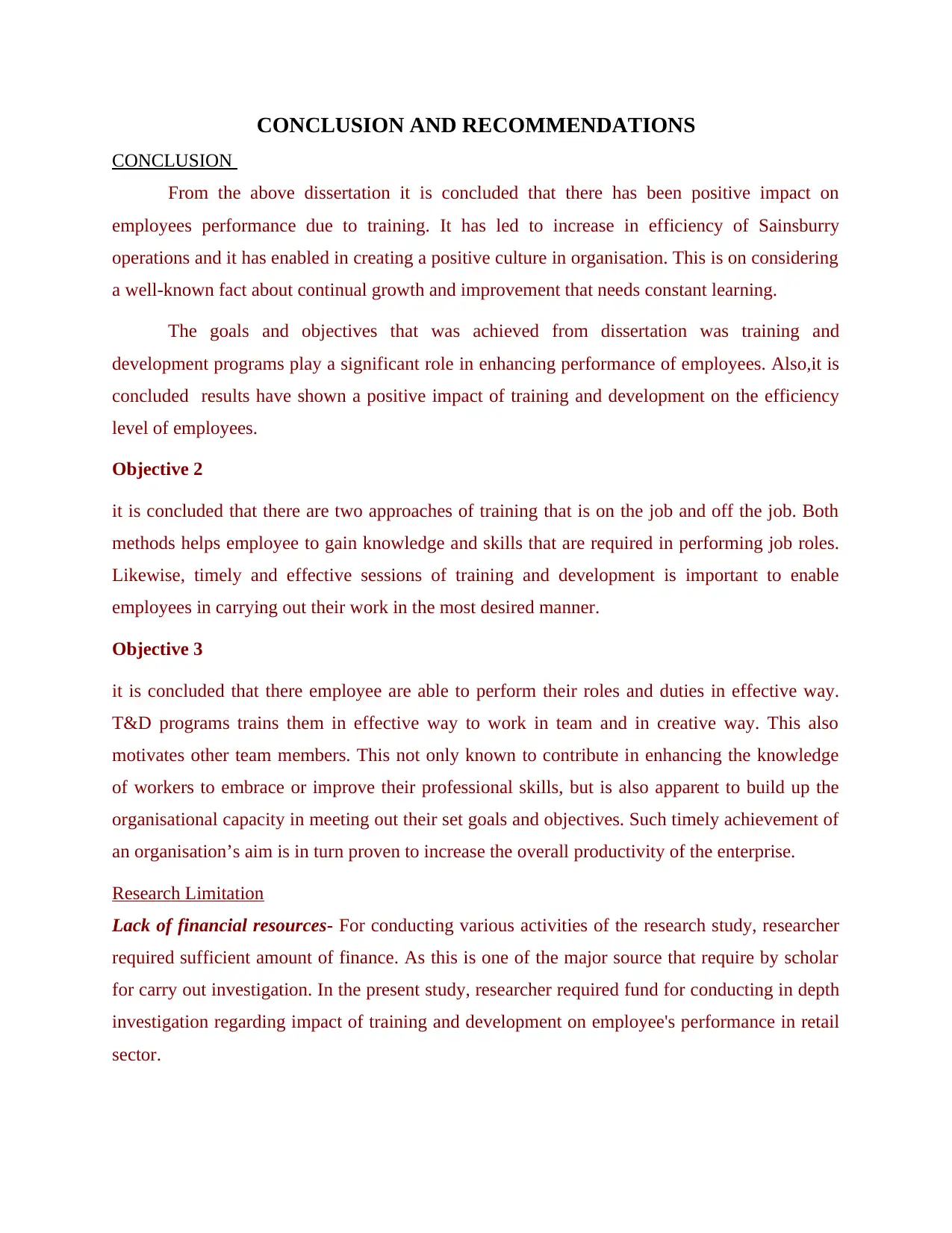
CONCLUSION AND RECOMMENDATIONS
CONCLUSION
From the above dissertation it is concluded that there has been positive impact on
employees performance due to training. It has led to increase in efficiency of Sainsburry
operations and it has enabled in creating a positive culture in organisation. This is on considering
a well-known fact about continual growth and improvement that needs constant learning.
The goals and objectives that was achieved from dissertation was training and
development programs play a significant role in enhancing performance of employees. Also,it is
concluded results have shown a positive impact of training and development on the efficiency
level of employees.
Objective 2
it is concluded that there are two approaches of training that is on the job and off the job. Both
methods helps employee to gain knowledge and skills that are required in performing job roles.
Likewise, timely and effective sessions of training and development is important to enable
employees in carrying out their work in the most desired manner.
Objective 3
it is concluded that there employee are able to perform their roles and duties in effective way.
T&D programs trains them in effective way to work in team and in creative way. This also
motivates other team members. This not only known to contribute in enhancing the knowledge
of workers to embrace or improve their professional skills, but is also apparent to build up the
organisational capacity in meeting out their set goals and objectives. Such timely achievement of
an organisation’s aim is in turn proven to increase the overall productivity of the enterprise.
Research Limitation
Lack of financial resources- For conducting various activities of the research study, researcher
required sufficient amount of finance. As this is one of the major source that require by scholar
for carry out investigation. In the present study, researcher required fund for conducting in depth
investigation regarding impact of training and development on employee's performance in retail
sector.
CONCLUSION
From the above dissertation it is concluded that there has been positive impact on
employees performance due to training. It has led to increase in efficiency of Sainsburry
operations and it has enabled in creating a positive culture in organisation. This is on considering
a well-known fact about continual growth and improvement that needs constant learning.
The goals and objectives that was achieved from dissertation was training and
development programs play a significant role in enhancing performance of employees. Also,it is
concluded results have shown a positive impact of training and development on the efficiency
level of employees.
Objective 2
it is concluded that there are two approaches of training that is on the job and off the job. Both
methods helps employee to gain knowledge and skills that are required in performing job roles.
Likewise, timely and effective sessions of training and development is important to enable
employees in carrying out their work in the most desired manner.
Objective 3
it is concluded that there employee are able to perform their roles and duties in effective way.
T&D programs trains them in effective way to work in team and in creative way. This also
motivates other team members. This not only known to contribute in enhancing the knowledge
of workers to embrace or improve their professional skills, but is also apparent to build up the
organisational capacity in meeting out their set goals and objectives. Such timely achievement of
an organisation’s aim is in turn proven to increase the overall productivity of the enterprise.
Research Limitation
Lack of financial resources- For conducting various activities of the research study, researcher
required sufficient amount of finance. As this is one of the major source that require by scholar
for carry out investigation. In the present study, researcher required fund for conducting in depth
investigation regarding impact of training and development on employee's performance in retail
sector.
Paraphrase This Document
Need a fresh take? Get an instant paraphrase of this document with our AI Paraphraser
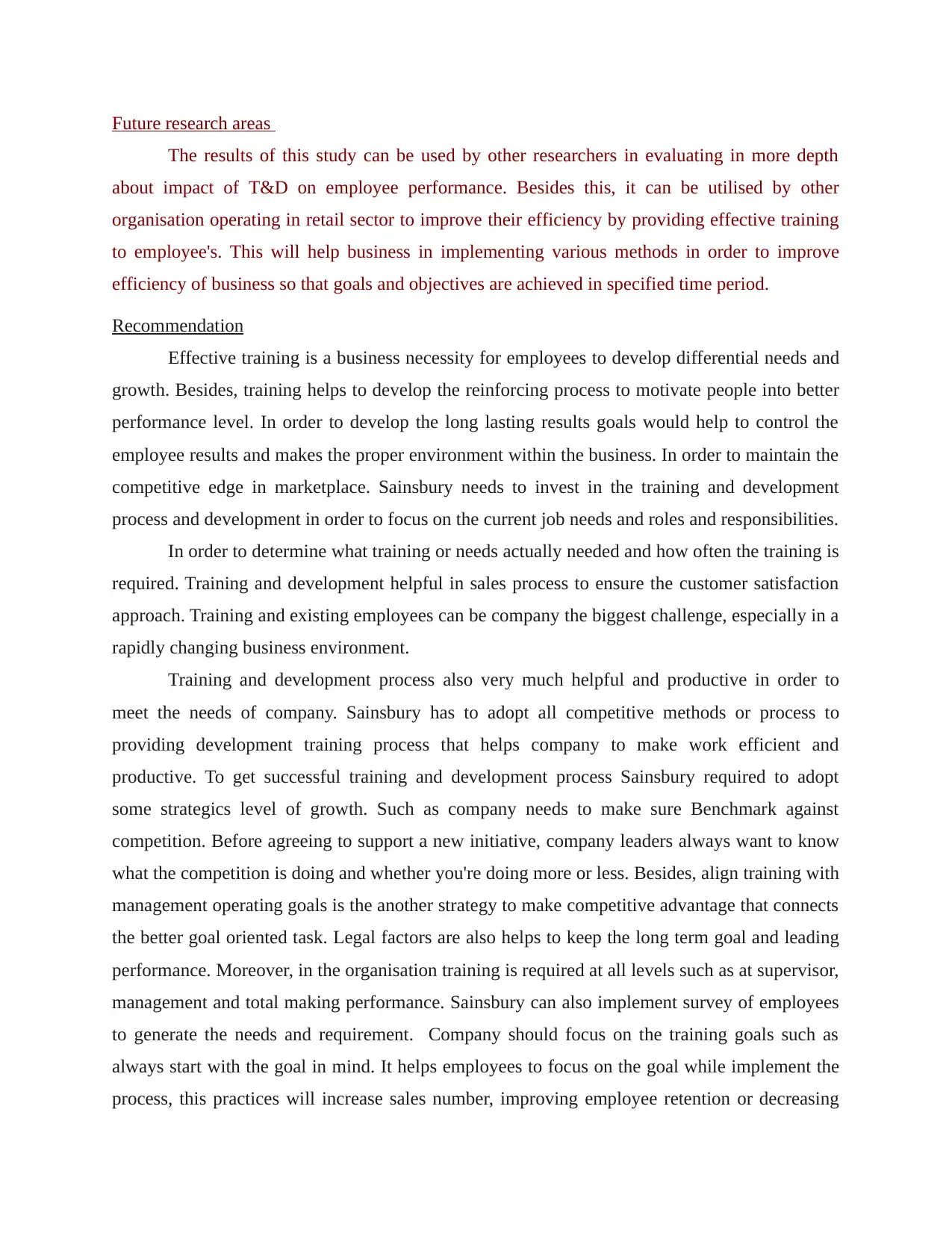
Future research areas
The results of this study can be used by other researchers in evaluating in more depth
about impact of T&D on employee performance. Besides this, it can be utilised by other
organisation operating in retail sector to improve their efficiency by providing effective training
to employee's. This will help business in implementing various methods in order to improve
efficiency of business so that goals and objectives are achieved in specified time period.
Recommendation
Effective training is a business necessity for employees to develop differential needs and
growth. Besides, training helps to develop the reinforcing process to motivate people into better
performance level. In order to develop the long lasting results goals would help to control the
employee results and makes the proper environment within the business. In order to maintain the
competitive edge in marketplace. Sainsbury needs to invest in the training and development
process and development in order to focus on the current job needs and roles and responsibilities.
In order to determine what training or needs actually needed and how often the training is
required. Training and development helpful in sales process to ensure the customer satisfaction
approach. Training and existing employees can be company the biggest challenge, especially in a
rapidly changing business environment.
Training and development process also very much helpful and productive in order to
meet the needs of company. Sainsbury has to adopt all competitive methods or process to
providing development training process that helps company to make work efficient and
productive. To get successful training and development process Sainsbury required to adopt
some strategics level of growth. Such as company needs to make sure Benchmark against
competition. Before agreeing to support a new initiative, company leaders always want to know
what the competition is doing and whether you're doing more or less. Besides, align training with
management operating goals is the another strategy to make competitive advantage that connects
the better goal oriented task. Legal factors are also helps to keep the long term goal and leading
performance. Moreover, in the organisation training is required at all levels such as at supervisor,
management and total making performance. Sainsbury can also implement survey of employees
to generate the needs and requirement. Company should focus on the training goals such as
always start with the goal in mind. It helps employees to focus on the goal while implement the
process, this practices will increase sales number, improving employee retention or decreasing
The results of this study can be used by other researchers in evaluating in more depth
about impact of T&D on employee performance. Besides this, it can be utilised by other
organisation operating in retail sector to improve their efficiency by providing effective training
to employee's. This will help business in implementing various methods in order to improve
efficiency of business so that goals and objectives are achieved in specified time period.
Recommendation
Effective training is a business necessity for employees to develop differential needs and
growth. Besides, training helps to develop the reinforcing process to motivate people into better
performance level. In order to develop the long lasting results goals would help to control the
employee results and makes the proper environment within the business. In order to maintain the
competitive edge in marketplace. Sainsbury needs to invest in the training and development
process and development in order to focus on the current job needs and roles and responsibilities.
In order to determine what training or needs actually needed and how often the training is
required. Training and development helpful in sales process to ensure the customer satisfaction
approach. Training and existing employees can be company the biggest challenge, especially in a
rapidly changing business environment.
Training and development process also very much helpful and productive in order to
meet the needs of company. Sainsbury has to adopt all competitive methods or process to
providing development training process that helps company to make work efficient and
productive. To get successful training and development process Sainsbury required to adopt
some strategics level of growth. Such as company needs to make sure Benchmark against
competition. Before agreeing to support a new initiative, company leaders always want to know
what the competition is doing and whether you're doing more or less. Besides, align training with
management operating goals is the another strategy to make competitive advantage that connects
the better goal oriented task. Legal factors are also helps to keep the long term goal and leading
performance. Moreover, in the organisation training is required at all levels such as at supervisor,
management and total making performance. Sainsbury can also implement survey of employees
to generate the needs and requirement. Company should focus on the training goals such as
always start with the goal in mind. It helps employees to focus on the goal while implement the
process, this practices will increase sales number, improving employee retention or decreasing

human resource complaints. In spite of that, ensure employees needs is the another source to
identify the needs of training so that, employees become more trustful towards company.
Sainsbury deals with high number of employees, it is very required for them to organise frequent
training needs. It helps to keep employees energetic and influential. To make training session
interesting Sainsbury make sure about the contents of the training are pertinent. This also helps
to control the long term goals and takes the long term challenging performance methods. This
also helps to make the better environmental goals. Overall, it helps to keep the challenging and
better task performance and better objective performance goals. Ensuring content would helpful
to connect employees with the purpose. Otherwise, sometimes employee would get bored from
the content. This also helps to keep the long term generating goals and best possible action plan.
Learner who has conceptual way of learning would prefer to have a lot of information, whether it
comes in the form of presentation or readings. This makes the process and leading resourceful
idea and growth. You can evaluate your employees learning style with psychometric test. This
will help to correspond to their natural abilities in terms of learning. There are also two types of
training methods internal or external that contains the best performing goals and provides the
best leading performing methods. It would also be useful to be great full and leading resourceful
goals. Employee training impact on productivity levels, that helps to keep the process
challenging and productivity.
Employee training gives impact on productivity level that helps to full fill the company
objective. Training helps to inspire new employees in the organisations for long term suitability.
Reinvigorates is the another advantage of training and development that makes the best leading
resourceful idealogical goals. Retraining employees on current skills increases the workers
interest and work performance as well. Productivity may be evaluated in terms of the output of
an employee during a specific period. Gives employees new skills is the another beneficial
sources. In order to full fill the long term goals and give the best performing task full manner. In
order to meet the possible need plan that connects the most suitable action performance goals.
Personnel is the most valuable assets. That connects the most suitable action plan. Training and
development is a type of activity which is planned systematically. That relates to the better fast-
forward results. Overall, this process helped to enhance the individual skills and knowledge and
competency level which is necessary to implement in terms of large number of process. This
gives good impact on the employee performance. Overall, it keeps the all challenging goals
identify the needs of training so that, employees become more trustful towards company.
Sainsbury deals with high number of employees, it is very required for them to organise frequent
training needs. It helps to keep employees energetic and influential. To make training session
interesting Sainsbury make sure about the contents of the training are pertinent. This also helps
to control the long term goals and takes the long term challenging performance methods. This
also helps to make the better environmental goals. Overall, it helps to keep the challenging and
better task performance and better objective performance goals. Ensuring content would helpful
to connect employees with the purpose. Otherwise, sometimes employee would get bored from
the content. This also helps to keep the long term generating goals and best possible action plan.
Learner who has conceptual way of learning would prefer to have a lot of information, whether it
comes in the form of presentation or readings. This makes the process and leading resourceful
idea and growth. You can evaluate your employees learning style with psychometric test. This
will help to correspond to their natural abilities in terms of learning. There are also two types of
training methods internal or external that contains the best performing goals and provides the
best leading performing methods. It would also be useful to be great full and leading resourceful
goals. Employee training impact on productivity levels, that helps to keep the process
challenging and productivity.
Employee training gives impact on productivity level that helps to full fill the company
objective. Training helps to inspire new employees in the organisations for long term suitability.
Reinvigorates is the another advantage of training and development that makes the best leading
resourceful idealogical goals. Retraining employees on current skills increases the workers
interest and work performance as well. Productivity may be evaluated in terms of the output of
an employee during a specific period. Gives employees new skills is the another beneficial
sources. In order to full fill the long term goals and give the best performing task full manner. In
order to meet the possible need plan that connects the most suitable action performance goals.
Personnel is the most valuable assets. That connects the most suitable action plan. Training and
development is a type of activity which is planned systematically. That relates to the better fast-
forward results. Overall, this process helped to enhance the individual skills and knowledge and
competency level which is necessary to implement in terms of large number of process. This
gives good impact on the employee performance. Overall, it keeps the all challenging goals
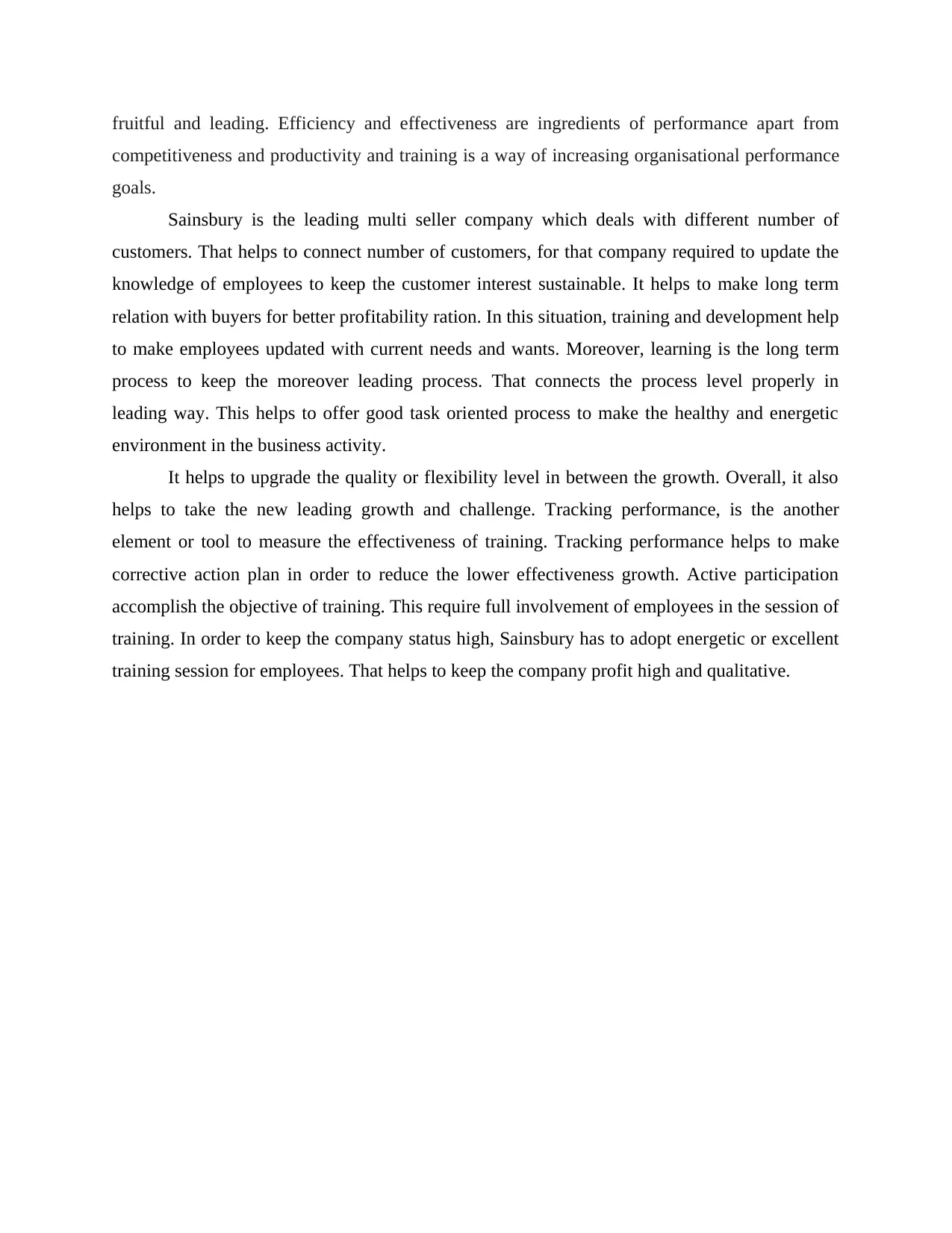
fruitful and leading. Efficiency and effectiveness are ingredients of performance apart from
competitiveness and productivity and training is a way of increasing organisational performance
goals.
Sainsbury is the leading multi seller company which deals with different number of
customers. That helps to connect number of customers, for that company required to update the
knowledge of employees to keep the customer interest sustainable. It helps to make long term
relation with buyers for better profitability ration. In this situation, training and development help
to make employees updated with current needs and wants. Moreover, learning is the long term
process to keep the moreover leading process. That connects the process level properly in
leading way. This helps to offer good task oriented process to make the healthy and energetic
environment in the business activity.
It helps to upgrade the quality or flexibility level in between the growth. Overall, it also
helps to take the new leading growth and challenge. Tracking performance, is the another
element or tool to measure the effectiveness of training. Tracking performance helps to make
corrective action plan in order to reduce the lower effectiveness growth. Active participation
accomplish the objective of training. This require full involvement of employees in the session of
training. In order to keep the company status high, Sainsbury has to adopt energetic or excellent
training session for employees. That helps to keep the company profit high and qualitative.
competitiveness and productivity and training is a way of increasing organisational performance
goals.
Sainsbury is the leading multi seller company which deals with different number of
customers. That helps to connect number of customers, for that company required to update the
knowledge of employees to keep the customer interest sustainable. It helps to make long term
relation with buyers for better profitability ration. In this situation, training and development help
to make employees updated with current needs and wants. Moreover, learning is the long term
process to keep the moreover leading process. That connects the process level properly in
leading way. This helps to offer good task oriented process to make the healthy and energetic
environment in the business activity.
It helps to upgrade the quality or flexibility level in between the growth. Overall, it also
helps to take the new leading growth and challenge. Tracking performance, is the another
element or tool to measure the effectiveness of training. Tracking performance helps to make
corrective action plan in order to reduce the lower effectiveness growth. Active participation
accomplish the objective of training. This require full involvement of employees in the session of
training. In order to keep the company status high, Sainsbury has to adopt energetic or excellent
training session for employees. That helps to keep the company profit high and qualitative.
Secure Best Marks with AI Grader
Need help grading? Try our AI Grader for instant feedback on your assignments.
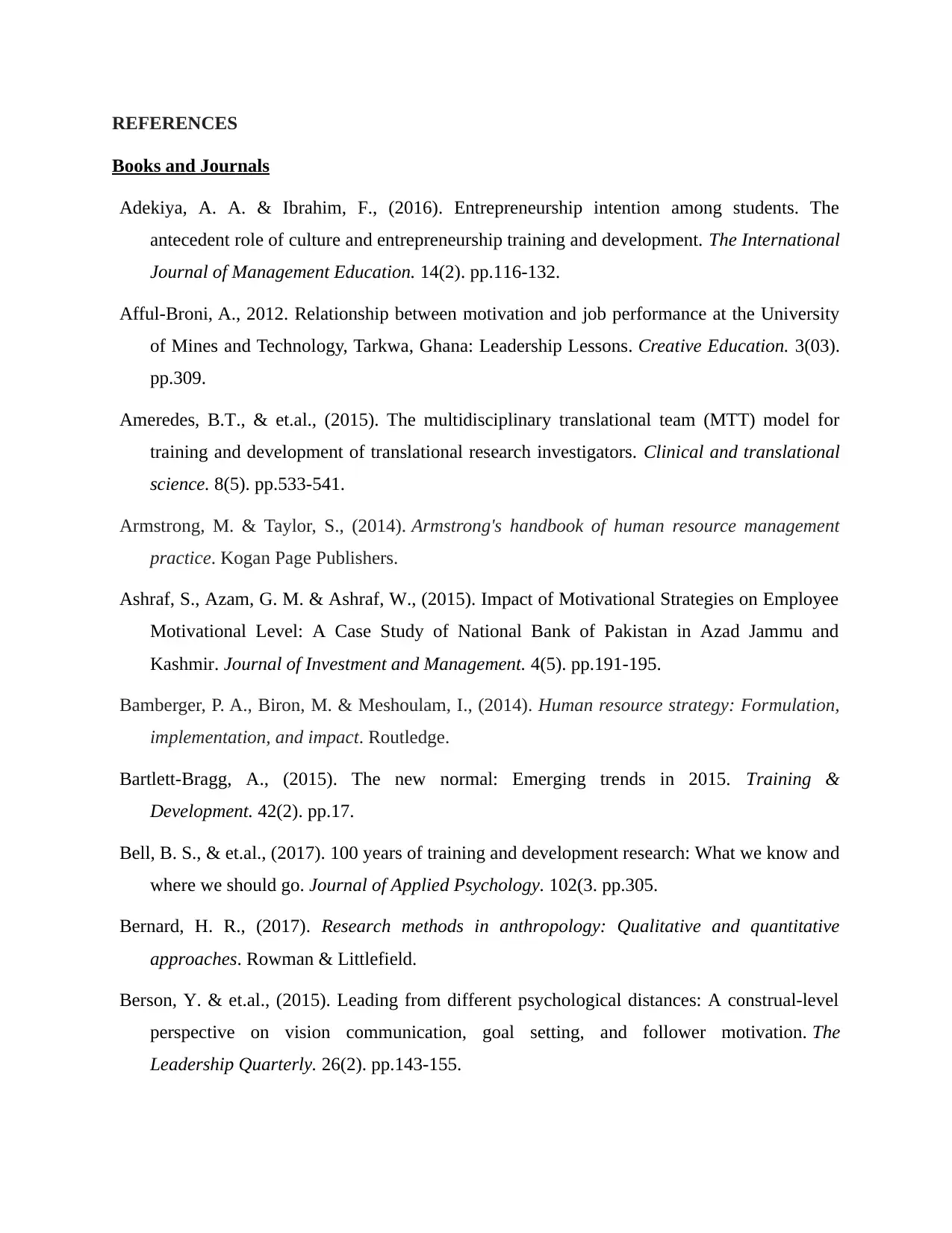
REFERENCES
Books and Journals
Adekiya, A. A. & Ibrahim, F., (2016). Entrepreneurship intention among students. The
antecedent role of culture and entrepreneurship training and development. The International
Journal of Management Education. 14(2). pp.116-132.
Afful-Broni, A., 2012. Relationship between motivation and job performance at the University
of Mines and Technology, Tarkwa, Ghana: Leadership Lessons. Creative Education. 3(03).
pp.309.
Ameredes, B.T., & et.al., (2015). The multidisciplinary translational team (MTT) model for
training and development of translational research investigators. Clinical and translational
science. 8(5). pp.533-541.
Armstrong, M. & Taylor, S., (2014). Armstrong's handbook of human resource management
practice. Kogan Page Publishers.
Ashraf, S., Azam, G. M. & Ashraf, W., (2015). Impact of Motivational Strategies on Employee
Motivational Level: A Case Study of National Bank of Pakistan in Azad Jammu and
Kashmir. Journal of Investment and Management. 4(5). pp.191-195.
Bamberger, P. A., Biron, M. & Meshoulam, I., (2014). Human resource strategy: Formulation,
implementation, and impact. Routledge.
Bartlett-Bragg, A., (2015). The new normal: Emerging trends in 2015. Training &
Development. 42(2). pp.17.
Bell, B. S., & et.al., (2017). 100 years of training and development research: What we know and
where we should go. Journal of Applied Psychology. 102(3. pp.305.
Bernard, H. R., (2017). Research methods in anthropology: Qualitative and quantitative
approaches. Rowman & Littlefield.
Berson, Y. & et.al., (2015). Leading from different psychological distances: A construal-level
perspective on vision communication, goal setting, and follower motivation. The
Leadership Quarterly. 26(2). pp.143-155.
Books and Journals
Adekiya, A. A. & Ibrahim, F., (2016). Entrepreneurship intention among students. The
antecedent role of culture and entrepreneurship training and development. The International
Journal of Management Education. 14(2). pp.116-132.
Afful-Broni, A., 2012. Relationship between motivation and job performance at the University
of Mines and Technology, Tarkwa, Ghana: Leadership Lessons. Creative Education. 3(03).
pp.309.
Ameredes, B.T., & et.al., (2015). The multidisciplinary translational team (MTT) model for
training and development of translational research investigators. Clinical and translational
science. 8(5). pp.533-541.
Armstrong, M. & Taylor, S., (2014). Armstrong's handbook of human resource management
practice. Kogan Page Publishers.
Ashraf, S., Azam, G. M. & Ashraf, W., (2015). Impact of Motivational Strategies on Employee
Motivational Level: A Case Study of National Bank of Pakistan in Azad Jammu and
Kashmir. Journal of Investment and Management. 4(5). pp.191-195.
Bamberger, P. A., Biron, M. & Meshoulam, I., (2014). Human resource strategy: Formulation,
implementation, and impact. Routledge.
Bartlett-Bragg, A., (2015). The new normal: Emerging trends in 2015. Training &
Development. 42(2). pp.17.
Bell, B. S., & et.al., (2017). 100 years of training and development research: What we know and
where we should go. Journal of Applied Psychology. 102(3. pp.305.
Bernard, H. R., (2017). Research methods in anthropology: Qualitative and quantitative
approaches. Rowman & Littlefield.
Berson, Y. & et.al., (2015). Leading from different psychological distances: A construal-level
perspective on vision communication, goal setting, and follower motivation. The
Leadership Quarterly. 26(2). pp.143-155.
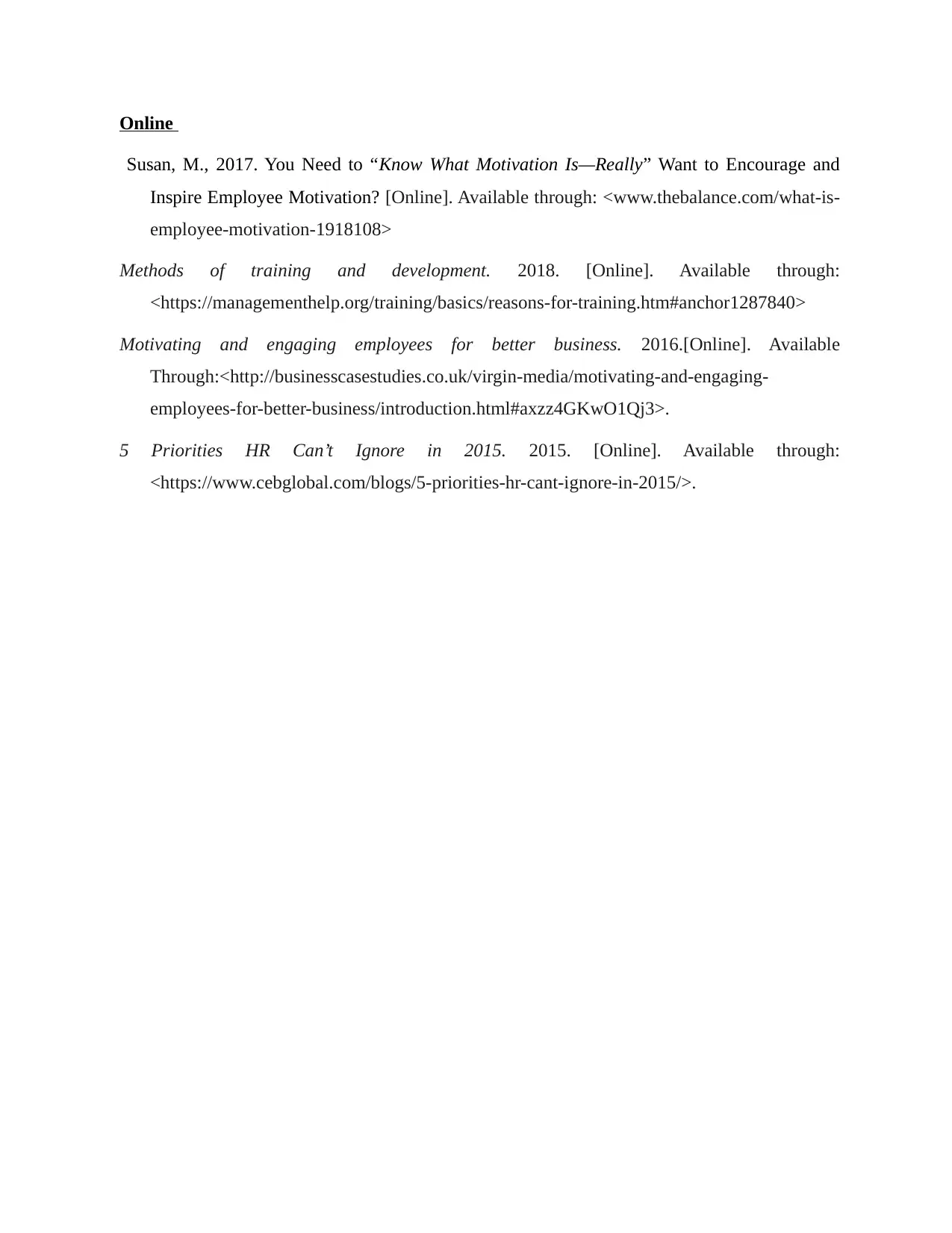
Online
Susan, M., 2017. You Need to “Know What Motivation Is—Really” Want to Encourage and
Inspire Employee Motivation? [Online]. Available through: <www.thebalance.com/what-is-
employee-motivation-1918108>
Methods of training and development. 2018. [Online]. Available through:
<https://managementhelp.org/training/basics/reasons-for-training.htm#anchor1287840>
Motivating and engaging employees for better business. 2016.[Online]. Available
Through:<http://businesscasestudies.co.uk/virgin-media/motivating-and-engaging-
employees-for-better-business/introduction.html#axzz4GKwO1Qj3>.
5 Priorities HR Can’t Ignore in 2015. 2015. [Online]. Available through:
<https://www.cebglobal.com/blogs/5-priorities-hr-cant-ignore-in-2015/>.
Susan, M., 2017. You Need to “Know What Motivation Is—Really” Want to Encourage and
Inspire Employee Motivation? [Online]. Available through: <www.thebalance.com/what-is-
employee-motivation-1918108>
Methods of training and development. 2018. [Online]. Available through:
<https://managementhelp.org/training/basics/reasons-for-training.htm#anchor1287840>
Motivating and engaging employees for better business. 2016.[Online]. Available
Through:<http://businesscasestudies.co.uk/virgin-media/motivating-and-engaging-
employees-for-better-business/introduction.html#axzz4GKwO1Qj3>.
5 Priorities HR Can’t Ignore in 2015. 2015. [Online]. Available through:
<https://www.cebglobal.com/blogs/5-priorities-hr-cant-ignore-in-2015/>.
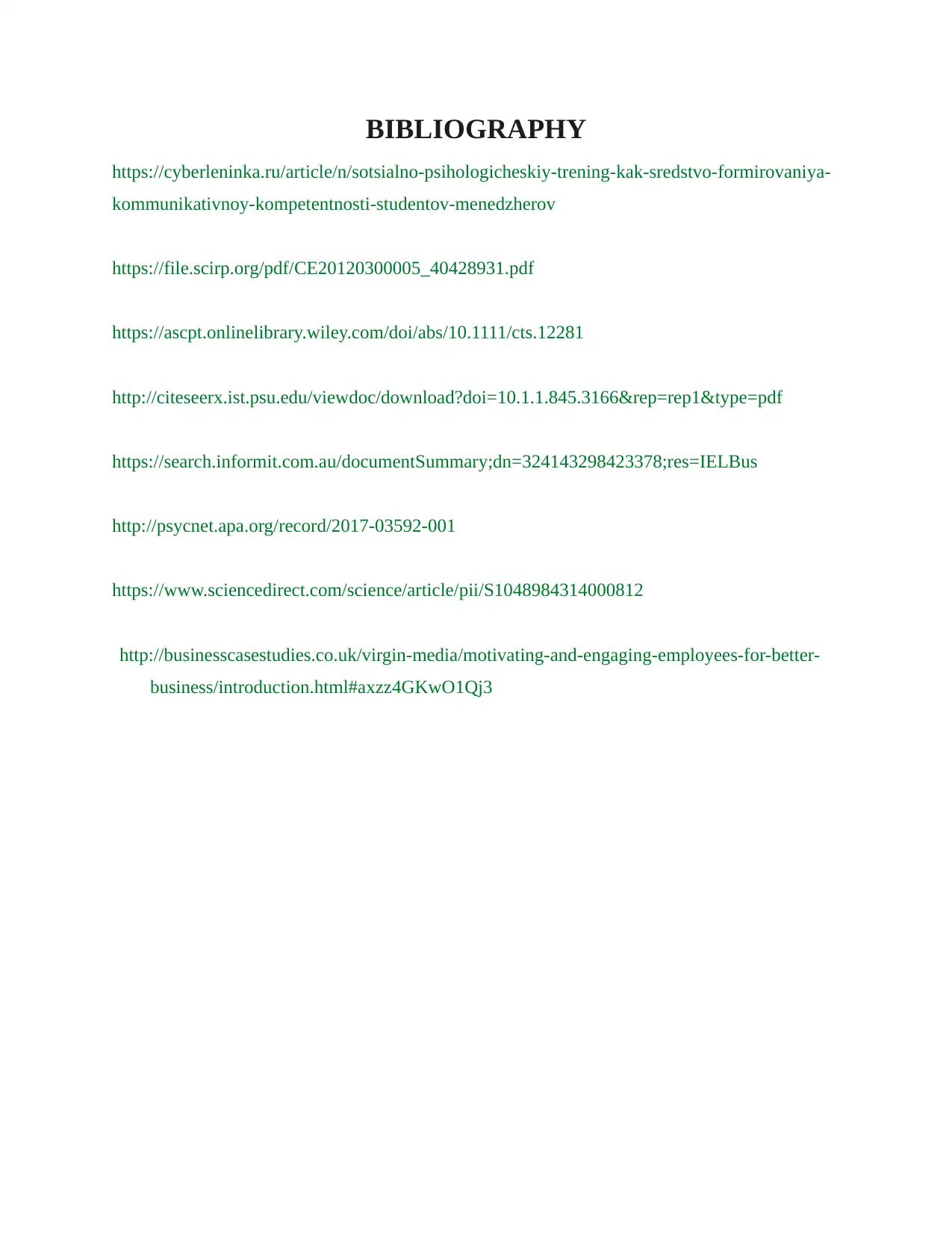
BIBLIOGRAPHY
https://cyberleninka.ru/article/n/sotsialno-psihologicheskiy-trening-kak-sredstvo-formirovaniya-
kommunikativnoy-kompetentnosti-studentov-menedzherov
https://file.scirp.org/pdf/CE20120300005_40428931.pdf
https://ascpt.onlinelibrary.wiley.com/doi/abs/10.1111/cts.12281
http://citeseerx.ist.psu.edu/viewdoc/download?doi=10.1.1.845.3166&rep=rep1&type=pdf
https://search.informit.com.au/documentSummary;dn=324143298423378;res=IELBus
http://psycnet.apa.org/record/2017-03592-001
https://www.sciencedirect.com/science/article/pii/S1048984314000812
http://businesscasestudies.co.uk/virgin-media/motivating-and-engaging-employees-for-better-
business/introduction.html#axzz4GKwO1Qj3
https://cyberleninka.ru/article/n/sotsialno-psihologicheskiy-trening-kak-sredstvo-formirovaniya-
kommunikativnoy-kompetentnosti-studentov-menedzherov
https://file.scirp.org/pdf/CE20120300005_40428931.pdf
https://ascpt.onlinelibrary.wiley.com/doi/abs/10.1111/cts.12281
http://citeseerx.ist.psu.edu/viewdoc/download?doi=10.1.1.845.3166&rep=rep1&type=pdf
https://search.informit.com.au/documentSummary;dn=324143298423378;res=IELBus
http://psycnet.apa.org/record/2017-03592-001
https://www.sciencedirect.com/science/article/pii/S1048984314000812
http://businesscasestudies.co.uk/virgin-media/motivating-and-engaging-employees-for-better-
business/introduction.html#axzz4GKwO1Qj3
Paraphrase This Document
Need a fresh take? Get an instant paraphrase of this document with our AI Paraphraser
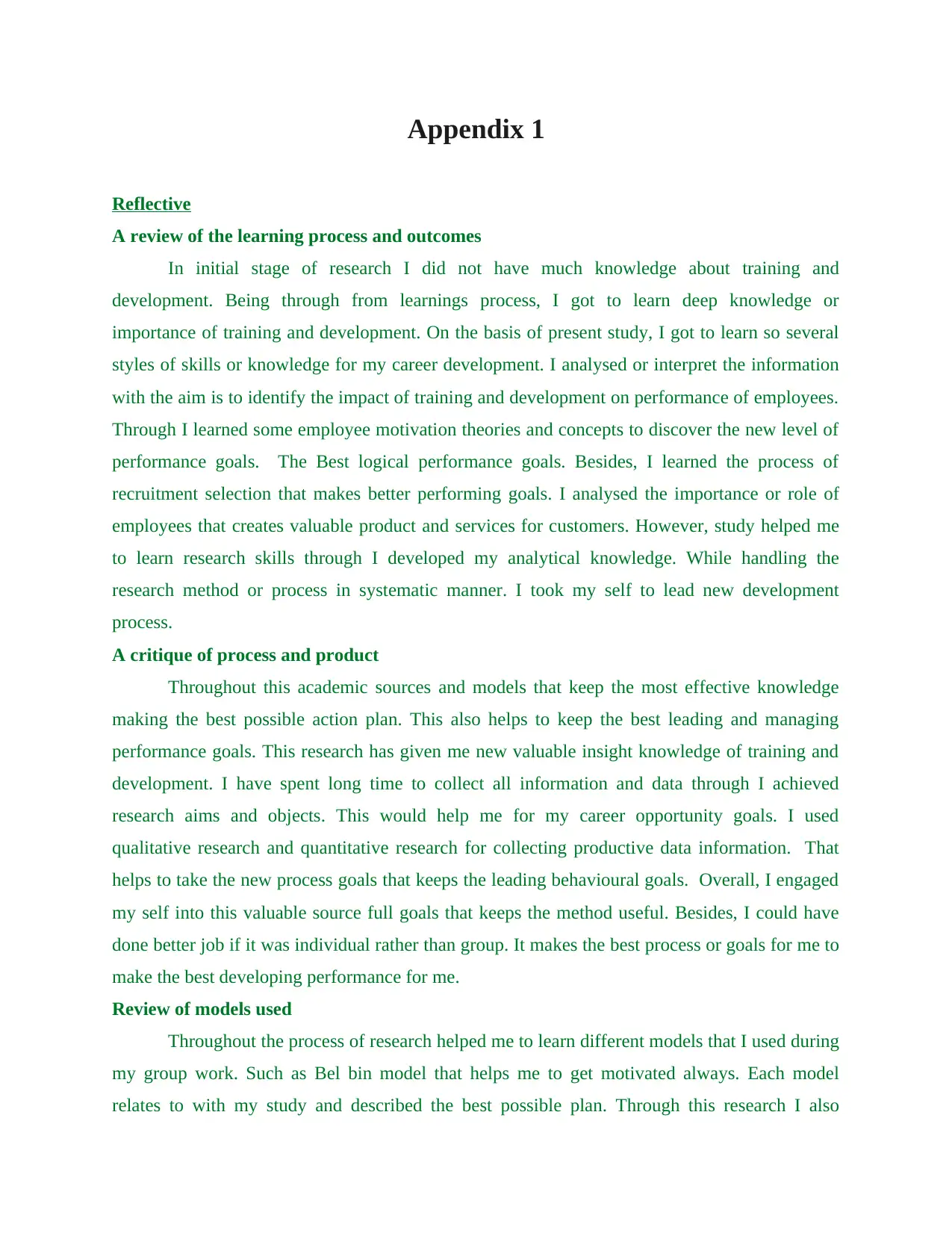
Appendix 1
Reflective
A review of the learning process and outcomes
In initial stage of research I did not have much knowledge about training and
development. Being through from learnings process, I got to learn deep knowledge or
importance of training and development. On the basis of present study, I got to learn so several
styles of skills or knowledge for my career development. I analysed or interpret the information
with the aim is to identify the impact of training and development on performance of employees.
Through I learned some employee motivation theories and concepts to discover the new level of
performance goals. The Best logical performance goals. Besides, I learned the process of
recruitment selection that makes better performing goals. I analysed the importance or role of
employees that creates valuable product and services for customers. However, study helped me
to learn research skills through I developed my analytical knowledge. While handling the
research method or process in systematic manner. I took my self to lead new development
process.
A critique of process and product
Throughout this academic sources and models that keep the most effective knowledge
making the best possible action plan. This also helps to keep the best leading and managing
performance goals. This research has given me new valuable insight knowledge of training and
development. I have spent long time to collect all information and data through I achieved
research aims and objects. This would help me for my career opportunity goals. I used
qualitative research and quantitative research for collecting productive data information. That
helps to take the new process goals that keeps the leading behavioural goals. Overall, I engaged
my self into this valuable source full goals that keeps the method useful. Besides, I could have
done better job if it was individual rather than group. It makes the best process or goals for me to
make the best developing performance for me.
Review of models used
Throughout the process of research helped me to learn different models that I used during
my group work. Such as Bel bin model that helps me to get motivated always. Each model
relates to with my study and described the best possible plan. Through this research I also
Reflective
A review of the learning process and outcomes
In initial stage of research I did not have much knowledge about training and
development. Being through from learnings process, I got to learn deep knowledge or
importance of training and development. On the basis of present study, I got to learn so several
styles of skills or knowledge for my career development. I analysed or interpret the information
with the aim is to identify the impact of training and development on performance of employees.
Through I learned some employee motivation theories and concepts to discover the new level of
performance goals. The Best logical performance goals. Besides, I learned the process of
recruitment selection that makes better performing goals. I analysed the importance or role of
employees that creates valuable product and services for customers. However, study helped me
to learn research skills through I developed my analytical knowledge. While handling the
research method or process in systematic manner. I took my self to lead new development
process.
A critique of process and product
Throughout this academic sources and models that keep the most effective knowledge
making the best possible action plan. This also helps to keep the best leading and managing
performance goals. This research has given me new valuable insight knowledge of training and
development. I have spent long time to collect all information and data through I achieved
research aims and objects. This would help me for my career opportunity goals. I used
qualitative research and quantitative research for collecting productive data information. That
helps to take the new process goals that keeps the leading behavioural goals. Overall, I engaged
my self into this valuable source full goals that keeps the method useful. Besides, I could have
done better job if it was individual rather than group. It makes the best process or goals for me to
make the best developing performance for me.
Review of models used
Throughout the process of research helped me to learn different models that I used during
my group work. Such as Bel bin model that helps me to get motivated always. Each model
relates to with my study and described the best possible plan. Through this research I also

learned some new techniques through I can manage some technical work as well. I learned so
many skills and knowledge through I got to learn some new skills and thoughts. Overall, process
helps me to enhance my confidence level and new give me new development opportunity in my
career aims.
Conclusion
Throughout this observation process can make the better advancing goals and make the
best opportunity goals in my career opportunities. In conclusion, I have learned many skills or
worked on many technical Software's such as SPSS, SAS during my study. This study will help
me to work on some new projects to enhance my ability power and growth. I became more
confident and challenging taking any opportunity in my future goal.
many skills and knowledge through I got to learn some new skills and thoughts. Overall, process
helps me to enhance my confidence level and new give me new development opportunity in my
career aims.
Conclusion
Throughout this observation process can make the better advancing goals and make the
best opportunity goals in my career opportunities. In conclusion, I have learned many skills or
worked on many technical Software's such as SPSS, SAS during my study. This study will help
me to work on some new projects to enhance my ability power and growth. I became more
confident and challenging taking any opportunity in my future goal.
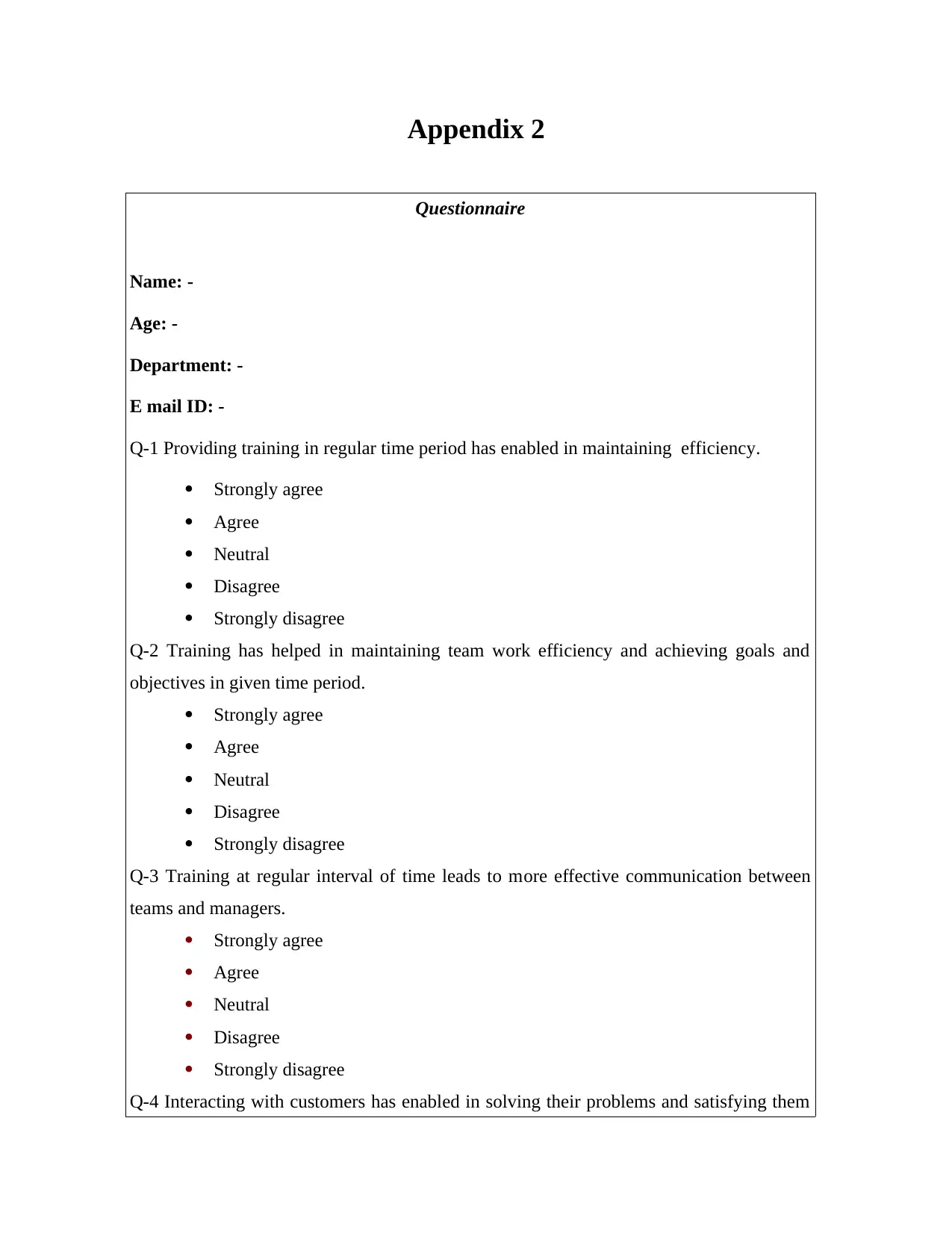
Appendix 2
Questionnaire
Name: -
Age: -
Department: -
E mail ID: -
Q-1 Providing training in regular time period has enabled in maintaining efficiency.
Strongly agree
Agree
Neutral
Disagree
Strongly disagree
Q-2 Training has helped in maintaining team work efficiency and achieving goals and
objectives in given time period.
Strongly agree
Agree
Neutral
Disagree
Strongly disagree
Q-3 Training at regular interval of time leads to more effective communication between
teams and managers.
Strongly agree
Agree
Neutral
Disagree
Strongly disagree
Q-4 Interacting with customers has enabled in solving their problems and satisfying them
Questionnaire
Name: -
Age: -
Department: -
E mail ID: -
Q-1 Providing training in regular time period has enabled in maintaining efficiency.
Strongly agree
Agree
Neutral
Disagree
Strongly disagree
Q-2 Training has helped in maintaining team work efficiency and achieving goals and
objectives in given time period.
Strongly agree
Agree
Neutral
Disagree
Strongly disagree
Q-3 Training at regular interval of time leads to more effective communication between
teams and managers.
Strongly agree
Agree
Neutral
Disagree
Strongly disagree
Q-4 Interacting with customers has enabled in solving their problems and satisfying them
Secure Best Marks with AI Grader
Need help grading? Try our AI Grader for instant feedback on your assignments.
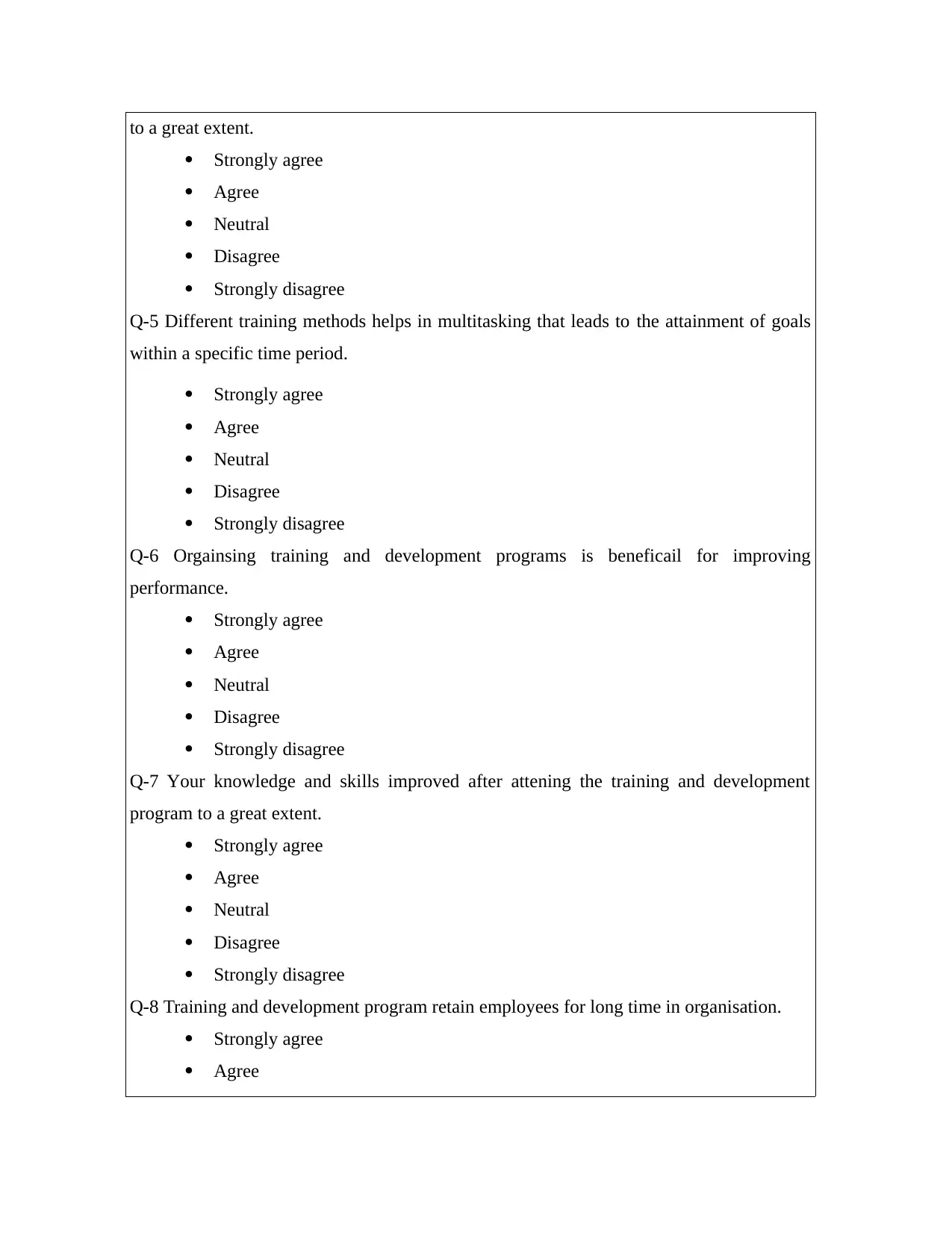
to a great extent.
Strongly agree
Agree
Neutral
Disagree
Strongly disagree
Q-5 Different training methods helps in multitasking that leads to the attainment of goals
within a specific time period.
Strongly agree
Agree
Neutral
Disagree
Strongly disagree
Q-6 Orgainsing training and development programs is beneficail for improving
performance.
Strongly agree
Agree
Neutral
Disagree
Strongly disagree
Q-7 Your knowledge and skills improved after attening the training and development
program to a great extent.
Strongly agree
Agree
Neutral
Disagree
Strongly disagree
Q-8 Training and development program retain employees for long time in organisation.
Strongly agree
Agree
Strongly agree
Agree
Neutral
Disagree
Strongly disagree
Q-5 Different training methods helps in multitasking that leads to the attainment of goals
within a specific time period.
Strongly agree
Agree
Neutral
Disagree
Strongly disagree
Q-6 Orgainsing training and development programs is beneficail for improving
performance.
Strongly agree
Agree
Neutral
Disagree
Strongly disagree
Q-7 Your knowledge and skills improved after attening the training and development
program to a great extent.
Strongly agree
Agree
Neutral
Disagree
Strongly disagree
Q-8 Training and development program retain employees for long time in organisation.
Strongly agree
Agree
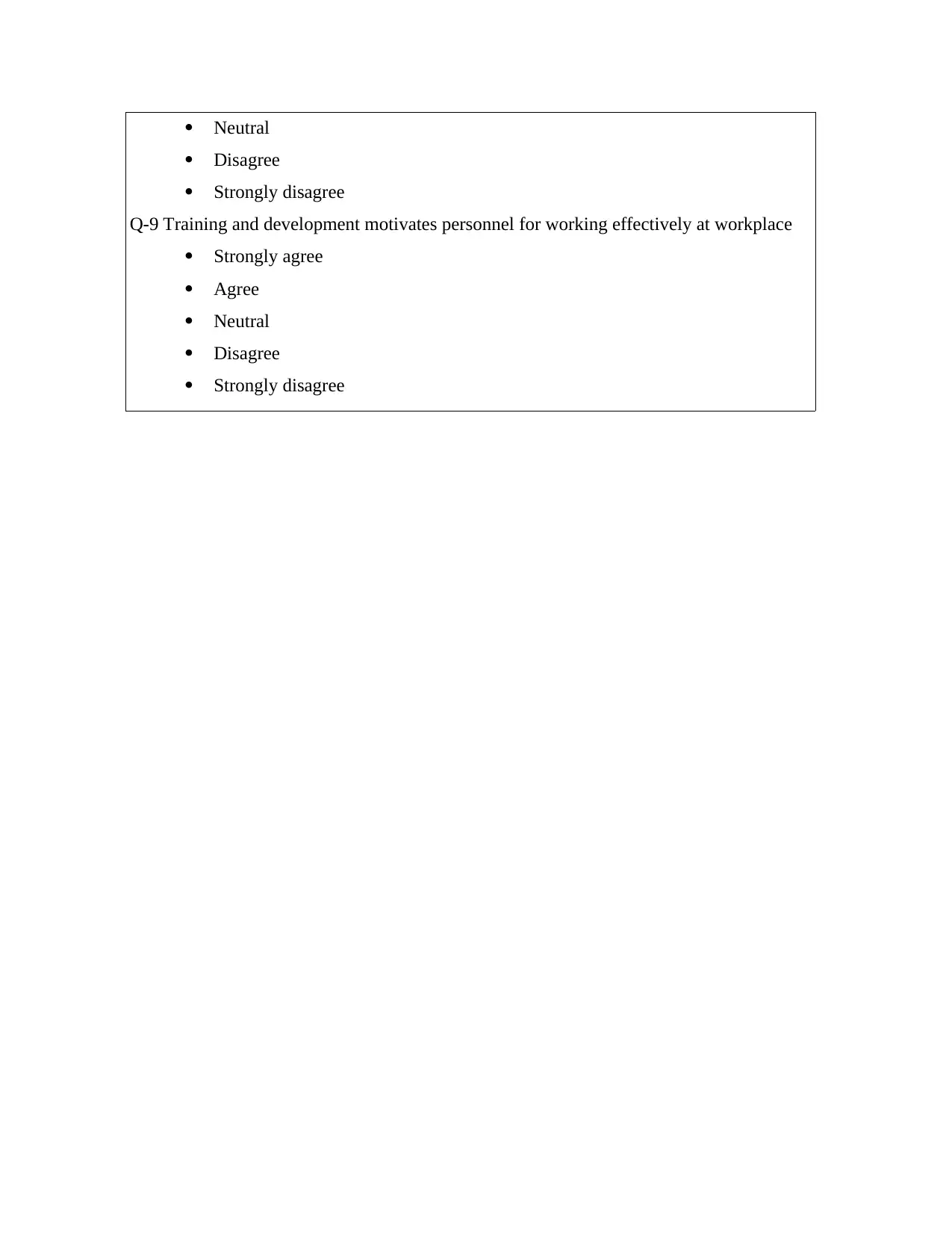
Neutral
Disagree
Strongly disagree
Q-9 Training and development motivates personnel for working effectively at workplace
Strongly agree
Agree
Neutral
Disagree
Strongly disagree
Disagree
Strongly disagree
Q-9 Training and development motivates personnel for working effectively at workplace
Strongly agree
Agree
Neutral
Disagree
Strongly disagree
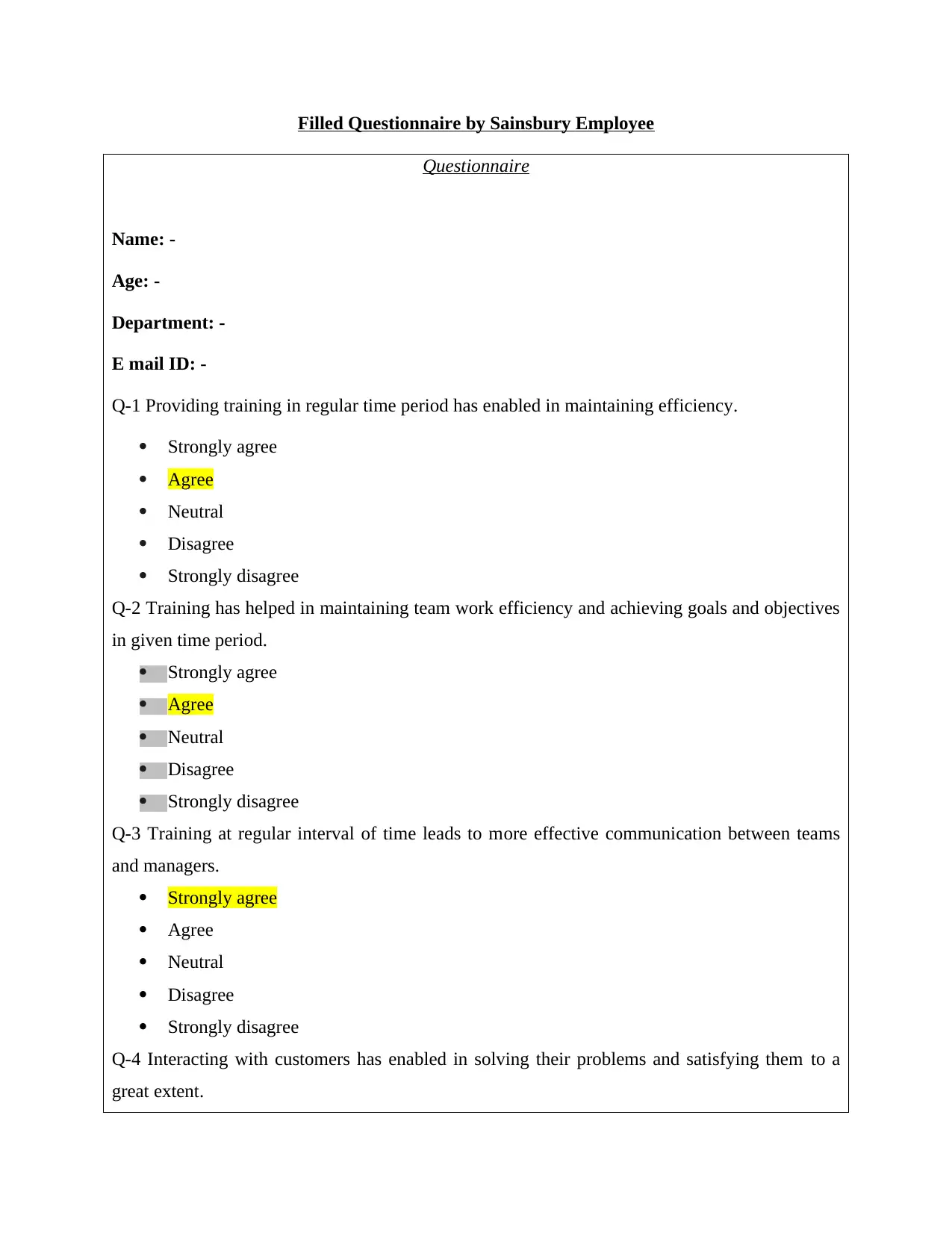
Filled Questionnaire by Sainsbury Employee
Questionnaire
Name: -
Age: -
Department: -
E mail ID: -
Q-1 Providing training in regular time period has enabled in maintaining efficiency.
Strongly agree
Agree
Neutral
Disagree
Strongly disagree
Q-2 Training has helped in maintaining team work efficiency and achieving goals and objectives
in given time period.
Strongly agree
Agree
Neutral
Disagree
Strongly disagree
Q-3 Training at regular interval of time leads to more effective communication between teams
and managers.
Strongly agree
Agree
Neutral
Disagree
Strongly disagree
Q-4 Interacting with customers has enabled in solving their problems and satisfying them to a
great extent.
Questionnaire
Name: -
Age: -
Department: -
E mail ID: -
Q-1 Providing training in regular time period has enabled in maintaining efficiency.
Strongly agree
Agree
Neutral
Disagree
Strongly disagree
Q-2 Training has helped in maintaining team work efficiency and achieving goals and objectives
in given time period.
Strongly agree
Agree
Neutral
Disagree
Strongly disagree
Q-3 Training at regular interval of time leads to more effective communication between teams
and managers.
Strongly agree
Agree
Neutral
Disagree
Strongly disagree
Q-4 Interacting with customers has enabled in solving their problems and satisfying them to a
great extent.
Paraphrase This Document
Need a fresh take? Get an instant paraphrase of this document with our AI Paraphraser

Strongly agree
Agree
Neutral
Disagree
Strongly disagree
Q-5 Different training methods helps in multitasking that leads to the attainment of goals within
a specific time period.
Strongly agree
Agree
Neutral
Disagree
Strongly disagree
Q-6 Orgainsing training and development programs is beneficail for improving performance.
Strongly agree
Agree
Neutral
Disagree
Strongly disagree
Q-7 Your knowledge and skills improved after attening the training and development program to
a great extent.
Strongly agree
Agree
Neutral
Disagree
Strongly disagree
Q-8 Training and development program retain employees for long time in organisation.
Strongly agree
Agree
Neutral
Disagree
Agree
Neutral
Disagree
Strongly disagree
Q-5 Different training methods helps in multitasking that leads to the attainment of goals within
a specific time period.
Strongly agree
Agree
Neutral
Disagree
Strongly disagree
Q-6 Orgainsing training and development programs is beneficail for improving performance.
Strongly agree
Agree
Neutral
Disagree
Strongly disagree
Q-7 Your knowledge and skills improved after attening the training and development program to
a great extent.
Strongly agree
Agree
Neutral
Disagree
Strongly disagree
Q-8 Training and development program retain employees for long time in organisation.
Strongly agree
Agree
Neutral
Disagree

Strongly disagree
Q-9 Training and development motivates personnel for working effectively at workplace
Strongly agree
Agree
Neutral
Disagree
Strongly disagree
Q-9 Training and development motivates personnel for working effectively at workplace
Strongly agree
Agree
Neutral
Disagree
Strongly disagree
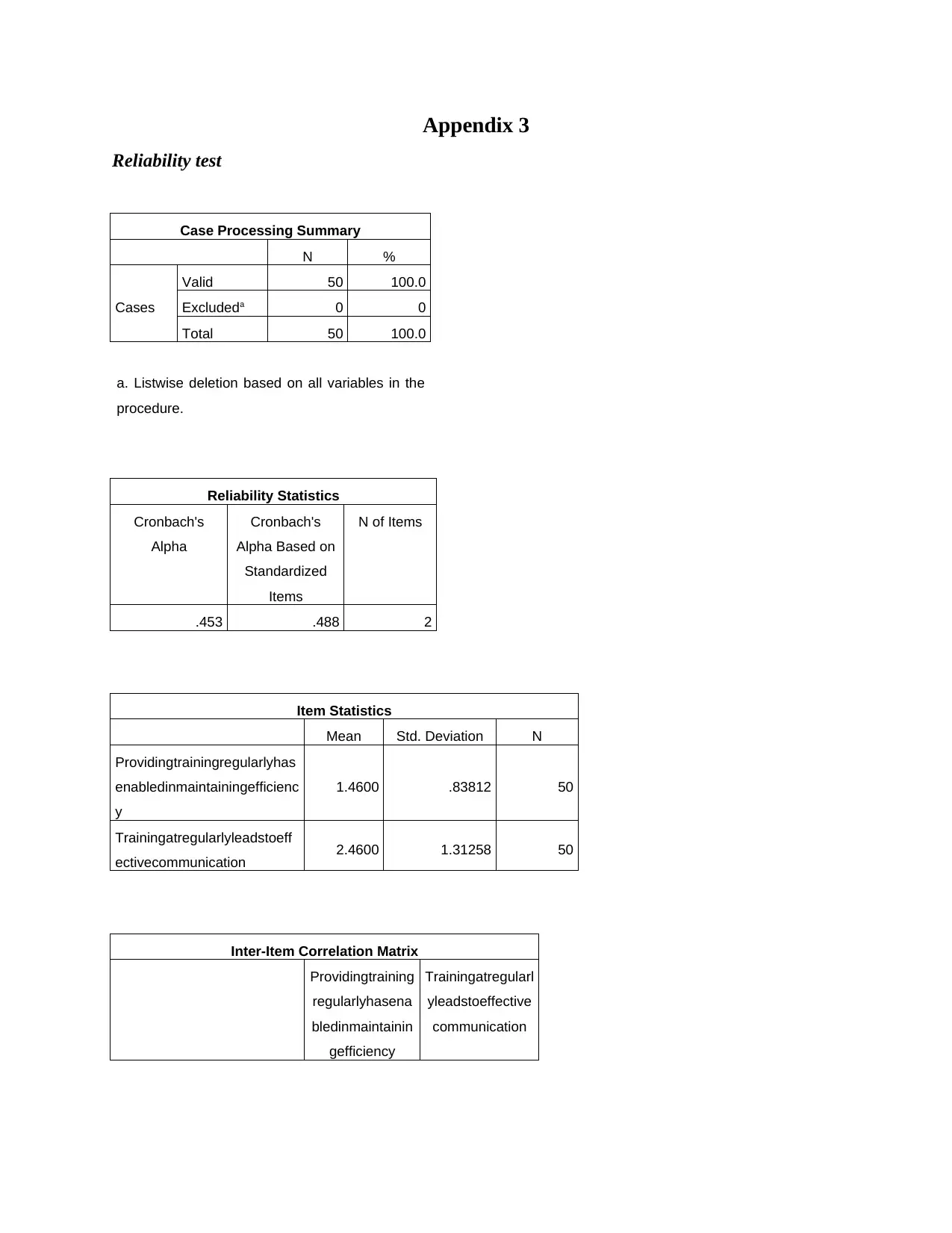
Appendix 3
Reliability test
Case Processing Summary
N %
Cases
Valid 50 100.0
Excludeda 0 0
Total 50 100.0
a. Listwise deletion based on all variables in the
procedure.
Reliability Statistics
Cronbach's
Alpha
Cronbach's
Alpha Based on
Standardized
Items
N of Items
.453 .488 2
Item Statistics
Mean Std. Deviation N
Providingtrainingregularlyhas
enabledinmaintainingefficienc
y
1.4600 .83812 50
Trainingatregularlyleadstoeff
ectivecommunication 2.4600 1.31258 50
Inter-Item Correlation Matrix
Providingtraining
regularlyhasena
bledinmaintainin
gefficiency
Trainingatregularl
yleadstoeffective
communication
Reliability test
Case Processing Summary
N %
Cases
Valid 50 100.0
Excludeda 0 0
Total 50 100.0
a. Listwise deletion based on all variables in the
procedure.
Reliability Statistics
Cronbach's
Alpha
Cronbach's
Alpha Based on
Standardized
Items
N of Items
.453 .488 2
Item Statistics
Mean Std. Deviation N
Providingtrainingregularlyhas
enabledinmaintainingefficienc
y
1.4600 .83812 50
Trainingatregularlyleadstoeff
ectivecommunication 2.4600 1.31258 50
Inter-Item Correlation Matrix
Providingtraining
regularlyhasena
bledinmaintainin
gefficiency
Trainingatregularl
yleadstoeffective
communication
Secure Best Marks with AI Grader
Need help grading? Try our AI Grader for instant feedback on your assignments.
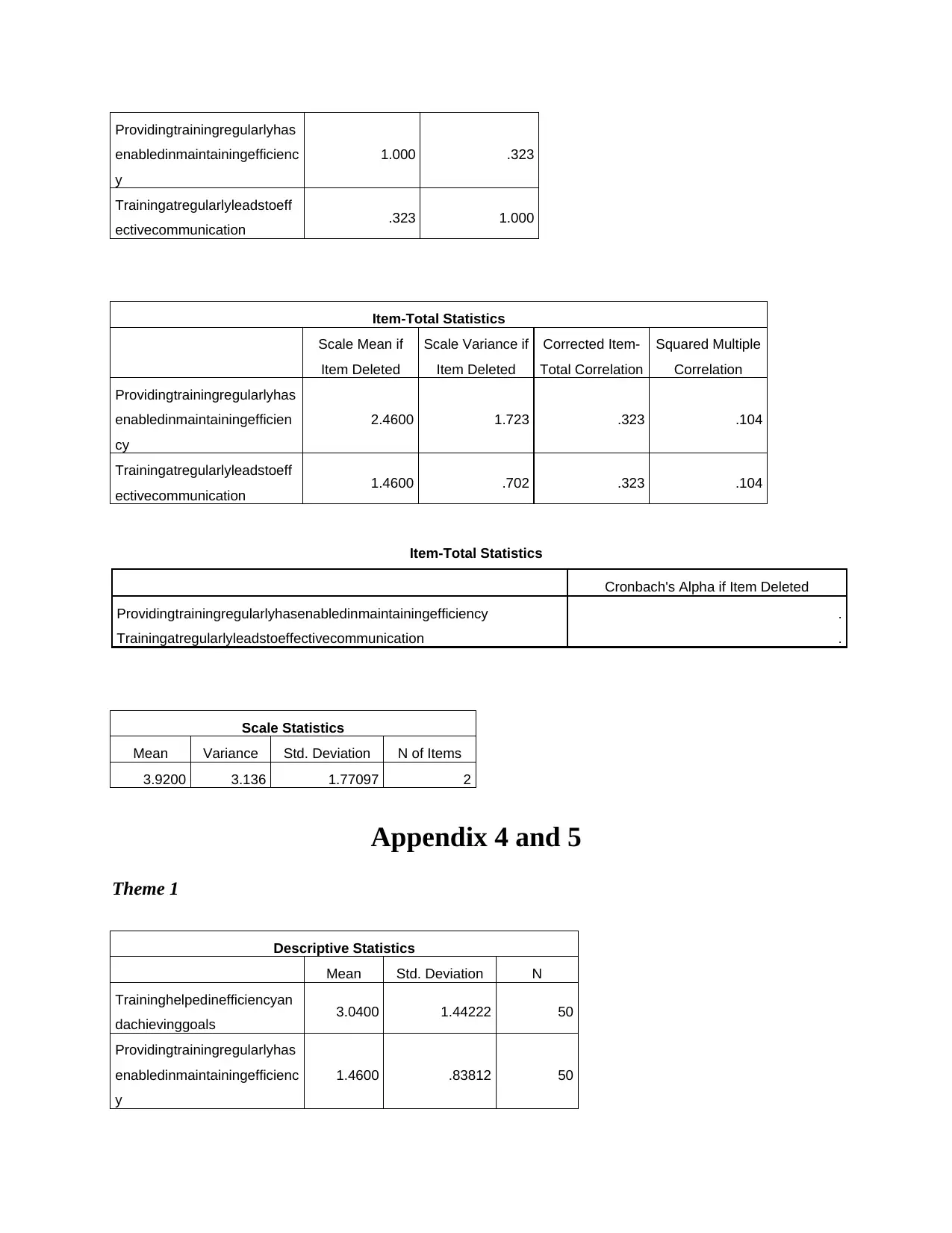
Providingtrainingregularlyhas
enabledinmaintainingefficienc
y
1.000 .323
Trainingatregularlyleadstoeff
ectivecommunication .323 1.000
Item-Total Statistics
Scale Mean if
Item Deleted
Scale Variance if
Item Deleted
Corrected Item-
Total Correlation
Squared Multiple
Correlation
Providingtrainingregularlyhas
enabledinmaintainingefficien
cy
2.4600 1.723 .323 .104
Trainingatregularlyleadstoeff
ectivecommunication 1.4600 .702 .323 .104
Item-Total Statistics
Cronbach's Alpha if Item Deleted
Providingtrainingregularlyhasenabledinmaintainingefficiency .
Trainingatregularlyleadstoeffectivecommunication .
Scale Statistics
Mean Variance Std. Deviation N of Items
3.9200 3.136 1.77097 2
Appendix 4 and 5
Theme 1
Descriptive Statistics
Mean Std. Deviation N
Traininghelpedinefficiencyan
dachievinggoals 3.0400 1.44222 50
Providingtrainingregularlyhas
enabledinmaintainingefficienc
y
1.4600 .83812 50
enabledinmaintainingefficienc
y
1.000 .323
Trainingatregularlyleadstoeff
ectivecommunication .323 1.000
Item-Total Statistics
Scale Mean if
Item Deleted
Scale Variance if
Item Deleted
Corrected Item-
Total Correlation
Squared Multiple
Correlation
Providingtrainingregularlyhas
enabledinmaintainingefficien
cy
2.4600 1.723 .323 .104
Trainingatregularlyleadstoeff
ectivecommunication 1.4600 .702 .323 .104
Item-Total Statistics
Cronbach's Alpha if Item Deleted
Providingtrainingregularlyhasenabledinmaintainingefficiency .
Trainingatregularlyleadstoeffectivecommunication .
Scale Statistics
Mean Variance Std. Deviation N of Items
3.9200 3.136 1.77097 2
Appendix 4 and 5
Theme 1
Descriptive Statistics
Mean Std. Deviation N
Traininghelpedinefficiencyan
dachievinggoals 3.0400 1.44222 50
Providingtrainingregularlyhas
enabledinmaintainingefficienc
y
1.4600 .83812 50
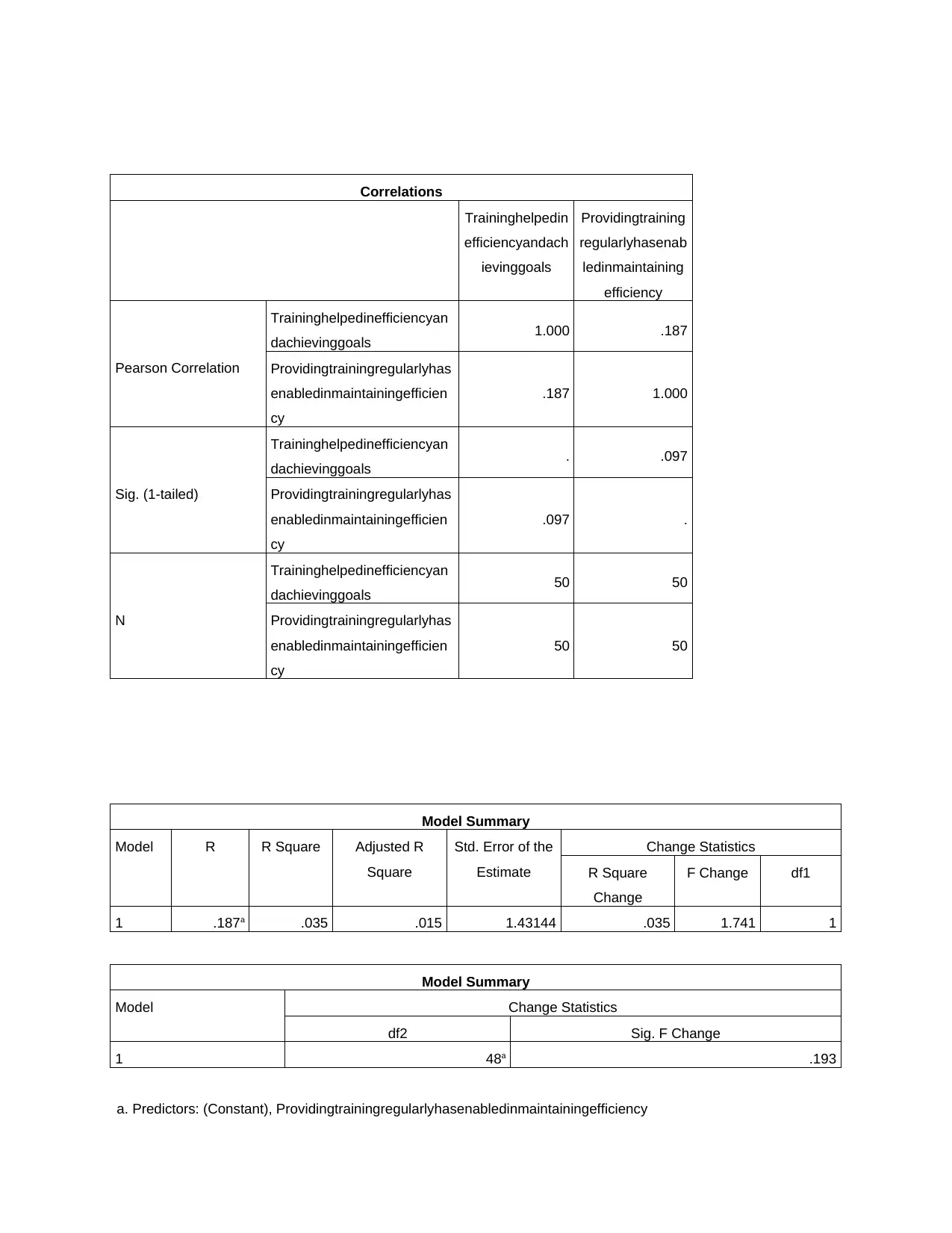
Correlations
Traininghelpedin
efficiencyandach
ievinggoals
Providingtraining
regularlyhasenab
ledinmaintaining
efficiency
Pearson Correlation
Traininghelpedinefficiencyan
dachievinggoals 1.000 .187
Providingtrainingregularlyhas
enabledinmaintainingefficien
cy
.187 1.000
Sig. (1-tailed)
Traininghelpedinefficiencyan
dachievinggoals . .097
Providingtrainingregularlyhas
enabledinmaintainingefficien
cy
.097 .
N
Traininghelpedinefficiencyan
dachievinggoals 50 50
Providingtrainingregularlyhas
enabledinmaintainingefficien
cy
50 50
Model Summary
Model R R Square Adjusted R
Square
Std. Error of the
Estimate
Change Statistics
R Square
Change
F Change df1
1 .187a .035 .015 1.43144 .035 1.741 1
Model Summary
Model Change Statistics
df2 Sig. F Change
1 48a .193
a. Predictors: (Constant), Providingtrainingregularlyhasenabledinmaintainingefficiency
Traininghelpedin
efficiencyandach
ievinggoals
Providingtraining
regularlyhasenab
ledinmaintaining
efficiency
Pearson Correlation
Traininghelpedinefficiencyan
dachievinggoals 1.000 .187
Providingtrainingregularlyhas
enabledinmaintainingefficien
cy
.187 1.000
Sig. (1-tailed)
Traininghelpedinefficiencyan
dachievinggoals . .097
Providingtrainingregularlyhas
enabledinmaintainingefficien
cy
.097 .
N
Traininghelpedinefficiencyan
dachievinggoals 50 50
Providingtrainingregularlyhas
enabledinmaintainingefficien
cy
50 50
Model Summary
Model R R Square Adjusted R
Square
Std. Error of the
Estimate
Change Statistics
R Square
Change
F Change df1
1 .187a .035 .015 1.43144 .035 1.741 1
Model Summary
Model Change Statistics
df2 Sig. F Change
1 48a .193
a. Predictors: (Constant), Providingtrainingregularlyhasenabledinmaintainingefficiency
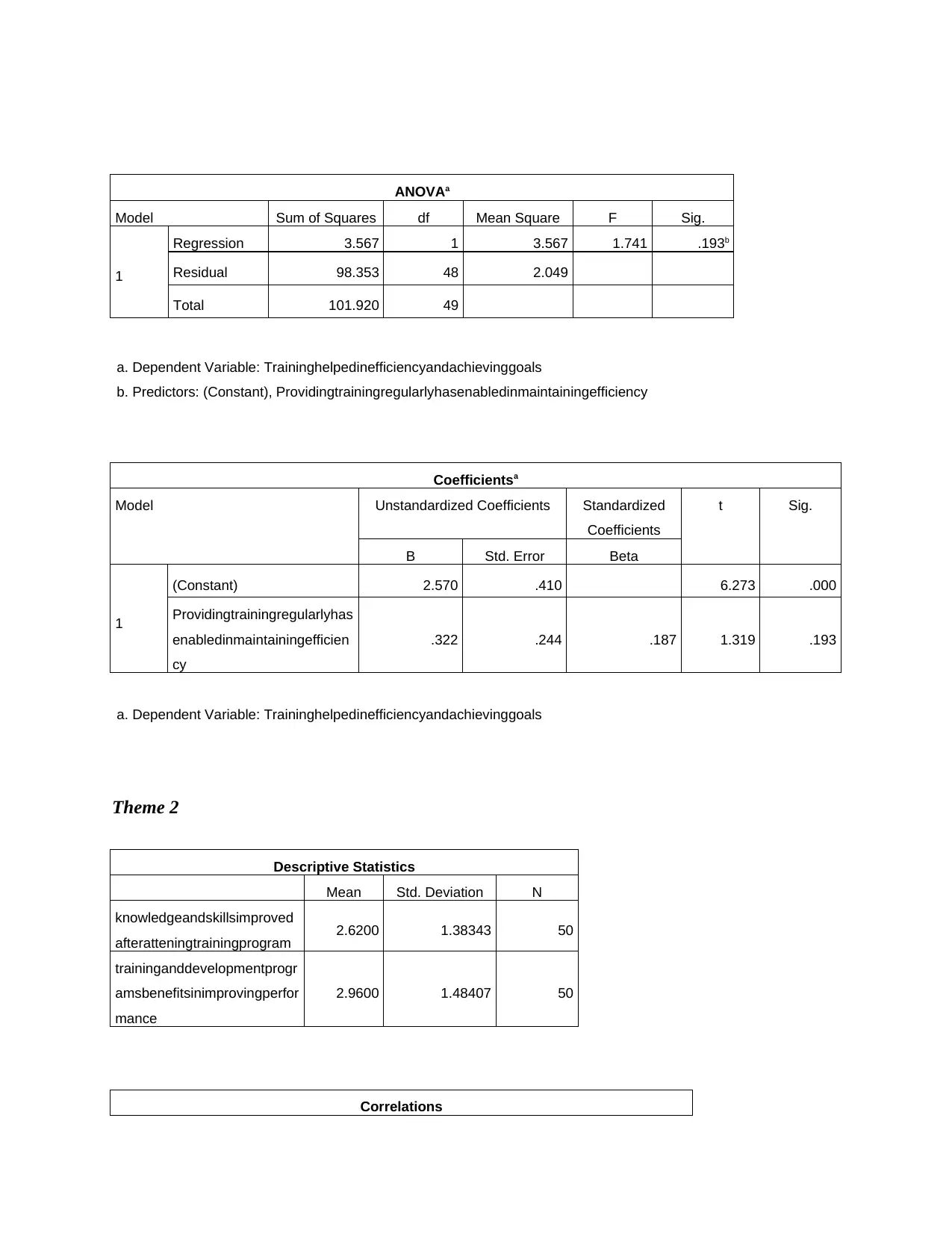
ANOVAa
Model Sum of Squares df Mean Square F Sig.
1
Regression 3.567 1 3.567 1.741 .193b
Residual 98.353 48 2.049
Total 101.920 49
a. Dependent Variable: Traininghelpedinefficiencyandachievinggoals
b. Predictors: (Constant), Providingtrainingregularlyhasenabledinmaintainingefficiency
Coefficientsa
Model Unstandardized Coefficients Standardized
Coefficients
t Sig.
B Std. Error Beta
1
(Constant) 2.570 .410 6.273 .000
Providingtrainingregularlyhas
enabledinmaintainingefficien
cy
.322 .244 .187 1.319 .193
a. Dependent Variable: Traininghelpedinefficiencyandachievinggoals
Theme 2
Descriptive Statistics
Mean Std. Deviation N
knowledgeandskillsimproved
afteratteningtrainingprogram 2.6200 1.38343 50
traininganddevelopmentprogr
amsbenefitsinimprovingperfor
mance
2.9600 1.48407 50
Correlations
Model Sum of Squares df Mean Square F Sig.
1
Regression 3.567 1 3.567 1.741 .193b
Residual 98.353 48 2.049
Total 101.920 49
a. Dependent Variable: Traininghelpedinefficiencyandachievinggoals
b. Predictors: (Constant), Providingtrainingregularlyhasenabledinmaintainingefficiency
Coefficientsa
Model Unstandardized Coefficients Standardized
Coefficients
t Sig.
B Std. Error Beta
1
(Constant) 2.570 .410 6.273 .000
Providingtrainingregularlyhas
enabledinmaintainingefficien
cy
.322 .244 .187 1.319 .193
a. Dependent Variable: Traininghelpedinefficiencyandachievinggoals
Theme 2
Descriptive Statistics
Mean Std. Deviation N
knowledgeandskillsimproved
afteratteningtrainingprogram 2.6200 1.38343 50
traininganddevelopmentprogr
amsbenefitsinimprovingperfor
mance
2.9600 1.48407 50
Correlations
Paraphrase This Document
Need a fresh take? Get an instant paraphrase of this document with our AI Paraphraser
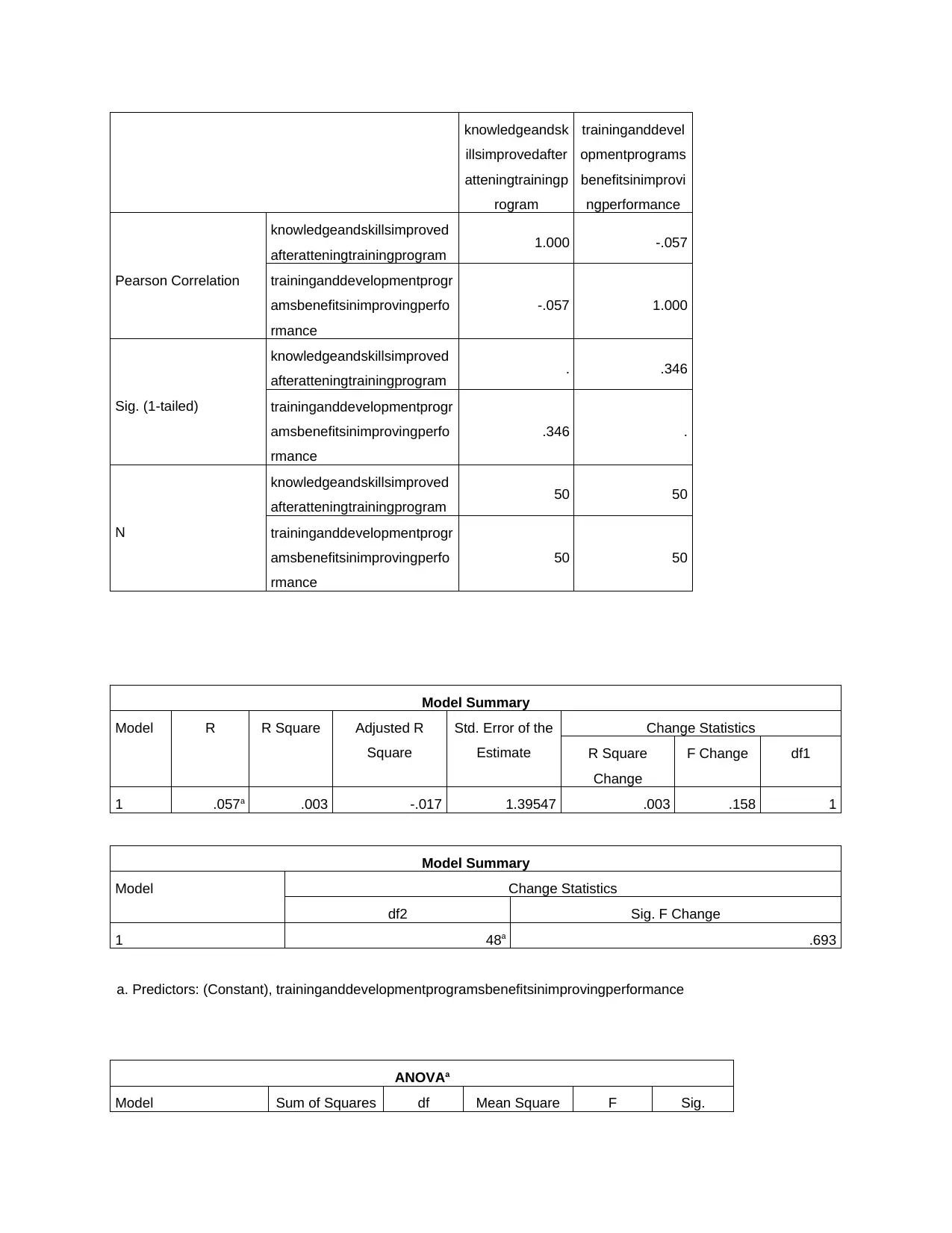
knowledgeandsk
illsimprovedafter
atteningtrainingp
rogram
traininganddevel
opmentprograms
benefitsinimprovi
ngperformance
Pearson Correlation
knowledgeandskillsimproved
afteratteningtrainingprogram 1.000 -.057
traininganddevelopmentprogr
amsbenefitsinimprovingperfo
rmance
-.057 1.000
Sig. (1-tailed)
knowledgeandskillsimproved
afteratteningtrainingprogram . .346
traininganddevelopmentprogr
amsbenefitsinimprovingperfo
rmance
.346 .
N
knowledgeandskillsimproved
afteratteningtrainingprogram 50 50
traininganddevelopmentprogr
amsbenefitsinimprovingperfo
rmance
50 50
Model Summary
Model R R Square Adjusted R
Square
Std. Error of the
Estimate
Change Statistics
R Square
Change
F Change df1
1 .057a .003 -.017 1.39547 .003 .158 1
Model Summary
Model Change Statistics
df2 Sig. F Change
1 48a .693
a. Predictors: (Constant), traininganddevelopmentprogramsbenefitsinimprovingperformance
ANOVAa
Model Sum of Squares df Mean Square F Sig.
illsimprovedafter
atteningtrainingp
rogram
traininganddevel
opmentprograms
benefitsinimprovi
ngperformance
Pearson Correlation
knowledgeandskillsimproved
afteratteningtrainingprogram 1.000 -.057
traininganddevelopmentprogr
amsbenefitsinimprovingperfo
rmance
-.057 1.000
Sig. (1-tailed)
knowledgeandskillsimproved
afteratteningtrainingprogram . .346
traininganddevelopmentprogr
amsbenefitsinimprovingperfo
rmance
.346 .
N
knowledgeandskillsimproved
afteratteningtrainingprogram 50 50
traininganddevelopmentprogr
amsbenefitsinimprovingperfo
rmance
50 50
Model Summary
Model R R Square Adjusted R
Square
Std. Error of the
Estimate
Change Statistics
R Square
Change
F Change df1
1 .057a .003 -.017 1.39547 .003 .158 1
Model Summary
Model Change Statistics
df2 Sig. F Change
1 48a .693
a. Predictors: (Constant), traininganddevelopmentprogramsbenefitsinimprovingperformance
ANOVAa
Model Sum of Squares df Mean Square F Sig.
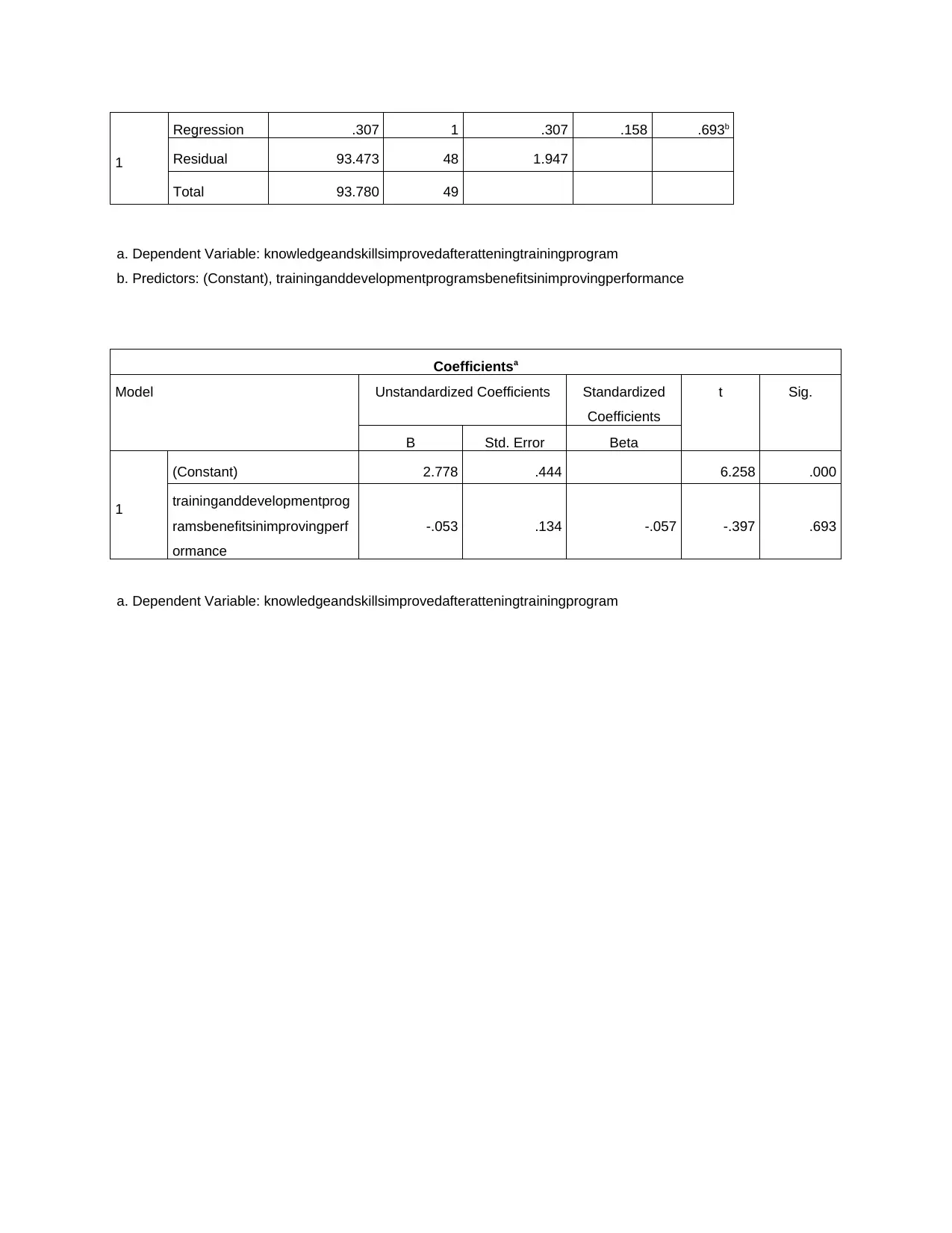
1
Regression .307 1 .307 .158 .693b
Residual 93.473 48 1.947
Total 93.780 49
a. Dependent Variable: knowledgeandskillsimprovedafteratteningtrainingprogram
b. Predictors: (Constant), traininganddevelopmentprogramsbenefitsinimprovingperformance
Coefficientsa
Model Unstandardized Coefficients Standardized
Coefficients
t Sig.
B Std. Error Beta
1
(Constant) 2.778 .444 6.258 .000
traininganddevelopmentprog
ramsbenefitsinimprovingperf
ormance
-.053 .134 -.057 -.397 .693
a. Dependent Variable: knowledgeandskillsimprovedafteratteningtrainingprogram
Regression .307 1 .307 .158 .693b
Residual 93.473 48 1.947
Total 93.780 49
a. Dependent Variable: knowledgeandskillsimprovedafteratteningtrainingprogram
b. Predictors: (Constant), traininganddevelopmentprogramsbenefitsinimprovingperformance
Coefficientsa
Model Unstandardized Coefficients Standardized
Coefficients
t Sig.
B Std. Error Beta
1
(Constant) 2.778 .444 6.258 .000
traininganddevelopmentprog
ramsbenefitsinimprovingperf
ormance
-.053 .134 -.057 -.397 .693
a. Dependent Variable: knowledgeandskillsimprovedafteratteningtrainingprogram
1 out of 69
Related Documents
Your All-in-One AI-Powered Toolkit for Academic Success.
+13062052269
info@desklib.com
Available 24*7 on WhatsApp / Email
![[object Object]](/_next/static/media/star-bottom.7253800d.svg)
Unlock your academic potential
© 2024 | Zucol Services PVT LTD | All rights reserved.





